Captivating the Audience
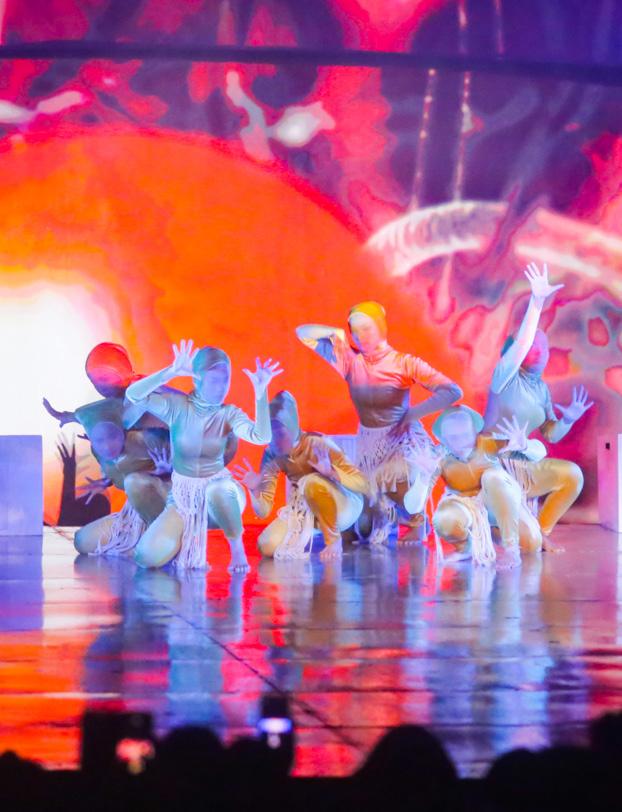
When Traditional Music Makes a Spectacle at Lake Toba
Accumulating Cultural Actions for Sustainable Living Sandeq Boat Knowledge Transmission and Character Education
VOLUME 9 772406 806005 ISSN 2406-8063 15 THE CHARMS OF INDONESIAN CULTURE
2022
Indonesia Bertutur
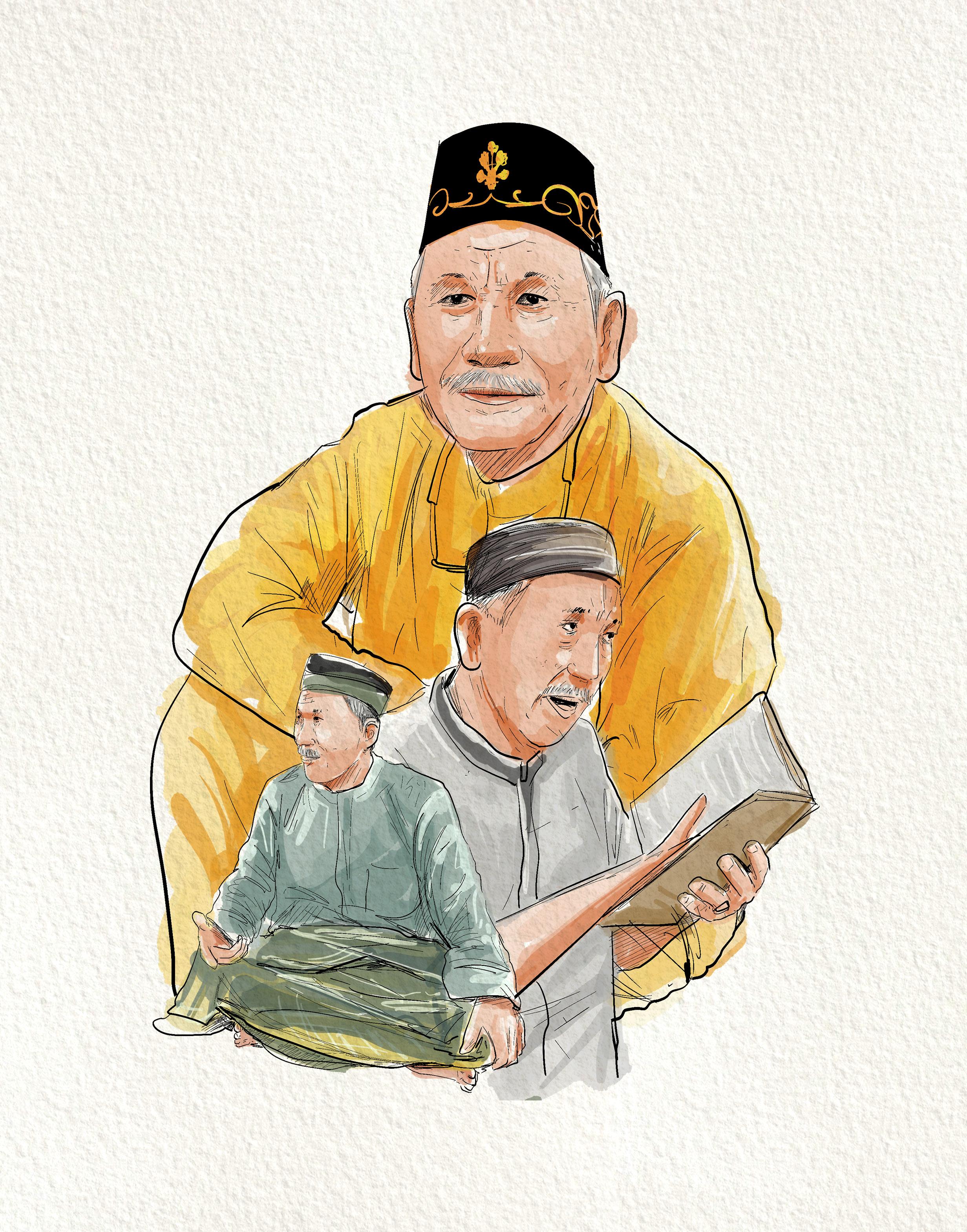 Muhammad Ali bin Achmad (Ali Pon)
courtesy of Zul Lubis Zul Lubis
RESTU GUNAWAN Director of Cultural Development and Utilization Directorate General of Culture
Muhammad Ali bin Achmad (Ali Pon)
courtesy of Zul Lubis Zul Lubis
RESTU GUNAWAN Director of Cultural Development and Utilization Directorate General of Culture
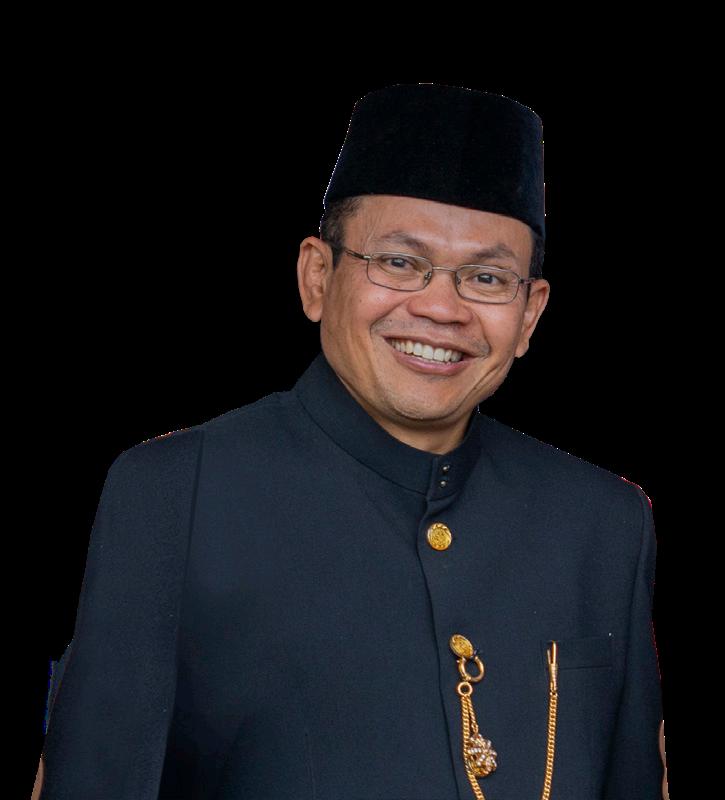
Praise be to God, the Almighty, who made it possible for us to present Volume 15 of the Indonesiana Magazine to our dear readers at the end of 2022. Motivated by the appreciation and enthusiasm of loyal readers of Indonesiana Magazine, the Editorial Team doubled-down their effort to deliver the best publication possible. This year, the Indonesiana Magazine is bilingual, in Indonesian and English. We hope that the Indonesiana Magazine will become a medium for cultural diplomacy that introduces and shares information on the rich culture of various regions in Indonesia.
This year has been a proud year for us, for Indonesia holds the G20 Presidency to host the event. Indonesia promoted the spirit of “Recover Together, Recover Stronger” by implementing relevant activities, one of which is a series of cultural activities by the Directorate General of Culture, Ministry of Education, Culture, Research, and Technology. The Cultural Events section expresses the spirit of culture through articles on
Indonesia Bertutur/InTur (‘Indonesia Tells Stories’ Festival), Festival Musik Tradisi Indonesia-FMTI (Indonesia Traditional Music Festival), and Collective Culture
Actions for Sustainable Living. The section also tells cultural stories from various regions of Indonesia. It ranges from Sandeq boat, part of the Gerakan Bangga Buatan Indonesia—GBBI (Proud of Indonesian Products National Movement), Revitalizing the North Maluku Regional Language, Awaken the Dragon in Glodok Chinatown, to Cisitu Leuweung Hejo Customary Forest of Ngejo Community.
We organize cultural programs based on the Objects of Cultural Advancement, including traditions, rituals, traditional ceremonies, performing arts, knowledge, and cultural celebrations. Not only that they carry practical functions, but they also contain values related to the human life cycle. The appreciation we received from various countries on the artistic presentations and cultural performances during the G20 series of activities should motivate us to continue
to develop, utilize, protect, preserve, and promote our culture to everyone. As we bid welcome to 2023, we hope that the condition of the cultural sector in Indonesia will continue to improve so that we can promote and introduce more cultural values to the broader society at home and abroad.
Various culture stories of the Archipelago that are written and illustrated in Indonesiana Magazine Volume 15 are proof. They are proof of the commitment of the Directorate General of Culture, Ministry of Education, Culture, Research, and Technology, through a program managed by the Directorate of Cultural Development and Utilization in carrying out cultural missions conforming to the Law on the Advancement of Culture Number 5 of 2017. We hope this publication will inspire our readers, especially Indonesians, to contribute to the continuous advancement of culture, appreciate the works of different regions in Indonesia, and keep on maintaining the flame of culture.
VOL. 15, 2022 INDONESIANA I 1 FOREWORD
THE CHARMS OF INDONESIAN CULTURE
KILAU BUDAYA INDONESIA
Advisor HILMAR FARID
Pengarah HILMAR FARID
Project Director
RESTU GUNAWAN
Direktur Jenderal Kebudayaan
Managing Director
YAYUK SRI BUDI RAHAYU
Penanggung Jawab
RESTU GUNAWA N
Editor in Chief SUSI IVVATY
Direktur Pengembangan dan Pemanfaatan Kebudayaa n
Executive Editor
SINATRIYO DANUHADININGRAT
Content Editor
ALFIAN SIAGIAN
Koordinator Umum & Pemimpin Redaks i BINSAR SIMANULLANG
Language Editor
MARTIN SURYAJAYA
Greetings
Redaktur Pelaksan a SUSI IVVAT Y
Photo Editor SYEFRI LUWIS
Secretary
Redaktur Naska h MARTIN SURYAJAYA
JESSIKA NADYA OGESVELTRY
Design and Layout
ALFIAN S. SIAGIAN
ZUL LUBIS
Proofreaders
PRIMA ARDIANI
ANNISA MAYASARI
Redaktur Fot o SYEFRI LUWIS
Translator
DWI ANGGOROWATI INDRASARI
Tata Letak
WIESKE OCTAVIANI SAPARDAN
Contributors RENNY AMELIA SUSANTI
Fotografe r
PRITA WIKANTYASNING ANGGORO CAHYADI
JESSIKA NADYA OGESVELTRY
THAMRIN JUNAIDI NADAPDAP
YUDHI WISNU ARYAND I
Administration AHMAD ZUNITA
Sekretariat
As we near the end of 2022, the COVID-19 pandemic has not subsided; the nation and its citizens are again worried about the scourge of a reported new variant. However, after suffering and hardships, we are better prepared to face it, especially since vaccines are readily available. During the G20 Presidency, Indonesia raised the theme “Recover Together, Recover Stronger” and gathered the world leaders in Bali in September 2022. The culture ministers’ meeting in Borobudur themed “Culture for Sustainable Living” also brought great hope for culture. We witnessed the grassroots involvement in the declaration of the Borobudur Mandate (Amanat Borobudur). Discover more in Indonesiana Magazine Vol. 15.
POKJA PENGEMBANGAN DIREKTORAT PPK
E. CHRISTISIA MELATI PUTRI SORAYA AIDID
Distribution RACHMAT GUNAWAN
HERY MANURUNG
BAYU HARDIAN
YUDHI WISNU ARYANDI
Ministry of Education, Culture, Research, and Technology Republic of Indonesia

Kementerian Pendidikan, Kebudayaan, Riset, dan Teknologi Republik Indonesi a
Directorate General of Culture
Directorate of Culture Development and Ultilization
Direktorat Pengembangan dan Pemanfaatan Kebudayaan
The Indonesiana Magazine truly exists to ignite and promote cultural works in various fields and at different levels across all regions of the Archipelago. The Indonesiana Vol. 15 features sections of fascinating articles by writers and researchers who are experts in their fields. The Main Topic continues to feature the elements inscribed on UNESCO’s Intangible Cultural Heritage (ICH) lists and focuses on Saman dance, Pantun (joint nomination with Malaysia), and Keris. We have not covered the three elements in previous volumes.
Gedung E . Lt. 9 , Jl. Jenderal Sudirman Kav. 4-5 Senayan, Jakarta 10270
Building E. Lt. 9, Jl. Jenderal Sudirman Kav. 4-5 Senayan, Jakarta 10270
(021) 5725534
(021) 5725534
(021) 5725534
indonesiana.diversity@gmail.com
http://kebudayaan.kemdikbud.go.id
(021) 5725534 indonesiana.diversity@gmail.com http://kebudayaan.kemdikbud.go.i d
Indonesiana Magazine aims at promoting Indonesian Culture and is not for sale.
Majalah Indonesiana bertujuan untuk promosi budaya Indonesia, dan tidak diperjualbelikan. Komentar atas artikel, foto dan lain-lain ditujukan kepada: indonesiana.diversity@gmail.co m
Comments of articles, Photographs etc, can be send to: indonesiana.diversity@gmail.com
Front Cover:
Gaya bertenaga buruh pabrik genteng Jatisura (foto: Pandu Rahadian )
Storytelling through Body Movements –Irnie Wanda
Sampul belakang: Penari Caci dan kain Songke. (foto: Dodi Sandradi)
Back Cover:
A fisherman on Sandeq sailing the open sea –Muhammad Ridwan Alimuddin
The Cultural News section covers articles related to activities of the Directorate General of Culture, such as the Indonesia Traditional Music Festival (Festival Musik Tradisi Indonesia), Indonesia Tells Stories (Indonesia Bertutur), and the G20 Cultural Ministers Meeting. Objects of Advancement of Culture explained in Law Number 5 of 2017 are told from interesting perspectives, such as the traditional Sandeq boat of the Mandar of West Sulawesi, a traditional knowledge still preserved today. The Indonesian Textile features Ulap Doyo, beautiful hand-woven textiles of the Dayak Benuaq of East Kalimantan. What else? Want to know more? Flip through the pages of this magazine to discover.
Quoting Richard Schechner (2002), this world is no longer a book for us to read but a performance to involve in. That’s the delight of participating in culture as we are not (supposed to be) just spectators, but actors, as we define Indonesian culture. Wouldn’t the world be better off? Happy reading!
Editor in chief
2 I INDONESIANA VOL. 15, 2022
2 INDONESIANA VOL. 10, 2021
VOLUME
Sampul depan:
2021 2 I INDONESIANA VOL. 15 2022 VOLUME
14
HILMAR FARID Director General of Culture Ministry of Education, Culture, Research, and Technology Repulic of Indonesia

Culture for Sustainable Living
Challenges facing our world today: pandemics, interstate and intrastate armed conflicts, the threat of terrorism and extremism, responsibility-sharing for refugees and displaced persons, and natural disasters. Resolving these serious challenges would require tremendous attention and energy. There is more than one way to solve all development problems. We often look for a silver bullet, a single solution for all issues, which only would create more problems than solve them. We should address development challenges in different geographical contexts by strengthening existing local potential instead of a panacea to implement anytime and anywhere. Addressing diverse issues would require the diversity of methods or, better yet, diversity as the method.
That way of thinking leads us to culture. Other cultures influence every culture in the world. Cultural diversity is not an obstacle to development; Cultural diversity forms the basis of sustainable development. Only by taking cultural diversity, culture, and context seriously can we establish regional harmony while maintaining national identity and simultaneously fostering a sense of togetherness that unites regional communities.
Culture knows no administrative boundaries because culture existed before the modern political structure and administrative boundary. The hybridization, borrowing, and adoption of cultural elements between groups across national borders is a historical fact. We also recognize the contemporary challenges and complexity of managing cultural diversity, such as climate change, migration, rapid population growth, food insecurity, land degradation, war, terror, conflict, and inequality. Culture and nature are complementary, inseparable, and interdependent, which are crucial to addressing those challenges. Creating an enabling environment is imperative to protect the diversity of cultural expressions. What we need today is the preservation of cultural heritage, conservation and sustainable use of natural resources, community participation, and the protection and promotion of cultural diversity and natural ecosystems that contribute to their well-being in both local and global contexts.
By utilizing the wealth of local potential in each country, there are examples of how endogenous resources stimulate sustainable development. The focus should be on strengthening the cultural ecosystem of society: safeguarding
traditional knowledge and practices and the surrounding natural environment that inspires them, creating democratic innovations with a touch of technology, and driving local economic growth through the development of utilization networks. To overcome social inequality, we need to strengthen the role of women and youths in initiatives to promote local cultures. Their pioneering work of local wisdom-based conservation and innovation will strengthen a healthy and fair knowledge production ecosystem and enhance equal access to local resources. In this respect, cultural diversity is our way of finding solutions to everyday problems.
I therefore warmly welcome the publication of Indonesiana Magazine Volume 15, published right after Indonesia successfully held the G20 Culture Ministers Meeting with the key message of “Culture for Sustainable Living.” I hope it will inspire the readers to cultivate the potential of local culture in seeking answers to today’s global challenges.
VOL. 15, 2022 INDONESIANA I 3 FOREWORD
TRADITIONAL
TRADITIONAL


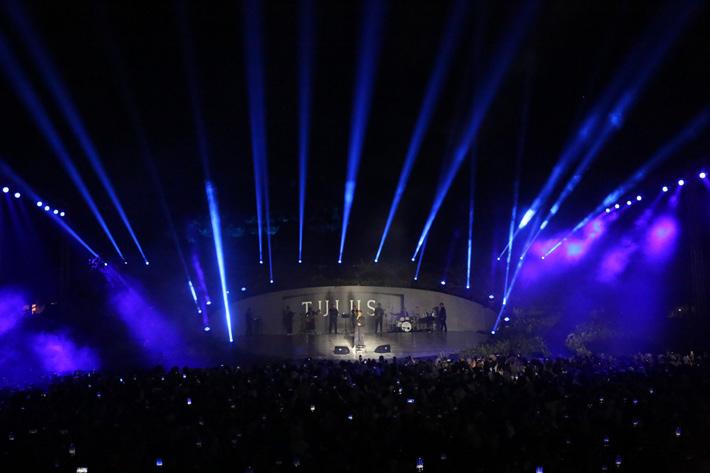


4 I INDONESIANA VOL. 15, 2022 CONTENTS FOREWORD
WEAVEN
FEATURES CULTURAL EVENTS 1 Director for Culture Development and Ultilization, Directorate, General of Culture 2 Editors 48 Ulap Doyo Weaving The Wisdom of Dayak Benuaq Tribe 52 Sandeq Boat Knowledge Transmission and Character Education 56 NYOBENG The Thank Offering of Dayak Bidayuh 60 Revitalizing the North Maluku Local Language Ngom Ua Nage Ana Adi 6 Quo Vadis Acehnese Saman 12 One Pantun Two Nations 21 Indonesia Bertutur Captivating the Audience 16 The Culture of Kris, Simplified 26 Village-Based Cultural Advancement and Empowerment 30 Accumulating Cultural Actions for Sustainable Living 44 Komik Tradisi (Kepercayaan dan Masyarakat Adat) Dit. Kepercayaan terhadap Tuhan YME dan Masyarakat Adat COMICSTRIP INFOGRAPHIC 46 Nomenclature of Regional Offices for Cultural Preservation 3 Director General of Culture Ministry of Education, Culture, Research, and Technology Repulic of Indonesia 36 When Traditional Music Makes a Spectacle at Lake Toba 40 Promoting Objects of Advancement of Culture Collaboration between Local Government and Communities
KNOWLEDGE RITES LANGUAGES MAIN
WORLD HERITAGE
64 Updates from the Ombilin Coal Mining Heritage

VERNACULAR ARCHITETCURE
68 Rumah Tuo Kampai Nan Panjang Past Lessons for the Future
PERFORMING ART
72 Miss Tjitjih Approaching the 95 Anniversary of Sundanese Theatre th
TRADITIONAL CUISINE
76 A Sweet Taste of Kipo, a Bite of Memories
CULTURAL PROPERTY
80 Batanghari River The Veins of Civilization
CUSTOMARIES
84 Cisitu Customary Forest Sustainable Forest, Prosperous Community
HISTORY
88 Awaken the Dragon in Glodok Chinatown
MUSEUM
92 Using Wayang Beber to Spread Messages

PERSONAGE
96 Melati Suryodarmo: From Indonesia to the World
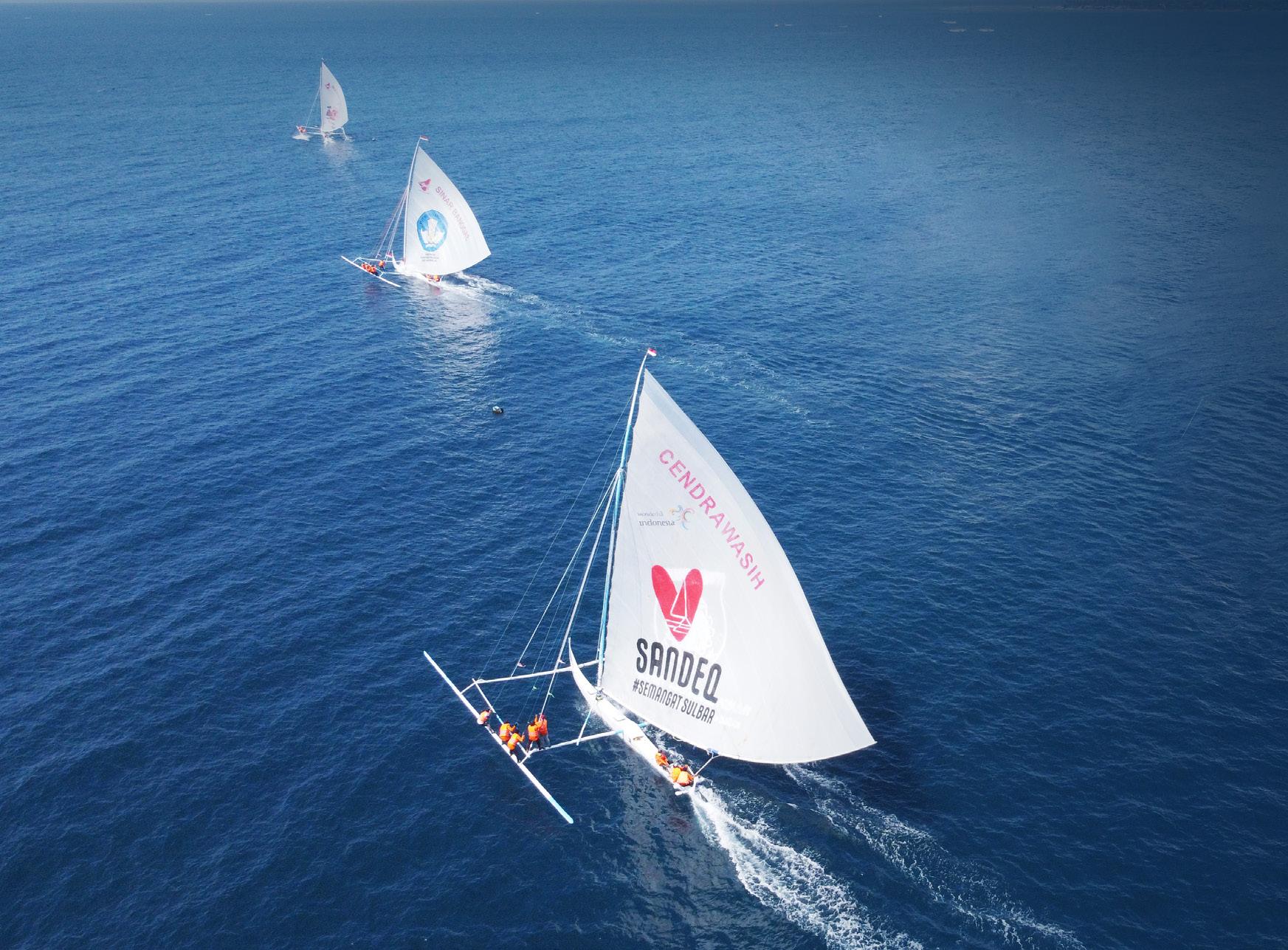
PORTRAITS GALLERY
102 Maluku Village Opening Ritual Celebrating Patriotism, Renewing Ourselves

VOL. 15, 2022 INDONESIANA I 5
ACEHNESE SAMAN Quo Vadis

6 I INDONESIANA VOL. 15, 2022
MAIN FEATURES
The totality of dancers lift the spirits
Since the inscription of the Saman dance of Aceh on UNESCO’s List of Intangible Cultural Heritage (ICH) on 24 November 2011, the people of Indonesia and Acehnese have had high hopes. Around 400 participants from 137 countries attended the inscription announcement of the Saman dance of Aceh by the session of UNESCO in Nusa Dua, Bali. We consider the inscription a mandate, trust, and challenge.
When people see the live performance of the Saman dance, the dancers’ movement, harmony, accuracy, and speed amaze many. The people of Indonesia and Aceh, the birthplace of this “head-shaking” dance, highly valued the dance. Saman dance is everyone’s
favorite. People perform it from smallscale events at schools or villages to grand government ceremonies at the national level. The Saman dancers can dance on any occasion. They can perform at the opening of a formal or non-formal event, reception of guests, festivals, or even at the closing of any event. People favor Saman dance, which can perform regardless of time and place. However, the philosophical meaning of the dance has eroded.
When the Saman dance gained popularity at the national and international levels, especially after the Aceh peace process, fundamental problems unraveled. The origin of the Saman dance, the composition of the movements, and the lyrics of the poems (songs) in the dance remain unanswerable questions. Instead of speaking of its

development to date, people are debating the history of the Saman dance using their respective references to strengthen their arguments.
Questioning the Origin
We hear Sheikh Saman started and introduced the Saman dance, but the detailed biography of this figure is unknown. Several sources say—although there must be evidence from previous studies—that Syekh Saman came to Aceh and spread the teachings of his tariqa with poetry and zikr movements. However, various contemporary sources, both books and online media, only mention the name of Syekh Saman came from Medina to Aceh in the 18th century AD. That is it with no more information.
Snouck Hurgronje mentions in his book “De Atjehers” that Saman originates from outside traditions that permeate the dance traditions of the Acehnese people. We believe that the Samaniyah
VOL. 15, 2022 INDONESIANA I 7
Photo courtesy of Rizky Fadly
(sammaniyyah) tariqa, having roots in Madinah, adopted and developed the Saman dance. Indonesian Muslims subsequently favored the religious tradition. However, there is no information on how the Saman dance spread to remote areas and integrated with the highland culture from the Saman or Samaniyah tariqa place of origin in the coastal region of Aceh.
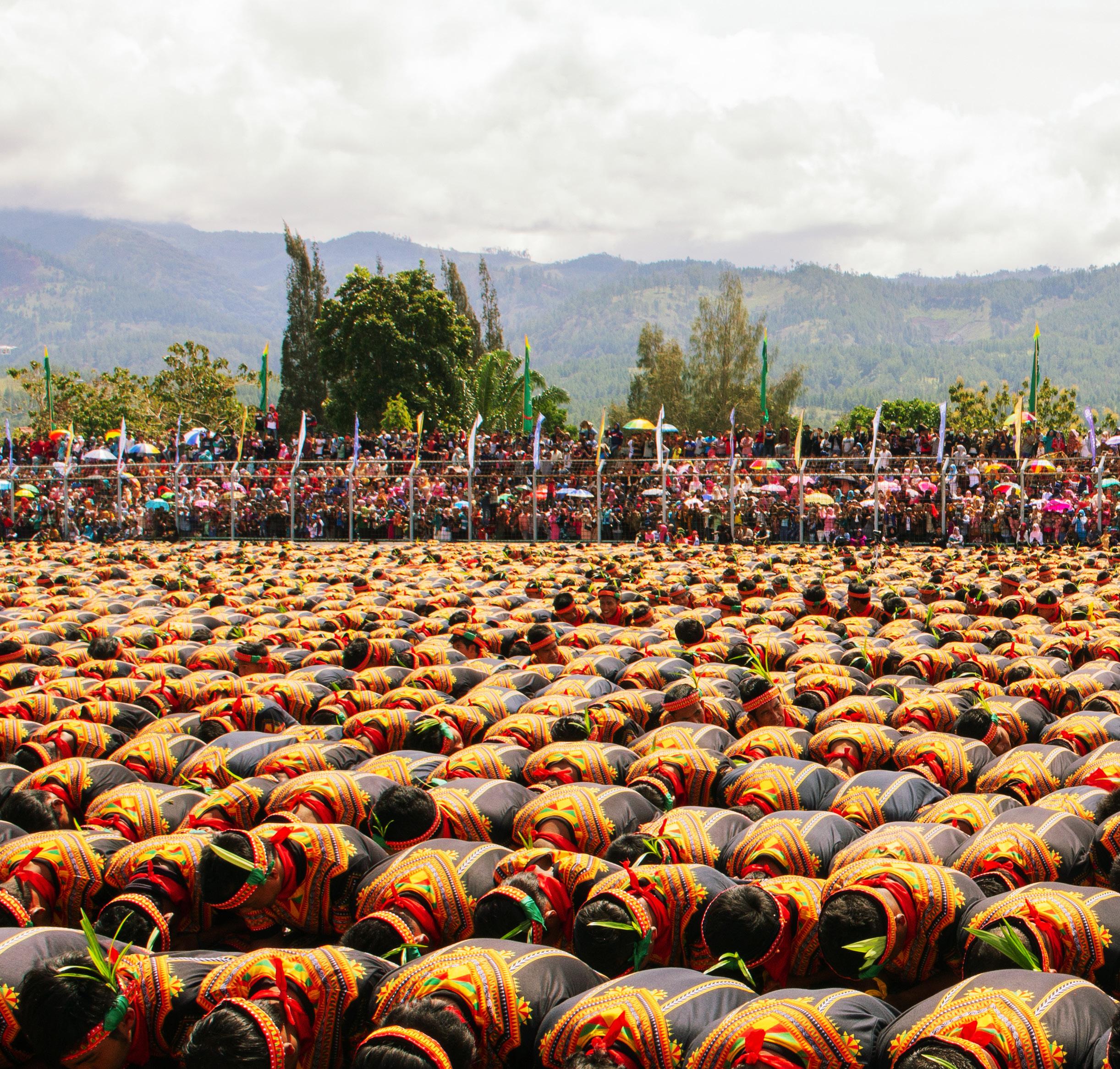
It is also worth noting that we regard the Samaniyah tariqa as the creator of the Saman dance. Sheikh Muhammad
bin Abdul Karim al-Samani al-Hasani al-Madani (1718-1775) was the initiator of the dance before it spread to several regions, including Morocco, Sudan, Egypt, and Indonesia. Then, the muktarabah tariqa, particularly the Samaniyah tariqa, flourished in Aceh.
Although there are no comprehensive research on how the tariqa spread in Aceh, we found out about prominent figures known as muridin (followers) and propagators of the Saman tariqa, such as Sheikh Muhammad Saman, a disciple of
Sheikh Marhaban and Muhammad Saleh. The prominent figures and Teungku Chik Di Tiro are all contemporaries during the war fights between the people of Aceh and the Dutch; Syekh Saman is also related to Commander Chik Di Tiro.
So, is it true that propagators of the Samaniyah tariqa are the creator of the Saman dance? Do Sheikh Saman and other tariqa propagators conceive the idea of the Saman dance, or is it one creation of the Samaniyah tariqa’s followers? We should add that these
8 I INDONESIANA VOL. 15, 2022
Saman is different from Ratoh Jaroe
figures lived and came from the northern coastal area of Aceh, not from the highlands and interior regions.
While we have not resolved the historical issues on the origin and spread of the Saman dance in Aceh, other problems arise, such as the right to claim and status of the Saman dance that is said to belong to a particular region in Aceh. Criticism emerged from other parties who thought they were more entitled to the ownership rights of the Saman dance. Problems arose when the Saman dance

spread across regions throughout Aceh, penetrating the ethnic groups and native tribes of Aceh. Saman dance eventually spread throughout Aceh, although each ethnic group wondered about the originality and authenticity of the dance. From the new variation, poetry, or lyric to the number of dancers becomes a “classic” issue when we talk about the Saman dance performance until today.
The debate on the Saman dance also extends to the innovative performances of Saman at the local, national, and
international stages. For example, we should limit the number of dancers, as it shouldn’t be a mass dance. Some artists consider the mass Saman dance a breakthrough, a contemporary innovation. However, the “conservative” group thinks this innovation has diverged from the rules and pillars of the Saman dance.
Female Saman Dancer
The “hot” and engaging issue about Saman dance is the subject of female dancers. This discussion interests artists,
VOL. 15, 2022 INDONESIANA I 9 Image source: https://www.shutterstock.com/ image-photo/aceh-indonesia-august-13-2017-10001-1658244697
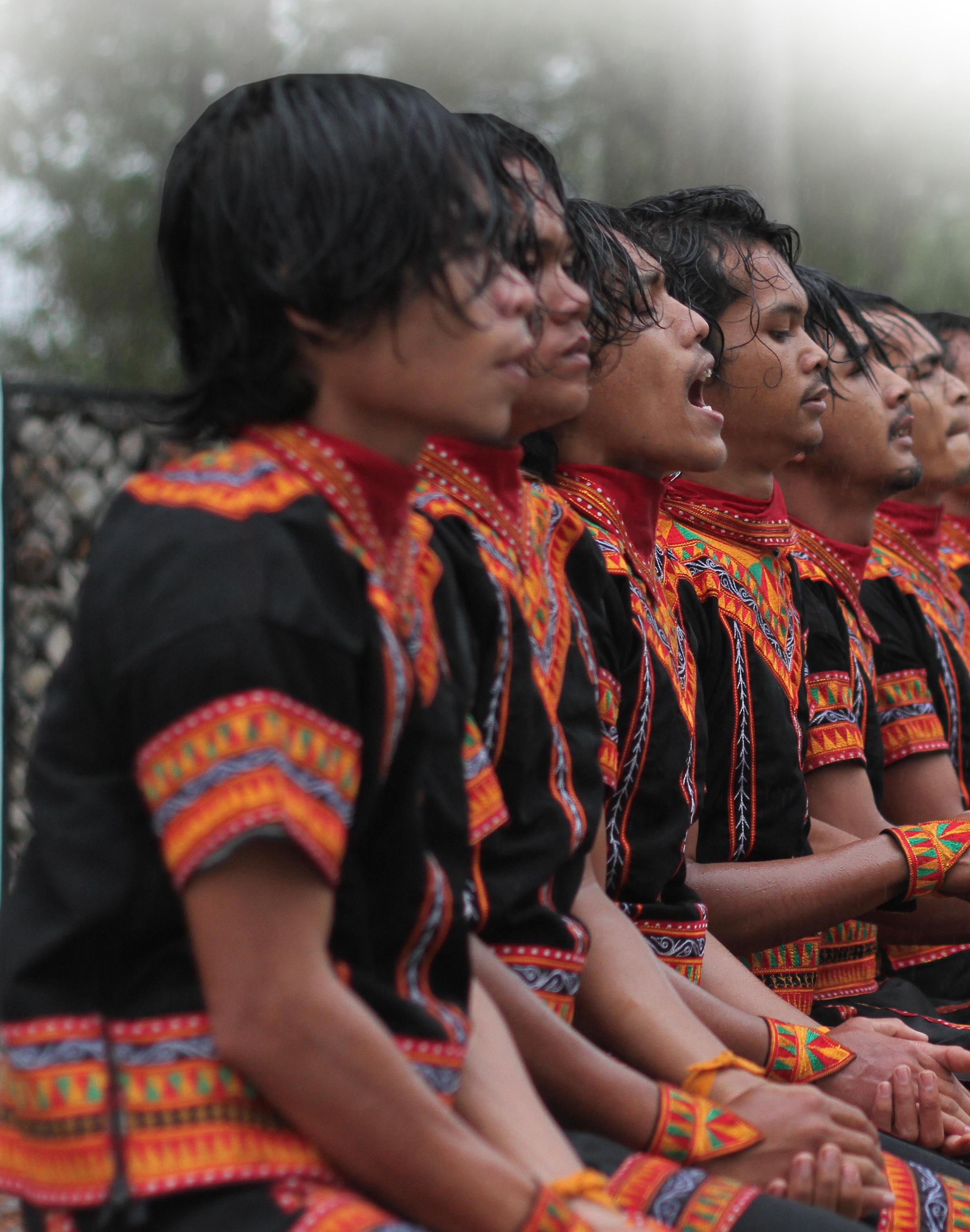
10 I INDONESIANA VOL. 15, 2022
Saman mencari maestro -
observers, and scholars, which has become a topic of debate, especially when we juxtapose our discussions and writings with Islamic law on the code of behavior in man-woman interactions, except for girls who have not yet hit puberty.
The dance movements of the female dancers no longer follow the standard Saman. Therefore, some artists call it the ratoeh jaroe (hand movement) dance, a new term in Acehnese dance because of the dominance of women in dance performances. The goal is not to compete and argue but to strengthen the art of this dance of rapid movements. So far, the artists agree only men perform the Saman dance, so if women perform a similar dance, the names will be different, including the ratoeh jaroe
Searching for a Maestro
Another issue to solve concerns the “syekh” role or the maestro of the Saman dance and the transmission of the maestro’s knowledge through a sustainable heritage education program. Maestro is the narrator or storyteller of Saman who performs on national and international stages. The maestro must understand and tell the meaning and philosophical values of the Saman dance and its lyrics, which will affect the strengthening of Saman education in various regions. However, the maestro is almost non-existent nowadays.
Two peas in a pod, the Saman dance education, and its development program is the responsibility of the Aceh government, especially the district/ city offices in charge of education and culture, although in vain. There is no local content curriculum for the Saman dance in Aceh schools. It is strange and ironic. We must safeguard the Saman dance as an intangible cultural heritage for humanity from becoming extinct, which encourages other people to promote other forms of dance arts from dying and becoming obsolete.
Now, Saman dance belongs to the world. Therefore, let the people of Aceh safeguard the collective memories of the Saman. Every 24 November, following the inscription of the Saman dance on UNESCO’s Lists of ICH, we should continue celebrating. The government and people of Aceh need to revive the philosophical values of the Saman dance, such as speed, accuracy, cohesiveness, togetherness, respect, tolerance, and cooperation, which are the characteristics of the Acehnese.
(Hermansyah, UIN Ar-Raniry academic and Acehnese philologist)

VOL. 15, 2022 INDONESIANA I 11 Getting on and being in harmony
Photo courtesy of Rizky Fadly
Two Nations One Pantun
When we talk about global culture, we should tear down all primordial barriers. According to the United Nations, the world’s population has reached 8 billion, and in the 21st century there is almost no culture in a place that does not intertwine with other cultures. When we discuss Malay culture, for example, we will look at groups of people who inhabit the Malay Peninsula, eastern Sumatra, southern Thailand, the southern coast of Burma, and coastal Borneo including Brunei, West Kalimantan, Sarawak and Sabah.
The ancient Malays have migrated and spread to the archipelago since 2,500 BC and the Malay identity has transformed into Indonesian Malay, Malaysian Malay, and others, as stated by lecturer and researcher of Malay dance, Julianti Parani, in Indonesian Performing Arts: A Political Culture (2011). There is a cultural origin that once unified and then developed into the identity of each country. In the past, Malay had migrated and assimilated across the archipelago and Southeast Asia and as far as to Taiwan, Zanzibar and Australia.
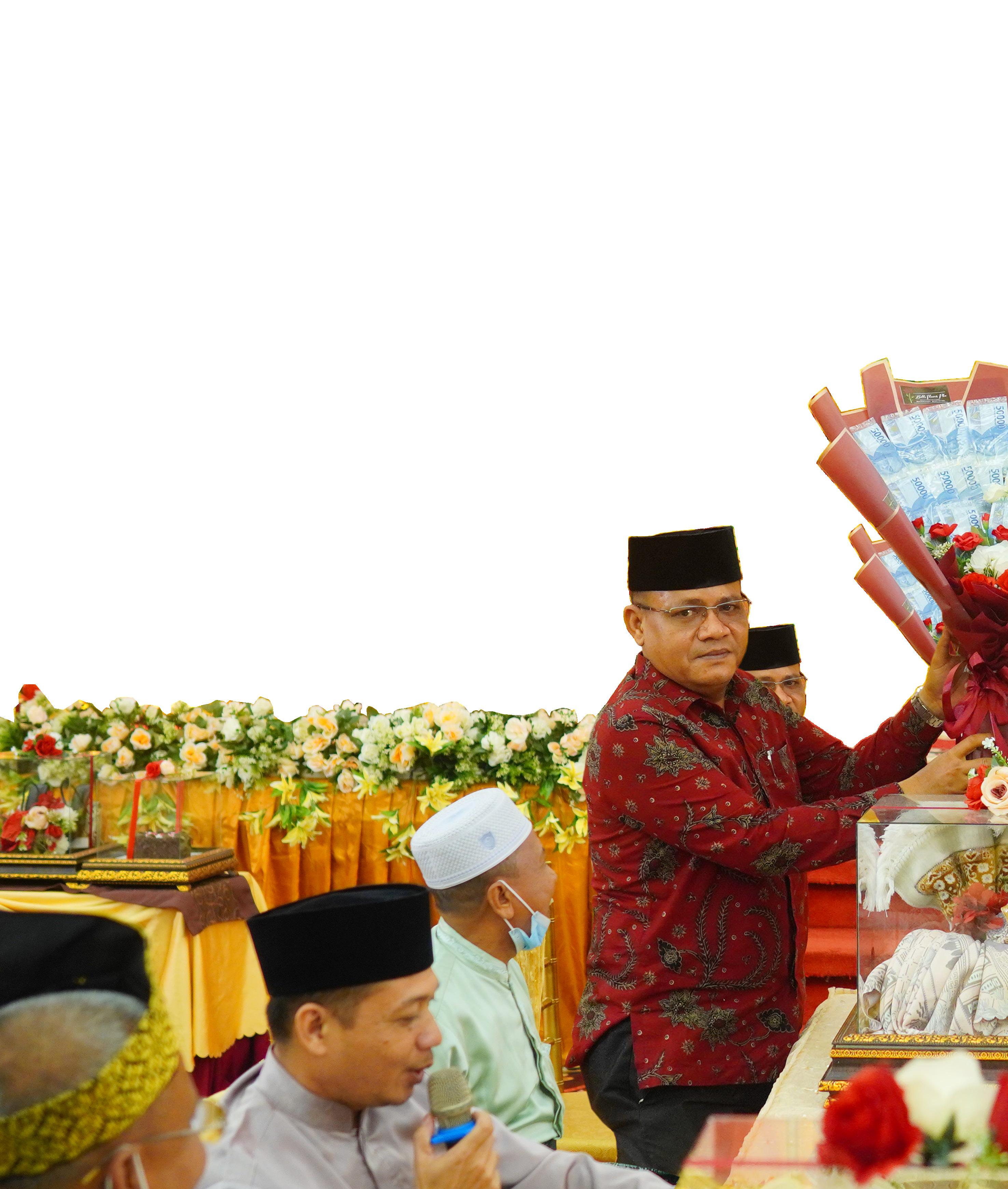
12 I INDONESIANA VOL. 15, 2022
MAIN FEATURES
When we discuss pantun, more specifically Malay pantun, it is not possible to associate this cultural heritage to Indonesia only. In fact, the Malayness in Malaysia, Singapore and Brunei can be said to be more apparent since Malays are understood as a race with wide ethnicity variables (Islamic religion, customs and language), in contrast to Malays in Indonesia which only refers to one ethnicity. Therefore, the joint nomination by Indonesia and Malaysia for inscription of pantun onto the UNESCO list of Intangible Cultural Heritage (ICH) made sense.
Proposing pantun to UNESCO for its inscription on the Representative List of the ICH of Humanity on 17 December 2020 at the ICH Intergovernmental Committee sessions in France and Jamaica was quite long. Looking back, the Association of Oral Traditions (ATL) together with the Malay Traditional Institute (LAM) submitted pantun to the Ministry of Education and Culture through the Directorate General of Culture in 2016, and on 7-29 September 2016 a preliminary meeting was held to propose pantun as ICH to UNESCO. After the presentation of the academic text on 3 November 2016, feedback was received, among which there was no explanation to anticipate possible claims by Malaysia which also uses the Malay language. In response to this feedback, proposing pantun as a multinational nomination with other Malay countries was considered more appropriate. However, since Singapore,
Brunei Darussalam and Thailand were apparently not ready, the joint nomination for pantun was proposed only by Indonesia and Malaysia.
The decision to jointly nominate pantun was met with some rejection, because Indonesia felt it had more rights. However, the facts show pantun is still used by the Malay, the Bajau, the Ida’an, the Kedayan, and the Baba Nyonya communities in Malaysia. As for Indonesia, pantun is not only known in Riau Province and the Riau Islands, but has spread to Lampung through the kias tradition, also in Minangkabau society, on to Betawi through palang pintu and rancak performances and to South Kalimantan, Manado and Ambon.
In its development, the joint nomination for ICH has become a more convenient and reasonable choice, for its technical and ideological reasons. According to the Chairperson of ATL, Pudentia MPSS,

VOL. 15, 2022 INDONESIANA I 13
Reciprocating Pantun on the day of betrothal
Photo courtesy of Fatma Adnan
UNESCO also encourages multinational nomination by two or more countries that have intertwined cultural histories. Besides pantun, Singapore, Malaysia, Brunei Darussalam and Thailand recently nominated kebaya to UNESCO ICH lists.
The Allusions in Pantun
Pantun as we know today is an oral tradition passed down from generation to generation in Malay society. British linguist and orientalist, William Marsden, in his book The History of Sumatra (1783), states that the characteristic of Malay pantun is highly allusive, and the allusions are in fact the spirit of this oral tradition. Meanwhile, linguist Charles Adrian van Opuijsen said that pantun has the same position as the early poetry genre, because pantun was also present in the early life of the Indonesian people. According to Malay language expert, Richard James Wilkinson, pantun uses hidden words, which rhyme, or pattern of the sounds is suggestive to the listener.
Pantun was presented in religioussacred events in the past. Pantun was then developed and used in communal spaces such as in rituals and traditional ceremonies, which, together with gurindam and petatah-petitih, were able to enliven traditional events and became
the stage for mastery of the figurative language of the Malay people until now. Furthermore, pantun also entered the popular area, in the form of aesthetic expressions such as song lyrics, and expression of feelings in everyday interactions between individuals.
In the academic text of pantun, which was submitted to UNESCO, some examples on the use of pantun in daily life of the Riau community were included. For example, the traditional ceremony of babalian (from Rantau Kuantan), bulian (from Talang Mamak), belian (from Petalangan), bedewo or mambang dewo-dewo (from Bonai), tu-un jin or buang lancang (from Penipahan), buang talam (from Bengkalis), bedikei (from Sakai), dan upah-upah (from Rokan).

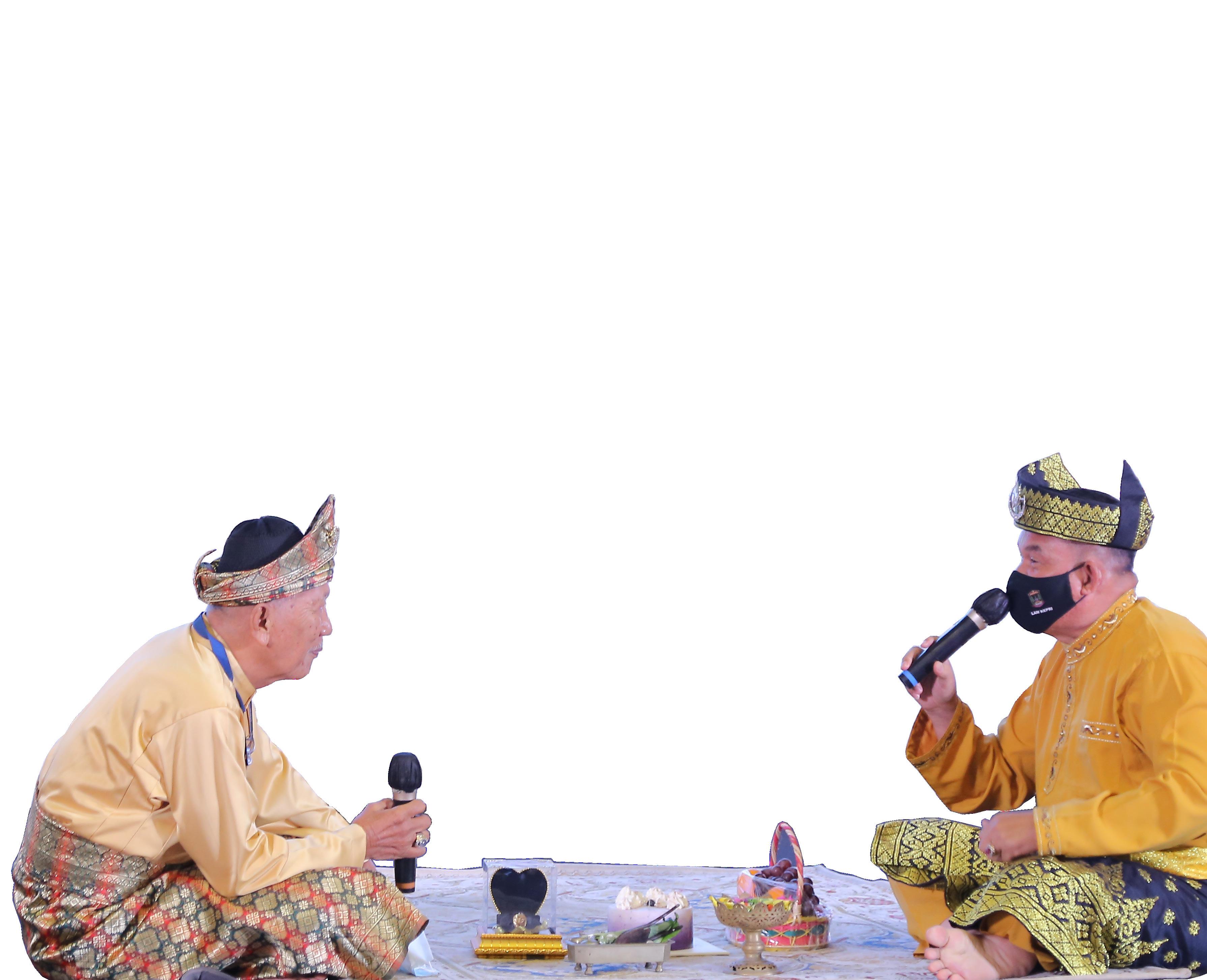
Pantun in communal events is used in economic activities such as menggetah kuaran (in the Kuantan and Kampar areas), batobo (in Kampar, Rantau Kuantan, and Tiga Lorong), menumbai, mengayun enau, timang padi, and catching fish. Pantun is also used in life cycle ceremonies and performing arts. We are familiar with zapin (from coastal and inland areas), gambus batandang (from Talang Mamak), kayat, randai (from Rantau Kuantan), koba (from Rokan), timang onduo (from Rokan/Bonai), nandung (from Indragiri), badondong and basiacuong (from Kampar), gaden (from Bengkalis), olang-olang (from Sakai), and many others.
Researcher of pantun, Rendra Setyadiharja quoting a pantun by Haji Ibrahim in his book Old Malay Pantuns (1877) which contains metaphors or symbolic meanings (Media Indonesia, 20/22/2022):
Buah berembang hanyut ke lubuk
Anak undan meniti batang
Kalbu abang terlalu mabuk
Menentang bulan di pagar Bintang
Berembang fruit drifting to the bottom
Undan bird walks through the trunk
Love bug struck my heart
Against the moon challenged by stars
14 I INDONESIANA VOL. 15, 2022
The word moon represents a time or atmosphere and has meanings related to destiny and the future and can also symbolize a romantic atmosphere between two people. This pantun may tell about a young man who has romantic feelings but cannot show his feelings, marked by a love bug that struck my heart.
We can see that sampiran (foreshadowing verses) in pantun may not just be a decorative word to sweeten the rhymes, but also plays a role in conveying the meaning of the rhyme. Sampiran may be used to describe local wisdom, and from the sampiran alone we can find out
how events, history, culture, traditions or customs took place. In essence, pantun upholds various lifeways of the Malay people.


This is the reason why when we hear the type of “pantun for fruits” (pantun with the names of the fruits), it feels like the meaning of the pantun becomes distorted, for as long as it rhymes. For example, “Mango, pomegranate, if my sister is miserable, even my brother will suffer,” or “Pineapple, guava, my heart is boiled seeing her being seduced.” If you look at the positive side, “pantun with fruit names” can be a way of learning, yet it’s not easy to produce words with attractive diction.
When you think about it, it is not easy to create pantun, let alone do it spontaneously. It is hard. Therefore, a continuous learning process is needed, one of which is by safeguarding traditional ceremonies, life cycle celebrations, and other performing arts by practicing pantun. The inscription of pantun on UNESCO ICH list, jointly nominated by Indonesia and Malaysia, should be able to make the safeguarding of pantun easier, because it shall be done by “two parties”. One pantun belongs to two countries.
(Susi Ivvaty, Indonesiana).
VOL. 15, 2022 INDONESIANA I 15
Pantun buka pintu (welcoming remarks) from representatives of the groom and bride families
Photo courtesy of Fatma Adnan
Delivering the groom with Pantun
Delivering pantun at the handover ceremony of ICH-UNESCO certificate of Pantun
Photo courtesy of Directorate of Cultural Development and Utilization
VOL. 15, 2022 I 15
MAIN FEATURES
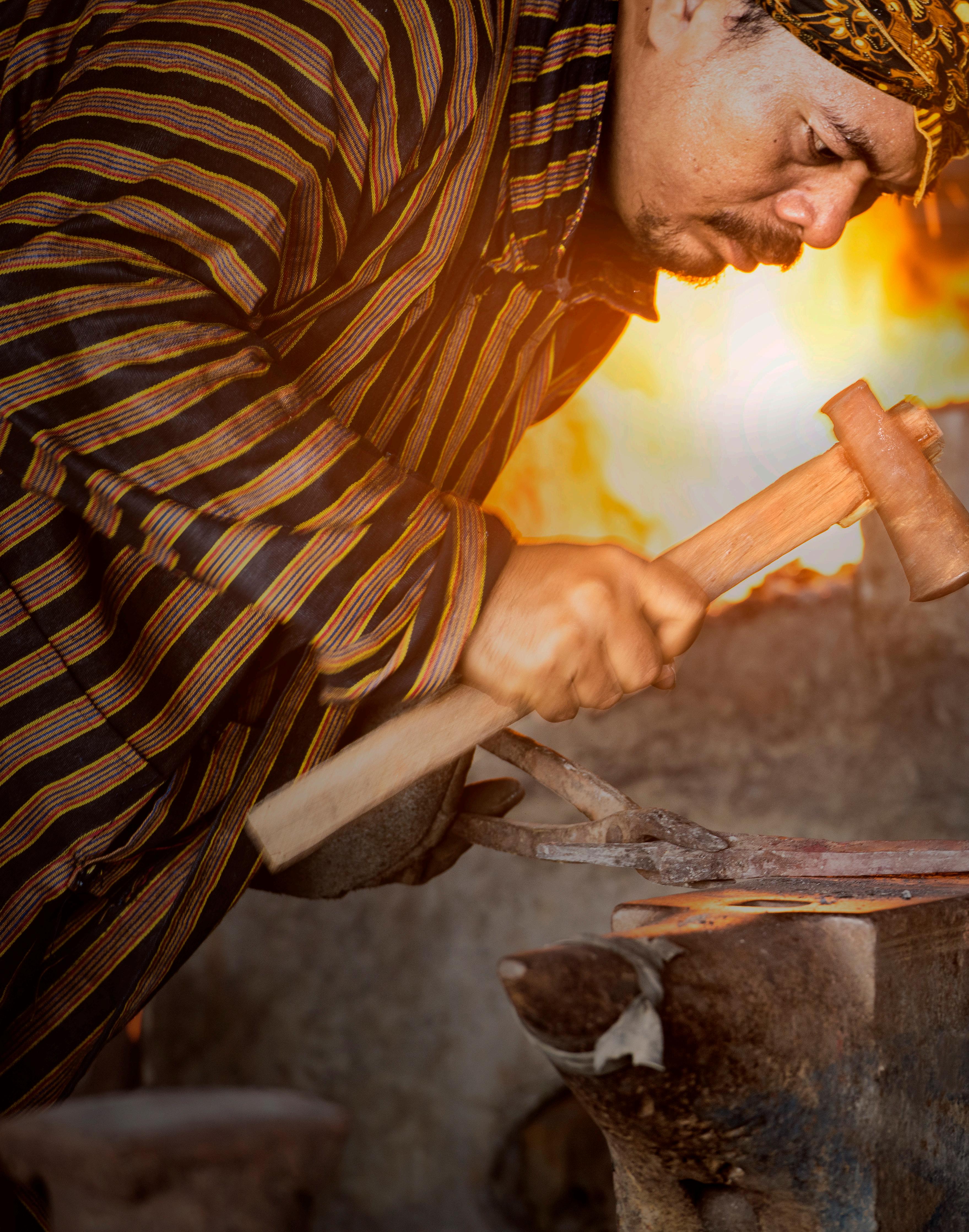
Kris, The Culture Of Simplified 16 I INDONESIANA VOL. 15, 2022
AKris (keris) is originally a dagger used as a thrusting or stabbing weapon, which comprises two main parts, the blade (bilah) and the blade base (ganja) that represent the lingga and the yoni, symbols associated with fertility, eternal life, and strength.
Kris has a beautiful, asymmetrical (straight or wavy (luk)) shape, forged out of two, three, or more metals, according to Bambang Hasrinuksmo in Ensiklopedi Keris (2008) and Haryono Guritno in Keris Jawa Antara Mistik dan Nalar (2006). But eventually, Kris transcends its mere technomical function as a weapon into emphasizing its philosophical values and life philosophy of Indonesian people. In Indonesian culture, Kris is present in all milestones in life, from birth to death.
Kris is a means to remind and keep us mindful of our creator (God Almighty). Therefore, Kris often becomes an essential component in religious rituals and ceremonies.
Kris, stemming from Indonesian culture and local genius, originated in Java in the 8th century and subsequently spread to nearly the entire archipelago, as mentioned by Mubirman in his book Keris Senjata Pusaka (1980) and by Hamzuri in Keris (1993). According to Kris experts, such as Bambang Hasrinukso, Haryono Guritno, and Darmosugito, Kris has even spread to Malaysia, Singapore, Brunei Darussalam, Thailand, Myanmar, and the Philippines. Kris spreads through trades,
wars, marriages, and political relations, giving birth to diverse forms, patterns, and styles that reflect the characteristics of the host community, enriching the Kris world’s repertoire.
Kris culture today
Kris is a cultural heritage under the domain of traditional craftsmanship. Not only about making the blade, but Kris-making is also about making the sheath, the hilt, pendok, selud, singep, blawong, and Kris’s other sculptured or chiseled features (perabot) as well. We can find Kris makers evenly spread over various regions in Indonesia. Some time ago, Madura, Surakarta, and Yogyakarta were the centers of Kris-making. Today, Kris-making in Java is also expanding to Surabaya, Malang, Tulungagung, Madiun, Magetan, Karanganyar, Kendal, Banyumas, Jepara, Kota Gede, Bantul, Gunung Kidul, Bandung, and Bogor. Kris making also spreads to Sopeng, Bone, and Mandar (Sulawesi), later to Tabanan, Klungkung, Karangasem, Gianyar, and Badung (Bali), as well as Central Lombok, West Lombok, and East Lombok (Lombok). In Kalimantan, we can find production centers mainly in East Kalimantan and West Kalimantan. Also, we can meet prominent artisans of Kris in West Sumatra, Riau, Palembang, and Jambi.
Kris-making affects the growth of traditional ceremonies in which Kris

continues to be present. Life cycle ceremonies such as seven months of pregnancy (mitoni), earth stepping (tedak siten), circumcision, marriage, village alms, communal feast, to cultural carnivals requiring a Kris. What’s interesting today, the use of Kris in traditional and modern clothing is becoming increasingly popular.
The government collaborates with the community and stakeholders proportionally to accomplish the various action plans in the Kris nomination proposal to UNESCO, referring to the strategic steps in Law no. 5 of 2017 on the Advancement of Culture.
These strategic steps include:
1. The government established the Indonesian National Kris Secretariat (SNKI) as a forum for Indonesia’s Kris enthusiasts through the MoEC’s Research and Development Center after the inscription of Kris on UNESCO’s List. Today, SNKI has grown into a sizeable organization with over 200 arts and culture studios/ associations as members in almost all parts of Indonesia. SNKI is engaged in various activities, such as research, advocacy, publication, and education. SNKI is also involved in reports on the conservation of Kris culture in international fora and promotes Kris abroad.
Image source: https://www.freepik.com/premium-photo/asian-blacksmith-forging-molten-metal-with-hammer-make-keris VOL. 15, 2022 INDONESIANA I 17
Forged in fire
2. The government established a Kris study program at the Indonesian Institute of the Arts Surakarta (ISI Surakarta) as a strategic step towards “krisology” through formal education. The Kris study program is a government mandate and has been part of the Indonesian Institute of the Arts Surakarta since 2012 and has given birth to many qualified 4-year diploma graduates in Kris. The Kris Study Program Alumni have high expertise in the making, conserving, and curating of traditional Indonesian Kris and weapons.
3. The government’s MoECRT established the Museum Keris Nusantara in Surakarta. The government equips the museum with an extensive collection of Kris from various regions of Indonesia, an audiovisual room, a forging workshop, and a conservation room.
4. Since 2021, the Directorate of Cultural Human Resource and Cultural Institutions Empowerment and SNKI have been partners. The collaboration creates a standard for the Kris profession and meets the demand for skilled professionals. There are 29 schemes in the Kris field, which refer to aspects of Kris-making, curatorial, and conservation.
5. Exhibitions, exchanges, and workshops as educational and promotional media have a good impact on the growth of the creative economy in the Kris field because of the collaboration between academia, studios/associations, museums, and the government. ISI Surakarta, Jogjakarta International Heritage
Festival (JIHF) started the Kris Festival, Heritage Carnival in Ponorogo Regency, Kyai Tengoro Kris Carnival (Surakarta Keris Museum), and Tulungagung Kris Fest.

Challenges
Traditional cultural works are full of meaning and value, which require creative transformation to meet today’s challenges. However, we must attempt to preserve the essence and values so that the cultural heritage revives in cultural advancement. Increasingly advanced modern technology has put the world in our hands. All knowledge and information are in the gadget. The number one challenge is passing it on to the millennial generation. We have passed the Kris culture down from generation to generation for hundreds of years (from the 8th century). Because of the strong influence of foreign culture and changes in lifestyle and needs in the modern era, everything has become practical, fast, and instant. So, we need to transmit the wisdom of the Kris cultural heritage in a way the millennial generation understands. The second challenge is the rise of Kris as a medium of fraud. Limited education, lack of qualified curators, and many distortions to Kris’s wisdom often place Kris as a fraudulent medium. People rarely understand supernatural beliefs and practices involving mysticism, spirituality, and magic. It makes them victims of
fraud. Some people believe in spiritual things, but they need to be equipped with an in-depth understanding and position the knowledge proportionally. Apart from that, the rise of newly made Krises that give the impression of being oldfashioned has become part of the trading commodity, which makes people reluctant to own a Kris. The third challenge is managing the Kris market share as a creative economy. A market share that extends to foreign countries provides promising economic opportunities. Unfortunately, the management is not good, so there is often overlap. The proliferation of monopolies by several parties has further widened the gap among those actively involved in Kris culture. The fourth challenge is weak
curatorial.
Qualified curatorial is falling behind the growth of Kris’s culture. The impact is that it often triggers
18 I INDONESIANA VOL. 15, 2022
Photo courtesy of Basuki Teguh Yuwono
disputes and has the potential for biased understanding. Therefore, we urgently require curatorial certification to have competent curators.
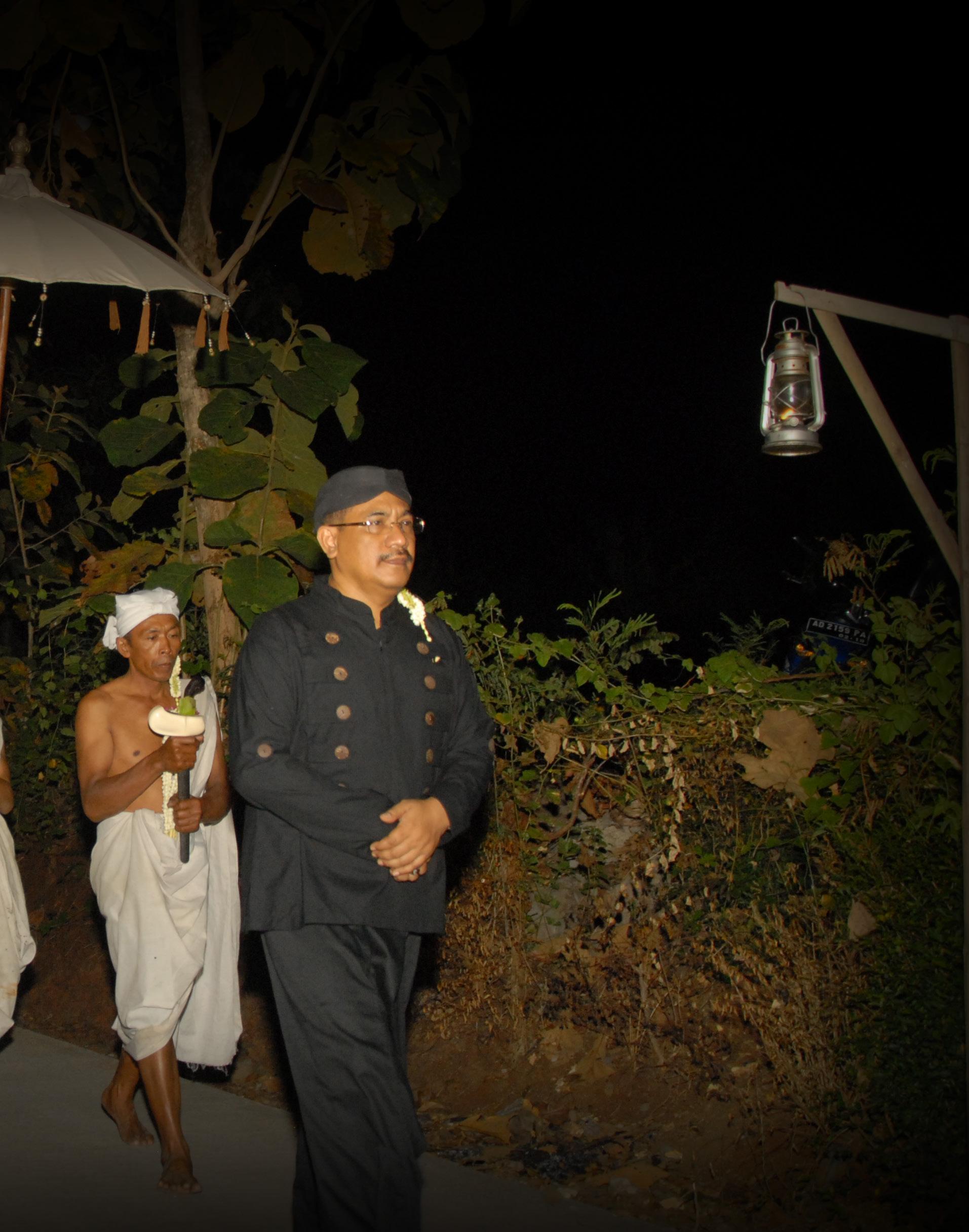
The fifth challenge is the uneven distribution of the Kris ecosystem preservation. Based on observation, we noticed uneven distribution of Kris’s growth in its ecosystem. Because we have not managed various fields relevant to Kris properly, they will become a weak link and threaten Kris’s cultural sustainability. We also lack, for example, knowledge transmission on panjak or forging, wood materials for the hilt, makers of chiseled features on Kris,

conservators, and curators. Other than the customs and clothing where we present the significance of the Kris, we also need to preserve the spirit and values of Kris rather than treat it as a mere decorative object. The key to a favored cultural heritage is a well-preserved ecosystem, simplified core values, and creativity that stems from its roots. We urgently need a proportional divide of responsibilities among the government, community, and all stakeholders. Our heritage, our nation’s glory.
 (Basuki Teguh Yuwono, Head of Surakarta Keris Museum and Lecturer at ISI Surakarta)
Purify to preserve Some of the museum Kris collections
(Basuki Teguh Yuwono, Head of Surakarta Keris Museum and Lecturer at ISI Surakarta)
Purify to preserve Some of the museum Kris collections
VOL. 15, 2022 INDONESIANA I 19
Photo courtesy of Syefri Luwis
Indonesia Bertutur Captivating the Audience

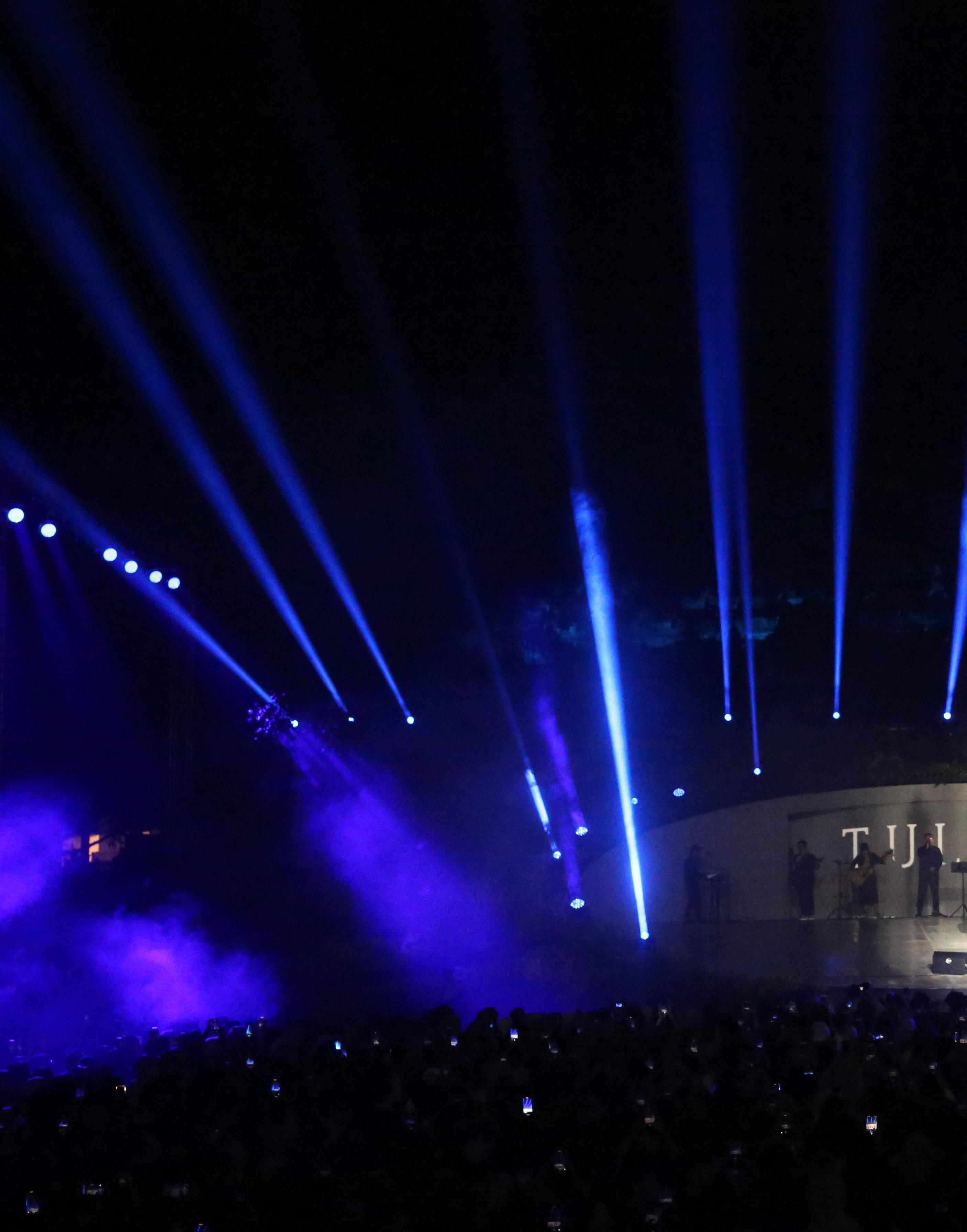
The ‘Indonesia Bertutur-InTur’ (Indonesia Tells Stories) Festival is one of the side events of G20 Culture Ministers Meeting which was held on 7-11 September 2022 at the Borobudur Temple Compound in Magelang, Central Java. Indonesia Bertutur carried the theme “Experience the Past, Growing the Future”, with the hope that people could interpret past events or history in new ways that are relevant to the present. The main objective of Indonesia Bertutur Festival was to promote a sustainable culture through activities that are educational, inspirational and full of experiences. Many artists from Indonesia and abroad participated and presented their works through performing arts, films, and new media arts within the context of cultural heritage narratives that are adapted to the current context.

CULTURAL EVENTS
Beberapa koleksi
20 I INDONESIANA VOL. 15, 2022
This festival was held across four art spaces around Borobudur Temple Compound, namely Virama, Anarta, Kiranamaya, and Visaraloka. At the Virama evening stage, music, dance, and storytelling were performed. There was also a culinary area at Virama that served a variety of traditional foods such as meatballs, dumplings, spring rolls, chicken noodles and herbs. The Anarta or the Lumbini stage featured a variety of contemporary music, dance and theater performances by groups that
have carried out a long experimental and collaborative process using modern technology in their work.
At Kiranamaya, there were video mapping and light installation works from various artists using interactive and architectural lighting technology. Visitors could get a special lighting experience at Borobudur at night similar to the light festival which can be enjoyed at the Aksobya stage. The Layarambha at Kiranamaya presented various kinds of dance-based feature


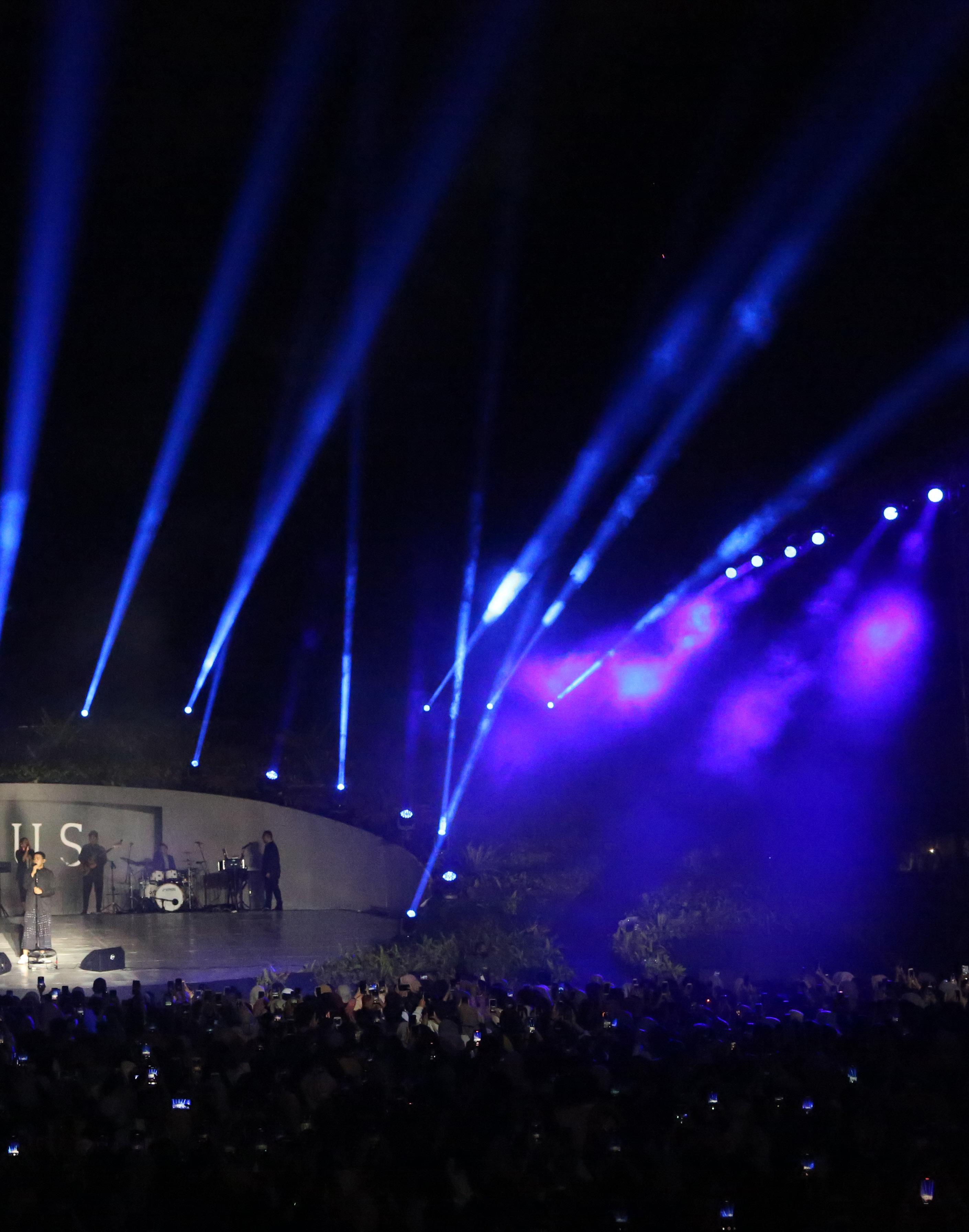
films and short films by artists from various countries, including Indonesia. Lastly, the Visaraloka stage featured an expanded media art exhibition.
The Art Festival
On the first day of Indonesia Bertutur, the atmosphere immediately became lively since the opening of the Visaraloka expanded media exhibition featuring epic works by expanded media and performing art artists, such as the painting exhibition at Eloprogo Art House
museum keris -
VOL. 15, 2022 INDONESIANA I 21
The dances performed at the Indonesia Bertutur Festival
by Sony Santosa and art installation by Gilang Anom. In addition to Visaraloka, there were four other locations for expanded media exhibitions, namely the Eloprogo Art House, Limanjawi Art House, H. Hidayat Museum, and Apel Watoe Art Gallery. One of the highlights of the exhibition was the work of Mella Jaarsma and Agus Ongge, which was exhibited at the H. Hidayat Museum, an installation of clothing made of bark cloth which was demonstrated by several models. It was as if we were transported to the time of ancient humans, especially since on the other side of this installation there was a video by Lisa Reihana entitled “In Pursuit
of Venus” which showcased how early humans lived at that time.
Indonesia Bertutur was inaugurated by the Director General of Culture of the Ministry of Education and Culture, Hilmar Farid, accompanied by the Director of Film, Music and Media, Ahmad Mahendra, and the Artistic Director of Indonesia Bertutur Melati Suryodarmo at the Lumbini Borobudur Temple stage area. The inauguration ceremony attracted the most attention. The Lumbini stage itself was already attractive with its white semi-circular shape decorated with plants on both sides of the stage and has
the majestic towering Borobudur Temple in the background. It was magnificent. Although it rained during the opening night, the audiences stayed to watch the art performance until the end.
The inauguration of Indonesia Bertutur started with a slametan ceremony with the participation of the community members from the Borobudur area and the cultural actors involved. This mass traditional slametan ceremony involved residents from 20 villages in the Borobudur District and included a mass mountain carnival and black mask dance performed at the Borobudur Temple courtyard. The

22 I INDONESIANA VOL. 15, 2022
The projection mapping artwork on Borobudur Temple by the artists
inauguration ceremony at the Lumbini stage began with the performance of the soreng dance, a traditional dance of Magelang. The dancers were full of expression and energy, the movement of their feet and hands symbolizes tenacity as life fighters from the slopes of the mountains. The performance of the black mask dance performed by the Lima Gunung Community closed the inauguration event.
The number of visitors increased in the Borobudur Temple area on the second day. The shows and performances were very diverse. There were: fairy tales
storytelling with Kak Aio/Ariyo Zidni (Founder of Ayo Dongeng Indonesia), Kak BudiBaikBudi – a storyteller who is also a ventriloquist, and Kak Hendra Hensem who brought humor in his storytelling; various forms of dance from local cultural art groups; and the performance from singers Ardhito Pramono and Peni Candrarini who created an uproar in the evening stage area, making the audience immersed in the atmosphere of the selected songs. No less exciting, the Layarambha at Kiranamaya featured a film discussion with Garin Nugroho, Razan Wirjosandjojo, Iphul Ashyari, and Iin Ainar Lawide followed by the
screening of the films “Anerca, Breath of Life”, “Lucy” and “Touching the Skin of Eeriness.” Various films were screened at Layarambha in the following days. The performance from singer Tulus was the most awaited performance which captivated some 7,000 audiences who waited patiently in the midst of a magical atmosphere in front of the stage which was adorned by colored lighting that made the atmosphere even more magnificent.
The Borobudur Temple in the background was highlighted with video mapping by artists, such as Rampages
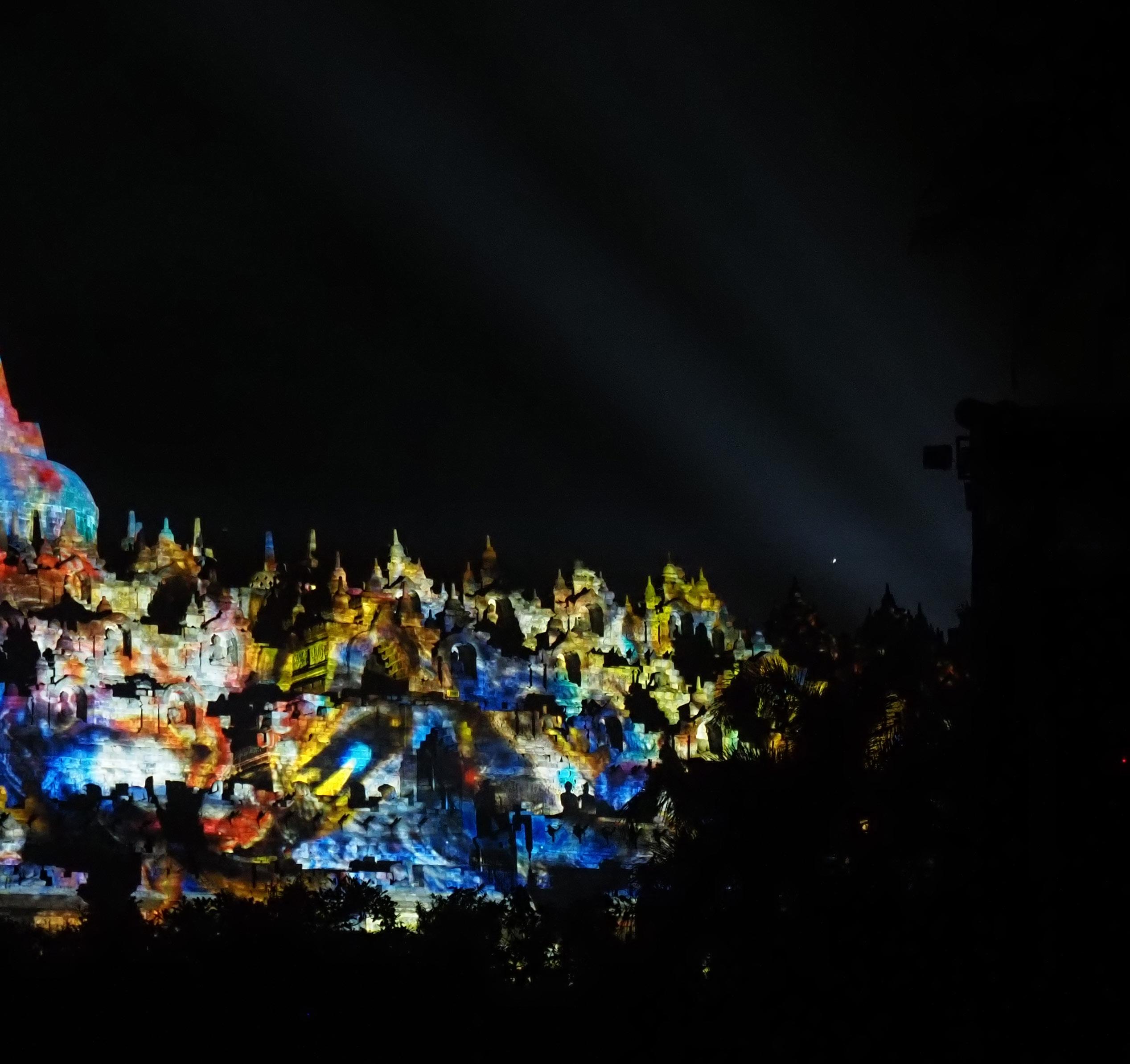
VOL. 15, 2022 INDONESIANA I 23
Production x Toopfire which featured projected mapping based on Indonesian traditional cultural stories. The content of the story is based on ancient spirituality, traditional knowledge, and symbols of national identity, depicting a joyful world of light and shadow with bright colors and vivid images. It includes elements of Balinese dance, wayang puppet theater, batik, and other forms of living expression of Indonesian traditions and knowledge. The whole story ended with the climax of a flickering effect that was presented in a modern way to represent past culture and future heritage.
The Indonesia Bertutur Festival 2022 with the theme “Experiencing the Past, Growing the Future”, showcased video
mapping from Vulture Studio which tells a story about the magnificent civilization in Trowulan, East Java, of which development was not far from the influence of the Majapahit Kingdom. The theme of “experiencing the past” could also be felt in the performance by Studio Gambar Gerak who presented the cultural heritage of Gunung Kawi at Banjar Panaka, Tampaksiring Village, Gianyar Regency, Bali. Motionhouse Indonesia presented the legend of the Kutai Kingdom in East Kalimantan.
The Indonesia Bertutur Festival 2022 continued to be packed with visitors in the following days even though the weather was less friendly. Audiences would not want to miss the performances
from singer Letto with his romantic songs, as well as Om Wawes and Paksi Band with their keroncong-dangdut-campursari songs. Theatrical performances were also no less interesting. The Prehistoric Body Theater presented the play “A Song for Sangiran 17”. There were also theatrical performances by Fitri Setyaningsih, Mila Rosinta, Choy Ka Fai - Postcolonial Spirit, Senyawa, and Teater Garasi.
The five-day Indonesian Bertutur Festival 2022 has captivated audiences. Audience also got valuable experience and learned that past history can be displayed in modern format. This is a form of cultural education in a fun and contemporary format.

24 I INDONESIANA VOL. 15, 2022
(Irnie Wanda, Directorate of Films, Music and Media).
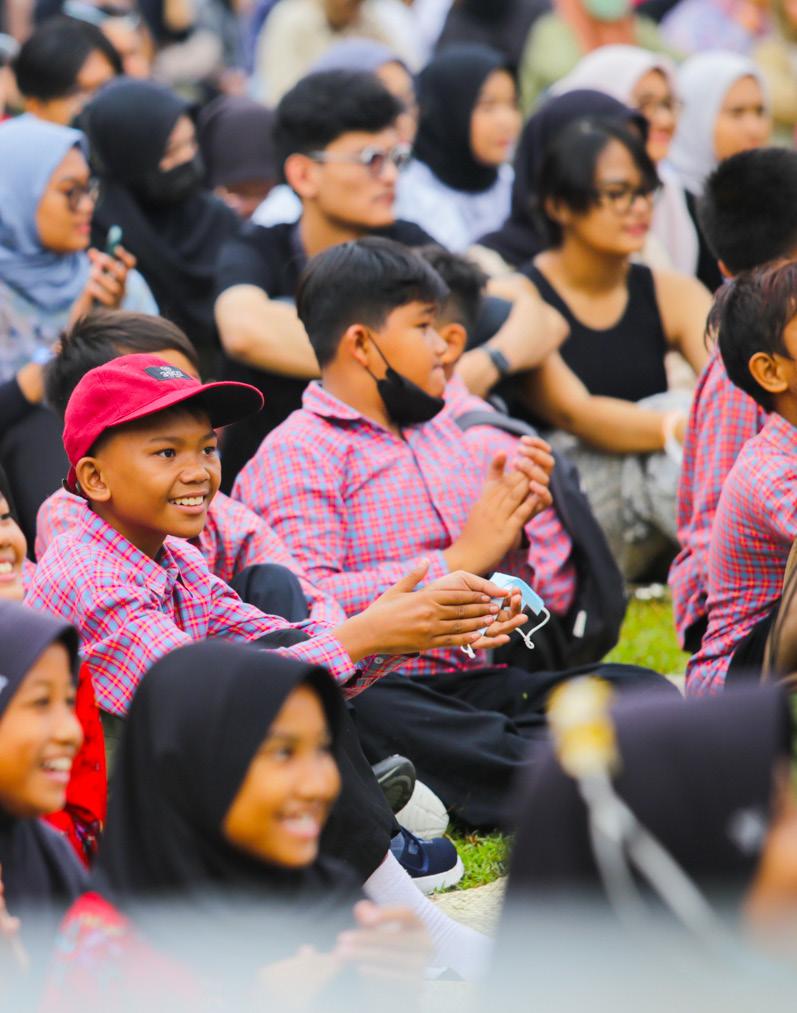
VOL. 15, 2022 INDONESIANA I 25
Children eagerly watching InTur’s storytelling
Photo courtesy of Irnie Wanda
Vadvancement program is one of the priority programs of the Directorate General of Culture. The program aims to revive villages as the wellspring of livelihood, cultural commons, and the cradle of the cultural ecosystem. Village communities make up the subject of development rather than the object.
We designed the village-based cultural advancement program to respond to the challenges of globalization, which has turned rural villages into urban areas and caused rural communities to lose their identity.

Village-Based Cultural Advancement and Empowerment

Measures of development success that only focus on economic growth have eroded the network of mutual help among villagers and the local wisdom that grows from village community practices, creating new problems such as environmental degradation and social inequality.
To overcome this adverse impact, the government has started the villagebased cultural advancement program to develop the village based on village potential as the primary capital for a more comprehensive development than just economic development. In this way, we hope that there will be endogenous growth that comes from the village’s potential.
CULTURAL EVENTS
26 I INDONESIANA VOL. 15, 2022
Capturing People’s Imagination
Throughout history, the village has played a role as the melting pot of cultural interactions among the people of Indonesia and has kept the memory of the social life values. We have passed down the values for generations. The village is the smallest government unit and is the cradle of Indonesian cultural identity.

The village has enormous potential in terms of natural, human, tangible, and intangible culture, and even historical potential that can develop the rural community according to the imagination of its people about the village’s future.
Villagers’ imagination is a reliable guide for contextual development. Villagers have more right to talk about the future of their village as they directly experience the concrete struggles of rural life.
How do the villagers want their village to develop into what they envision? How can local businesses work together to make it happen? That is the starting point for endogenous development.
Through the villagers’ imagination, all cultural entities in the village are involved, from children to the elderly, both women and men from
various work backgrounds. Inclusive in it are people with disabilities and other vulnerable persons.
Based on the villagers’ imagination, we executed our village-based cultural advancement in 3 stages. The first stage is the identification of the culturalpotential stage, the second is the development stage, and the third is the utilization stage.
Implementing the whole process is based on recognizing the resources owned by the villagers. Thus, the three stages always uphold the principles of social inclusion, equality, independence, sustainability, practicality, and participation.
The Nation’s Cultural Commons
Sometimes we don’t realize that we have great potential. The same goes for villages. In the identification stage,
VOL. 15, 2022 INDONESIANA I 27
Photo courtesy of Radian B. Sena
we invite the community to rediscover and recognize their cultural heritage, the tangible and intangible, and the history of the rural village and the natural environment. The identification process also mapped community groups that support the sustainability of these various cultural practices.
We expect the participatory mapping concept to capture the village’s potential and existing problems. In addition, this stage also maps out the community’s expectations about the future of their rural community. Subsequently, we created a joint dialogue to plan the development of all potentials through an action plan.
The second stage of the program is the development stage. At this stage, we developed the culture potential map according to the Law on the Advancement of Culture, among others, an assessment of the possibility of cultural innovation. We then carried out diversity enrichment, efforts to encourage dialogue and interaction with people of other cultures.
The development of this potential aims to solve various problems in the village through cultural means, such as the solution to the problem of food security through using traditional, environmentally friendly agricultural methods and local rice as a genetic resource. Villagers with all elements in the village community work together through various activities. This effort aims to get social agreements in formulating an action plan for cultural development through village gatherings, village discussion forums, organizing joint cultural seminars, participatory maps’ alignment, and deepening understanding of the ecosystem of cultural potentials.
The third stage is the utilization stage, which aims to increase cultural resilience, intercultural collaboration, community welfare, and village character development. At this stage, villagers can identify and select the program’s strategic partners, plan program financing, and form a catalyst organization.
We then synchronized the final action plan with the results of the village-level Deliberation of Development Planning (MUSRENBANG) to get the right to use the village fund. The publication of

village potentials comes after this step, such as through films and books, as well as reintroducing village culture to children through local content education, activating art studios as a cultural space for villagers, and so on.
Villages of a Distinct Local Character
Village-based cultural advancement is not the same as turning all villages into “tourism villages.” Indonesia has recently widely practiced this type of village management. It is as if the cultural
28 I INDONESIANA VOL. 15, 2022
Government awards for those who have successfully mobilized the cultural ecosystem in the village and contributed to village-based cultural advancement
Village harmony in art
Photo courtesy of Directorate of Cultural Development and Utilization
(Clockwise) Villagers participation in improving community welfare; Rural women empowered; Hanging out accompanied by music and songs
potential of a rural community is and can only be a tourism attraction. The reality shows that the more independent village is an agricultural village, not a commercial tourism village.
Therefore, in implementing villagebased cultural advancement programs, always remember that development is contextual. It does not use a single
formula or model applicable to all villages.
We designed the village-based cultural advancement to empower villages by developing using their potential and encouraging village collaboration. The work is networking, capitalizing on all the social networks that connect each rural community. The goal is not to turn rural

villages into urban areas but to build free associations that bring together cultural strengths from various rural villages for national cultural advancement.

 (Maya Krishna, Senior Cultural Administrator, Directorate of Cultural Development and Utilization, Ministry of Education, Culture, Research, and Technology)
(Maya Krishna, Senior Cultural Administrator, Directorate of Cultural Development and Utilization, Ministry of Education, Culture, Research, and Technology)

VOL. 15, 2022 INDONESIANA I 29
Photo courtesy of Radian B. Sena
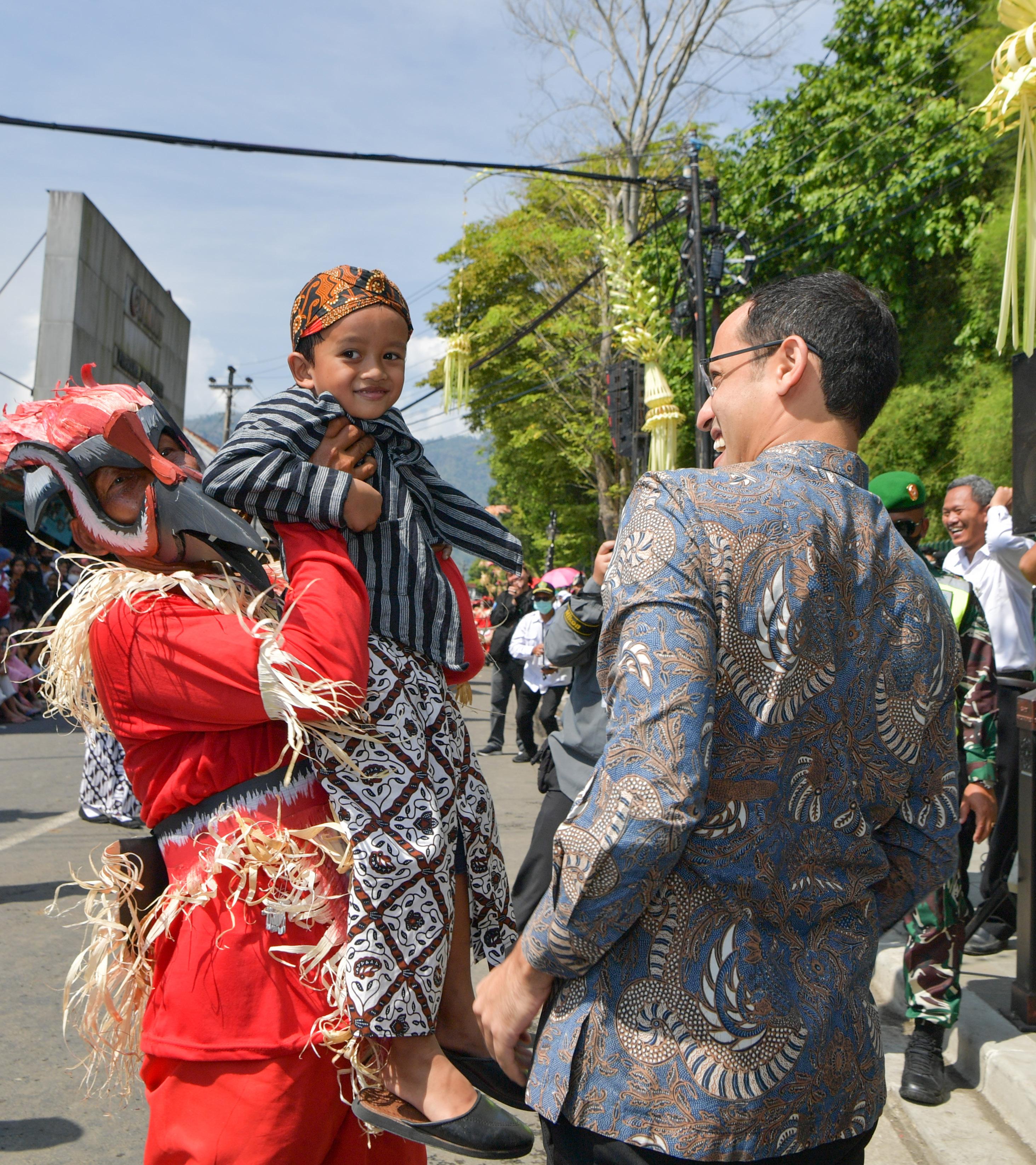
30 I INDONESIANA VOL. 15, 2022 CULTURAL EVENTS
Accumulating Cultural Actions for Sustainable Living

“G20 Culture Ministers Meeting” was held on 13 September 2022 in Borobudur with the theme Culture for Sustainable Living. The theme was selected based on the notion that the world is currently being hit by a crisis in very basic areas, such as clothing, food and shelter. The consumptive and instant
lifestyle has created heavy pressure on the carrying capacity of the environment. The meeting was conceived as a forum to roll out a new consensus in restoring human relations with nature by drawing inspiration from various local cultural practices that respect nature’s life cycle.
VOL. 15, 2022 INDONESIANA I 31
The ministerial level meeting was not a stand-alone event, but a culmination of a series of efforts in consolidating various local practices that took place in many regions and in many countries. In many regions in Indonesia there have been development of cultural management initiatives for the creation of a more sustainable way of life, which seeks to restore the harmonious relationship between humans and nature. These various initiatives were stimulated
from the academic level, youth to the grassroots movement.
Grassroots Movement
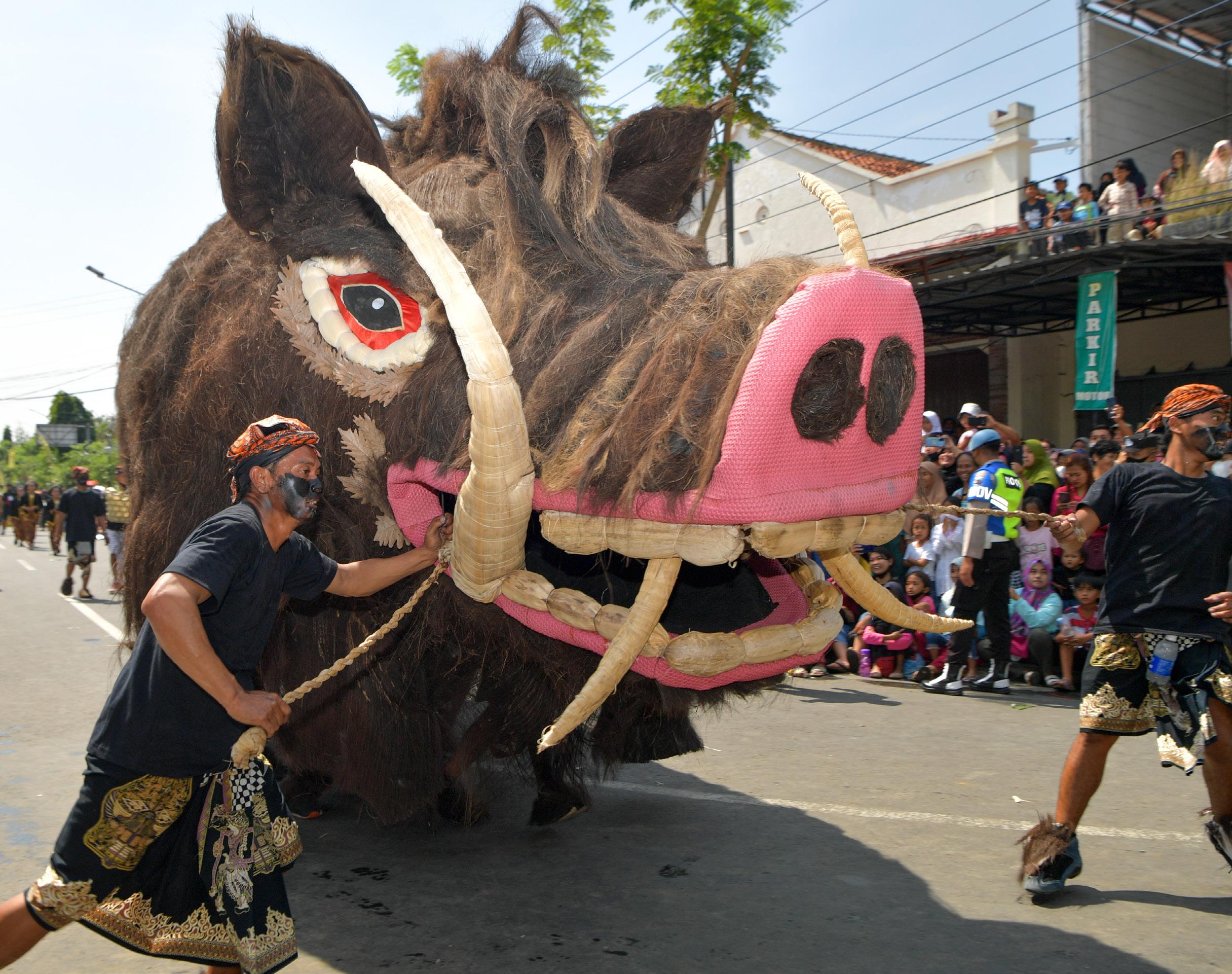
Within the grassroots movement, especially at the village level, various initiatives have emerged to identify local cultural potential and transform it to become the main capital for a more environmentally friendly development and to support a more human-centred socio-economic development. The Villagebased Cultural Advancement Program
is a manifestation of such initiatives. Representatives from all villages in the Borobudur area participated and held a series of Cultural Markets from July to September 2022, which showcased a variety of featured products that were selected through participatory mapping while participating in the Village-based Cultural Advancement Program. All of them are clear examples of how local culture can be a source of inspiration for creating a new, more sustainable lifestyle.
32 I INDONESIANA VOL. 15, 2022
The minister chatting with a young carnival parade participant
A giant boar’s head at the culture carnival parade
(above) Ruwatan Bumi (Purging the Earth) ; (below) Inclusive spaces for interactions
The series of activities within the framework of Pekan Kebudayaan DaerahPKD (Regional Culture Week) which have been held at the district/city level across Indonesia also continue. These activities provide a forum for inclusive interaction of all public initiatives in advancing regional culture, as well as a forum for artists and cultural practitioners to showcase their cultural expressions through the organisation of regular festivals in various regions in Indonesia. From PKD, it is expected that

artists and cultural practitioners could find opportunities for development. Local culture can be an inspiration in organising brilliant strategies to overcome the obstacles of contemporary life.

Consolidation of Power
Various bottom-up initiatives that had been rolling since early 2022 have come together to become one gigantic force which laid the basis for the “G20 Culture Ministers Meeting”. All ideas
and practices were presented during a forum called the Pekan Konsolidasi Tenaga Budaya-PEKAT Budaya (Cultural Workforce Consolidation Week) which was held in early September 2022. This forum gathered representatives from culture for sustainable living initiatives, including academics, youth, as well as representatives from the Village-based Advancement of Culture Programme and the Regional Culture Week. Held in parallel in five villages in the Borobudur area (Wringin Putih, Karanganyar,
VOL. 15, 2022 INDONESIANA I 33
Karangrejo, Wanurejo, and Candirejo), the collective deliberation forum brought together cultural actors, academics and village representatives to consolidate key messages to be conveyed at the G20 Culture Ministers Meeting on 13 September 2022.
To convey the key messages, community members in the Borobudur area participated in the cultural parade which travelled from Pawon Temple to Borobudur Temple on 12 September 2022 and held a large gathering upon their arrival at the Lumbini Garden of Borobudur Temple Compound. The cultural parade was a manifestation of the community’s seriousness in creating lifestyle changes, an embodiment of
the collective energy of national cultural actors to create a new world that is fair and physically and spiritually prosperous. Through the 45-minute procession, there was a general will to restore cosmic harmony, to end the metabolic rift between humans and nature, through cultural means. The large gathering with participation of thousands of community members became the culmination of this procession. They held a ritual meal together at the Lumbini Garden as a symbol of solidarity with other creatures from different realms of nature and conveyed their aspirations through a series of performances which were artistic adaptations of the various issues they had discussed in the series of preceding activities.
New Commitment
This entire series of activities ultimately culminated in the “G20 Culture Ministers Meeting” at the Plataran Hotel on 13 September 2022. Representatives from the grassroots level movement conveyed the Borobudur Mandate, a manifesto that contains the stance of cultural actors from various regions and countries regarding what to do if life on earth will
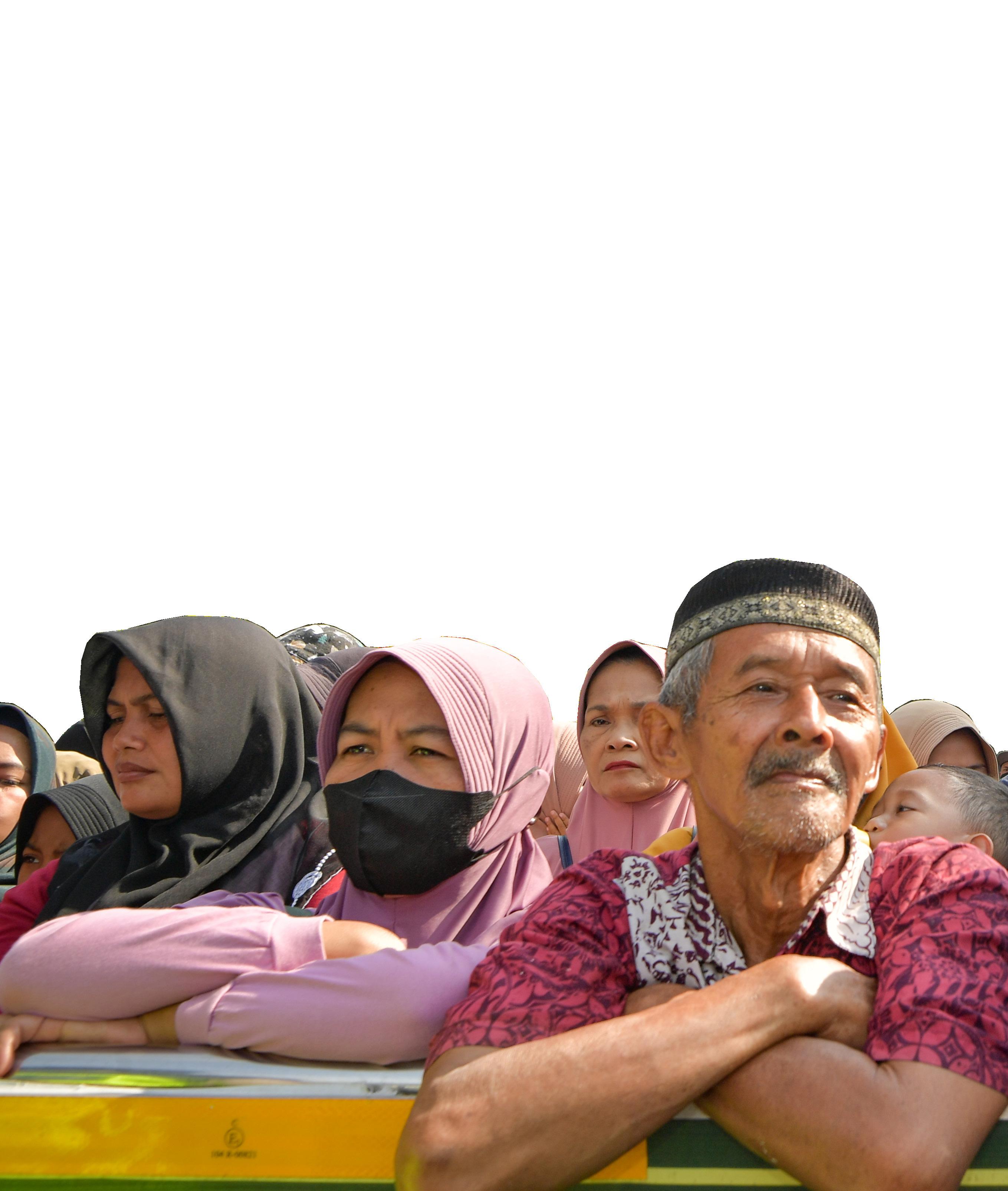
34 I INDONESIANA VOL. 15, 2022
Enthusiastic crowd watching the carnival parade
continue. This mandate states, among other things, that “we must leave behind a universe with better conditions than today”. The reading of the Borobudur Mandate became one of the key considerations in formulating the results of the meeting of ministers from G20 member countries in the field of culture.
In line with the Borobudur Mandate, the G20 Culture Ministers Meeting concluded with a joint commitment to encourage an increase in the role of culture to
enable a transition towards a system that is more aligned with sustainable living. The Minister of Education, Culture, Research and Technology of the Republic of Indonesia stated in the Chair’s Summary of the G20 Culture Ministers Meeting that culture has intrinsic value beyond its social and economic benefits, and that it is important to encourage significant changes in society’s ways of life that promote diversity, equity, and inclusion. “Equally important is the joint commitment to explore the creation of the Global Arts and Culture Recovery Fund that could be managed by UNESCO, on a voluntary basis, to restore the cultural economic sector and to promote sustainable living, which could be discussed in the Finance Track of the G20”.
To reinforce the message of culturebased global recovery, the Ruwatan Bumi (Earth Healing Ritual) was held at Borobudur. Hundreds of delegates along with thousands of participants witnessed a series of performative rituals featuring traditional vocal-based songs from various parts of the archipelago. Messages of sustainable living based on traditional culture were highlighted through the fabric of local narratives. The “G20 Culture Ministers Meeting” is undoubtedly part of the cultural actions from various regions and parts of the world which encourage transition toward a system that is more aligned with sustainable living
(Martin Suryajaya, Indonesiana)

VOL. 15, 2022 INDONESIANA I 35
Photo courtesy of MoECRT
When Traditional Music Makes a Spectacle at Lake Toba
“Sorry, Bro. It’s been two years since the last event. I even forgot how to attach the rigging. Hehe.”
Asnippet of conversation above is the answer of Bang Ucok, a stage rigging technician, when I asked why it took him so long to build a stage rigging for the Lake Toba Music Festival Road Show in Sidikalang, Dairi Regency, North Sumatra in May 2022.
We fully understand that the policy of Imposing Restrictions towards Community Activities (PPKM) in response to the Covid-19 pandemic has impacted the loss of routinely held performing arts activities before the pandemic. According to the records of the Ministry of Education, Culture, Research, and Technology (Kemendikbudristek) of August 2021, 65% of national cultural
actors lost their jobs which resulted in a decrease in income of up to 70%, and 70% of art spaces and cultural organizations are temporarily closed.
We are seeing the return of performing arts support workers like Bang Ucok in implementing cultural activities since the government eased the PPKM policy in the past year.
This article aims to share the experience gained from implementing the Lake Toba Music Festival 2.0 series of events in May-August 2022 in the Lake Toba Area, North Sumatra. It is one of the best practices in efforts to restore
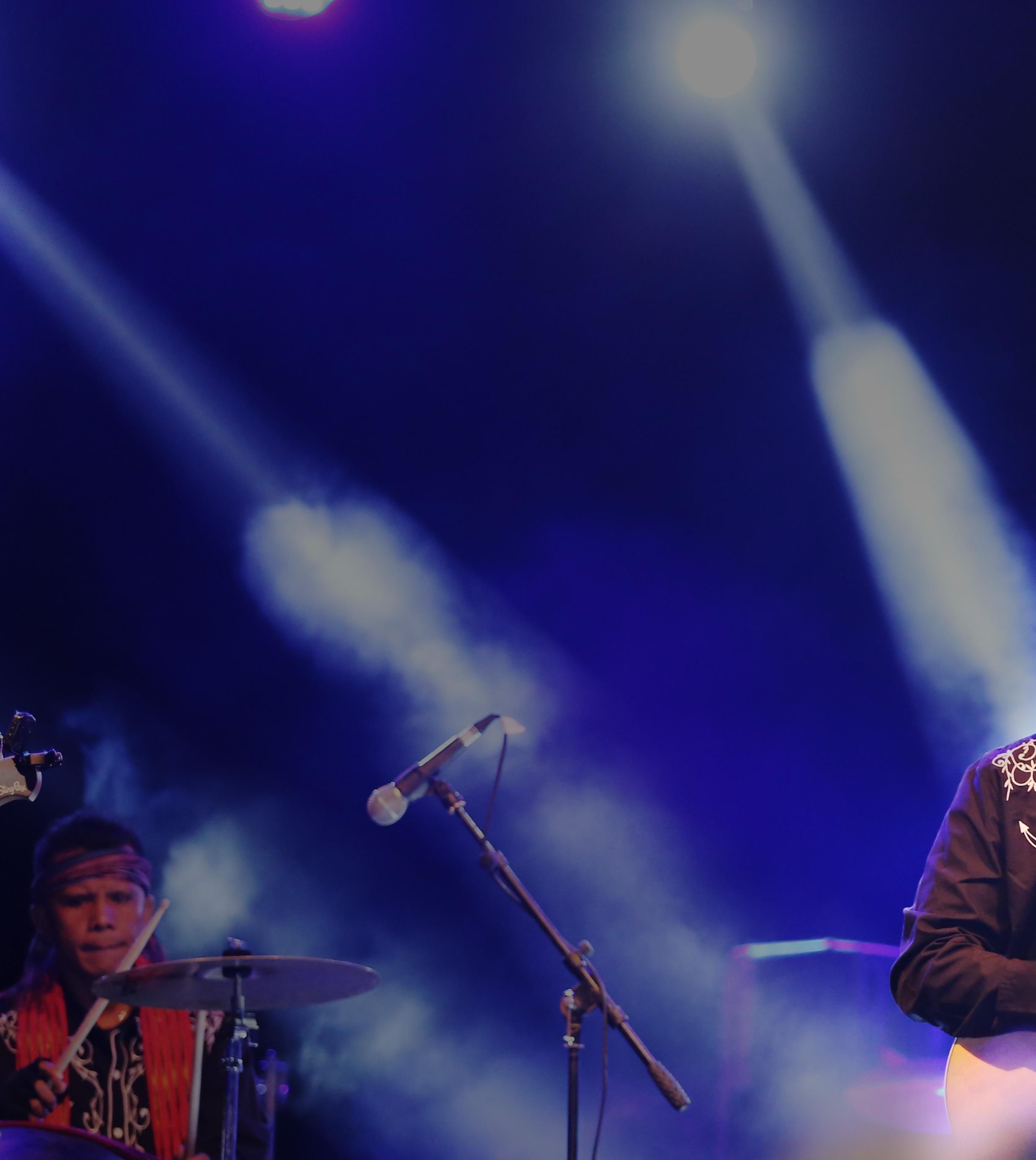
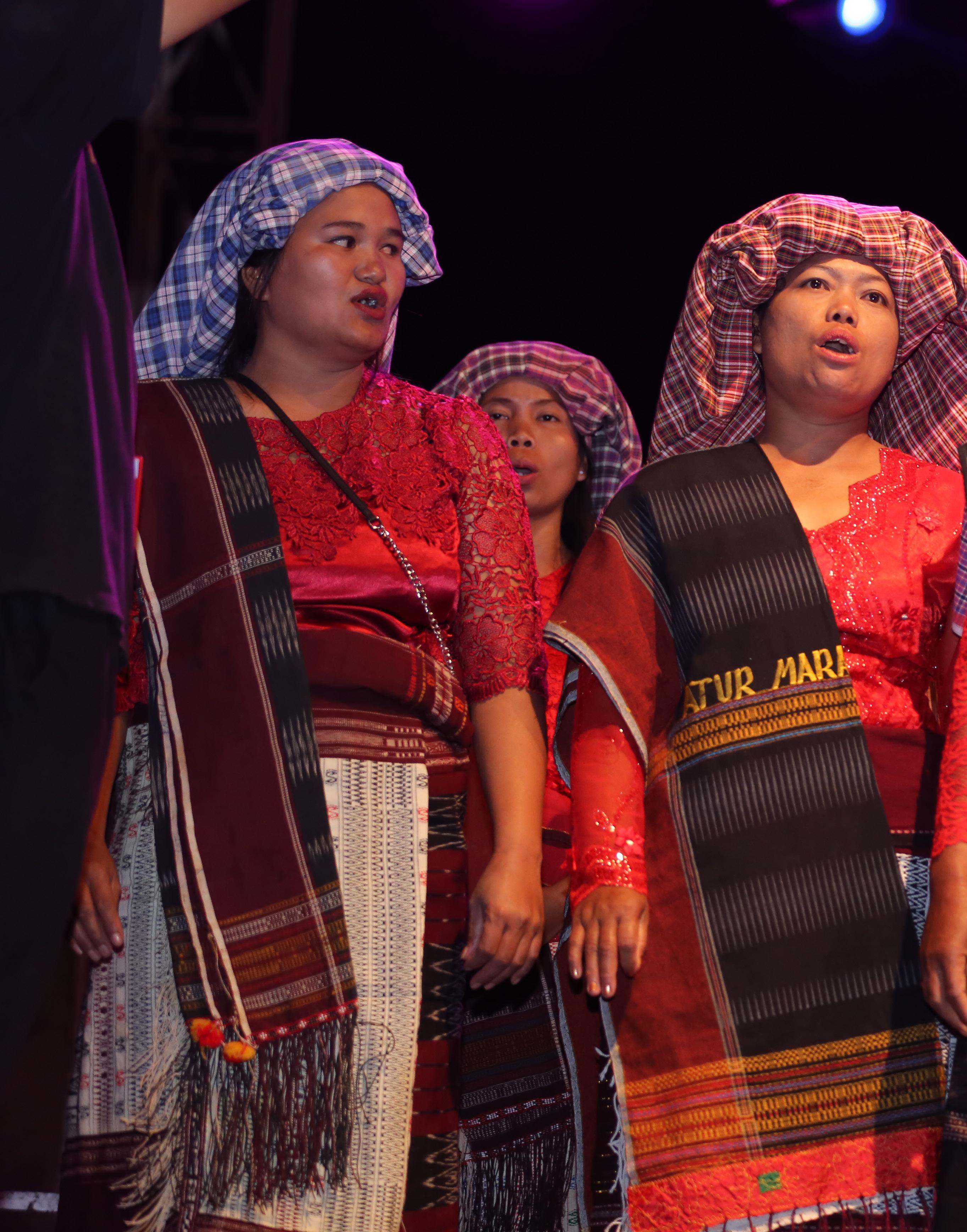
CULTURAL EVENTS
36 I INDONESIANA VOL. 15, 2022
the post-pandemic arts and culture ecosystems through local community involvement.
Community Roles
Rumah Karya Indonesia (RKI), based in North Sumatra, is one community that welcomes the easing of the PPKM policy. This community was born on the premise that Indonesia is rich in ethnic groups. In North Sumatra alone, there are at least dozens of ethnic community groups that have been living in harmony.
These community groups have a good deal of heritage of high-value traditional artworks. Unfortunately, these indigenous artworks are not well-developed. People even take it for granted. As a result, many indigenous art forms are in danger of becoming extinct, including the supporting instruments and the knowledge they have. RKI’s activities focus on the administration and management of traditional music performances, research, publications, and documentation.
Since 2021, RKI has started the implementation of a traditional music festival that aims to build a cultural ecosystem in advancing culture and


VOL. 15, 2022 INDONESIANA I 37
Harmonious inang ensemble Marsada
expediting the economy in the Lake Toba Area through an indigenous music festival. It is also in line with the theme of the G20 Presidency, ‘Recover Together, Recover Stronger.’

Lake Toba Music Festival 2.0 UNESCO has designated lake Toba, or the Toba Caldera, a UNESCO Global Geopark. This area has geological and high-value traditional heritage linkages with the local community, especially cultural heritage. Other regions of Indonesia and even Southeast Asia also have geoparks. Likewise, with Lake Toba, several areas that have geoparks must also have high-value traditional heritage, especially cultural heritage. Because
of this similarity, Lake Toba Traditional Music Festival 2.0 invites a network of traditional musicians in the geopark area, both local and national, as well as from abroad.
Lake Toba Music Traditional Festival 2.0 is the brainchild of Rumah Karya Indonesia, where artists from 4 ethnic groups in the Lake Toba Area create a collaborative work with other artists by involving the local community of Lake Toba through music. We organized this activity on the outskirts of Lake Toba, which has a cultural ecosystem potential. This kind of activity brings a positive impact on the community and visitors.
The year 2022 marks the 2nd year of the Lake Toba Traditional Music Festival organization. It is part of the Indonesian Traditional Music Festival themed ‘Suara Danau: Memaknai, Merawat dan Menghidupkan Musik Tradisi’ (The Sound of The Lake: Fathoming, Fostering, and Reviving Traditional Music). We presented these three elements as a festival. The festival encourages us to know the knowledge, learning, and development process, which we must look at as a whole.
Lake Toba Traditional Music Festival 2.0 is the culmination of the activity, a continuation of the previous Eta
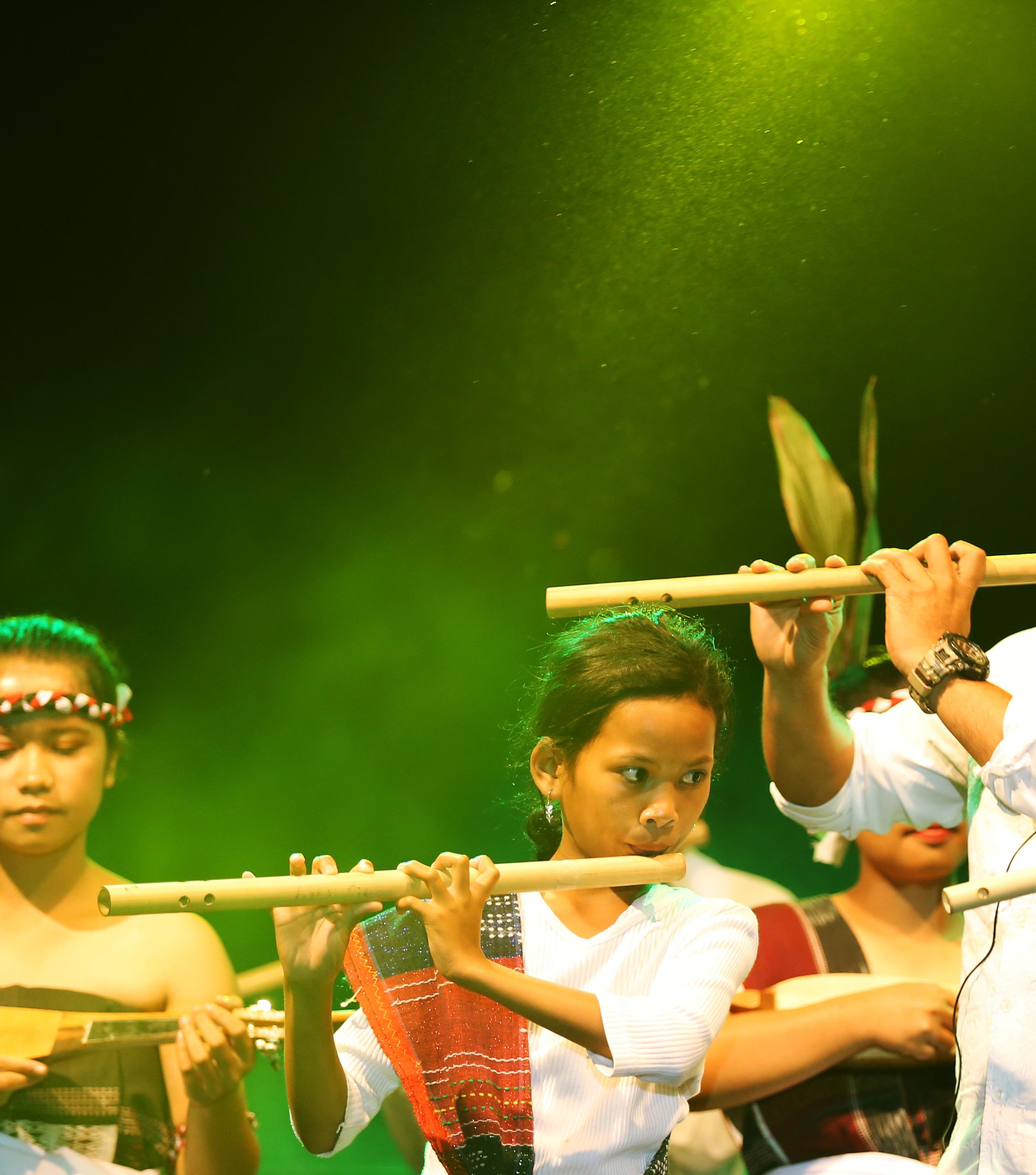
38 I INDONESIANA VOL. 15, 2022
Margondang event, which was held in four districts using different concepts. Lake Toba Traditional Music Festival 2.0 is also part of the program of the Ministry of Education, Culture, Research and Technology in collaboration with Rumah Karya Indonesia for advancing culture, especially for strengthening the Indonesian traditional music ecosystem as a manifestation of the mandate of Law no. 5 of 2017 on the Advancement of Culture.
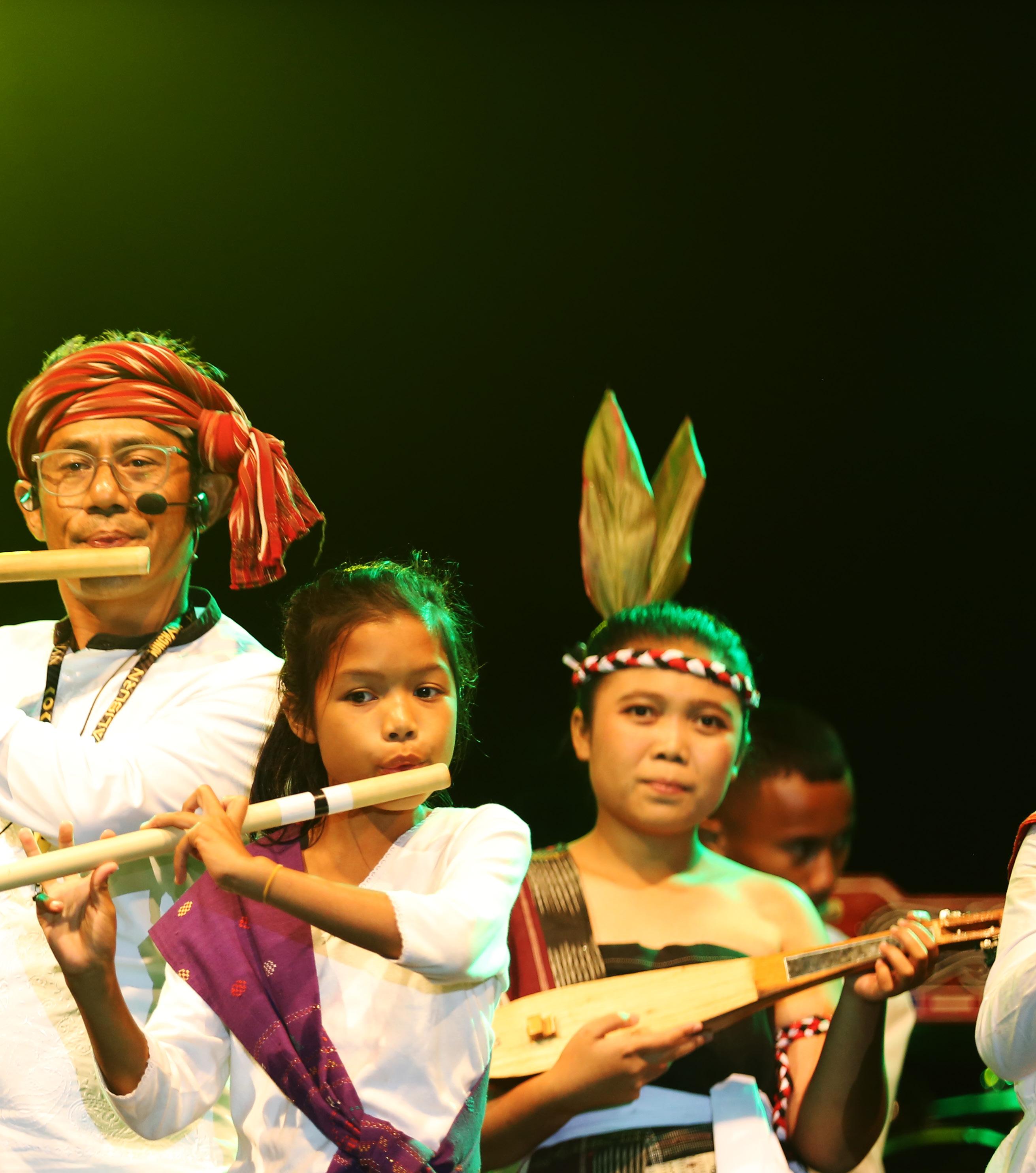
The highlight of this show is Eta Margondang, presenting young
musicians from four ethnic groups around Lake Toba who have practiced and are creating new works they showcase to connoisseurs of traditional music. Eta Margondang also featured a collaboration of 500 flute players living around Lake Toba. Besides Eta Margondang’s performance, there was a performance by a well-known crossgeneration local band. They play a collaboration of traditional and modern music.
Referring to the theme of the G20 Presidency, “Recover Together, Recover Stronger,” efforts to speed up the recovery of the traditional music ecosystem require the support of the
community, whose role is to safeguard the socio-cultural conditions of their people.
RKI revives the art of traditional music, a form of cultural practice that ensures the continuity of a sustainable life. This performing arts activity advocated by RKI is also a cultural ritual where people gather, create, and carry out economic activities involving Micro, Small, and Medium Enterprises (MSMEs). Traditional music is one of the concrete forms of culture that plays a role in a sustainable life.

VOL. 15, 2022 INDONESIANA I 39
(Denison Wicaksono, Directorate of Films, Music, and Media, MoECRT) Toba’s unifying harmony
Intergenerational transmission of sound
Photo courtesy of Directorate of Film, Music, and Media
Promoting Objects of Advancement of Culture
Collaboration between Local Government and Communities
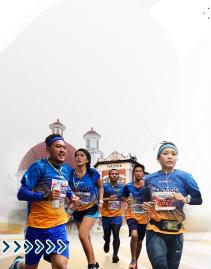
CULTURAL EVENTS
40 I INDONESIANA
15, 2022
VOL.
Indonesia is a country rich in nature and culture. It is no wonder that the former UNESCO Assistant Director General for Culture
(ADG Culture)
Francesco Bandarin said to the then Minister of Education and Culture (Mendikbud) Muhadjir Effendy that Indonesia is a “superpower” country in terms of culture. This statement was conveyed during a meeting on the sidelines of the 39th UNESCO General Assembly which took place at the UNESCO Headquarters, Paris, in November 2017. This is based on the fact that Indonesia has so much natural and cultural diversity.
Indonesia has 17 thousand islands spread across 38 provinces (including 4 newly established provinces in Papua in 2022), 416 regencies, 98 cities, 7,094 sub-districts, 74,957 villages and 8,490 sub-districts (as of 2019). With this extraordinary potential, how is the governance of culture in Indonesia and what is the role of the local government in developing and utilizing cultural potential or objects of advancement of culture in their area? These are the challenges that have been addressed in the Law Number 5 of 2017 concerning the Advancement of Culture.
The Advancement of Culture, Our Shared Responsibility
Based on Law No. 5/2017, it is clear that the Advancement of Culture is under the coordination of the Minister of Education and Culture since this is part of the effort to improve cultural resilience and Indonesian cultural contribution to the development of world civilizations through cultural protection, development, utilization, and empowerment. The principles of the advancement of culture
are tolerance, diversity, locality, interterritorial, participation and benefits, sustainability, freedom of expression, integration, equality and mutual cooperation – as mandated in Law no. 5/2017 Article 3.
The aims of the advancement of culture are very noble namely to provide direction in the course of national development, including developing the nation’s virtue, enriching cultural diversity, strengthening the nation’s unity and integrity, educating the nation’s image, achieving a civil society, improving people’s welfare, preserving the nation’s cultural heritage, and contributing to the enrichment of the world’s civilization as stated in Law no. 5/2017 Article 4.
The technical implementation of the Advancement of Culture is a shared responsibility between the government and society, both individuals and communities. The local governments play an important role in the management of objects for the advancement of culture. This role is set in stages from the district, provincial and national levels. This is in line with the Law on the Advancement of Culture regarding the responsibility of regency/municipal government in identifying cultural potential in their regions by developing the Pokok Pikiran Kebudayaan Daerah-PPKD (Culture White Papers) as a reference for the advancement of culture.
PPKD (Culture White Papers)

The advancement of culture is guided by the Regency/municipal Culture White Papers, Provincial Culture White Papers, Cultural Strategy, and the Master Plan for the Advancement of Culture as stipulated in Law no. 5/2017 Article 8. Culture White
Papers are the basis for the advancement of culture that have been prepared in stages starting from the regency/ municipal level and then to the provincial and national levels as the core materials for developing Cultural Strategy which then will become the core materials for the Master Plan for the Advancement of Culture (UU No. 5/2017 Article 10).
Regency/municipal Culture White Papers describes the current condition of the objects of the advancement of culture, cultural human resources, cultural organizations, cultural institutions, infrastructure, potential problems for the advancement of culture, and analysis of and recommendations for implementing the advancement of culture in each regency/municipality (see Law No. 5/2017 Article 11 paragraph 2).
The latest data – compiled by the Center for Cultural Data and Information, Ministry of Education, Culture, Research and Technology – shows the dynamics in the preparation of Culture White Papers from 514 regencies/municipalities with the following details:
Year 2018 : 301
Year 2019 : 59
Year 2020 : 32
Year 2021 : 19
Year 2022 : 18
The data states that out of a total of 429 existing regencies/municipalities, 79 regencies/municipalities have not yet drafted their Culture White Paper, including DKI Jakarta Province which consists of 6 (six) municipalities. It should be noted that the Culture White Paper is a crucial matter that must be prepared
People take part in activities
VOL. 15, 2022 INDONESIANA I 41
Photo courtesy of Culture and Tourism Office of Semarang City
by districts/cities as part of commitment and seriousness in advancing culture. A commitment that must be renewed from time to time as a policy basis and priority setting in advancing culture in each regency/city.
Good Practices for the Advancement of Culture at Local Level


The advancement of culture at the local level requires a strong commitment both from the government and the community. Creativity, hard work, networking, and financing are required so that programs and activities could be implemented with broad and sustainable impact, while contributing to cultural preservation and improving the general welfare. In addition, there is a need for collective awareness to pass on the objects of advancement of culture especially to the younger generation.
Commitment to advancing culture stems from institutional governance as administrator of the cultural sector. Data collected up to November 2021 shows that out of 34 provinces, only 7 provinces have dedicated cultural offices, namely West Sumatra, DKI Jakarta, Riau, Bali, Riau Islands, North Sulawesi and Yogyakarta Special Region. This is in line with Law no. 23/2014 on Regional Government which states that governors and regents or mayors can establish a Regional Apparatus Organization to manage important regional affairs, including culture.
Meanwhile, regencies/cities that already have offices dedicated for culture are Sawahlunto City, Buton Regency, East Belitung Regency, East Kutai Regency, and Makassar City. These regency/municipal offices are focused on sustainably managing objects of advancement of culture and paying more attention to programmes and activities in the cultural sector which are supported by funding from the Regional Revenue and Expenditure Budget or other funds from various sources.
East Belitung Regency is committed to developing spices and maritime affairs, building a maritime museum as a support
for the revitalization of spice culture and organizing the ‘Jelajah Pesona Jalur Rempah-JPJR’ (Explore the Spice Routes) festival. Whereas, the ‘Pesta Kesenian Bali-PKB’ (Bali Arts Festival) has been organized by the government of Bali Province for decades. PKB is managed systemically with good programs, organizing mechanisms, networks and funding support. PKB has become one of the most awaited annual agenda which involves all components of Balinese society. The two local governments above are good examples of efforts for the advancement of culture which resulted from the collaboration between the local government and the community.
(left) Guest star performance with NDX
42 I INDONESIANA VOL. 15, 2022
(right) The Regent of Sragen and her staffs participate in SangiRUN Night Trail 2022
Photo courtesy of Culture and Tourism Office of Semarang City
Nonetheless, local governments that do not have their dedicated cultural office also have commitment for culture. Some of these local governments are enthusiastic in raising their cultural potential and wisdom in ways that are more creative and accepted by society. They also develop their network and create more fun and unique contemporary activities that could be of interest to the community.
Their commitment is demonstrated by organizing various cultural preservation activities, involving the community, networking with various stakeholders, and communicating with the central government in terms of program

advocacy and development. This is very positive, considering that networking with various parties will increase media exposure and result in broader impact than working in silo. Therefore, it is very important to build a strong working network between government agencies and the communities, both individuals and groups, to synergize the efforts for the advancement of culture at the local level.

The local objects of advancement of culture must be sustained in ways that are creative and involving all elements in society. Gotong royong (mutual cooperation) is the core
in developing programs, securing funding and implementing activities for the advancement of culture. In addition, synergy, mutual support, and commitment of local governments are the main keys in advancing culture throughout Indonesia from Sabang to Merauke, from Miangas to Rote Island.
 Salam Budaya
(Yayuk Sri Budi R, Associate Cultural Administrator, Head of Working Group for Cultural Development, Directorate of Cultural Development and Utilization, MoECRT)
Salam Budaya
(Yayuk Sri Budi R, Associate Cultural Administrator, Head of Working Group for Cultural Development, Directorate of Cultural Development and Utilization, MoECRT)
VOL. 15, 2022 INDONESIANA I 43
Photo courtesy of Jessika Nadya
By:
Ngarak Barong is one of Bekasi‛s traditional heritage. There will be a parade. The objective of this tradition is maintaining good relationship (silaturahmi)
Fruits and dishes will be presented on the rugs and we will gather to eat together (Bebaritan).

Hi Guys! We are from Bekasi and will have an exciting program today. Come and join us! So you know that Bekasi is proud of its culture
EEAA..TT DAH!!
Mpok, we are moving too slow. We need to speed up if we want to arrive soon in Bekasi.
Today is a special day. We – from Bekasi – have an assignment to collect the natural resources from our region. These naturally grown resources will later be cooked by the ladies for our special dishes today.

Is
This is what happened if you play too much with layangan koangan. You haven‛t even touch your social science book! Bekasi is located in West Java on the eastern border of Jakarta.

I will help with the make up and traditional attire for the young people from our village this afternoon. Do you know that I am an award winning make up artist?
What are you making, encang?
Our region has a potential for high quality rice commodity. There are also plenty of natural resources in the rivers and lakes. You could catch a fish easily in this area.
Well, little brother…
We are going to organise “Ngarak Barong” this afternoon. It as a tradition to celebrate Lebaran organised by the Betawi community within 2 weeks after the end of Ramadhan month. It is going to be exciting

I could not wait to cook Betawi traditional food. I can guarantee that it is going to be delicious!


This Barong Mask will be used for the Ngarak Barong tradition this afternoon.
In the past, this kind of mask was used in the ritual to repel disease outbreaks and crops diseases. A Barong should look like a giant scary creature. Today, Barong is part of the cultural heritage preservation in Bekasi.
Could we join the Ngarak Barong, Cang?
Yes, surely!
Alright…


Let‛s start our tradition. We will start the Ngarak Barong while maintaining silaturahmi.



44 I INDONESIANA VOL. 15, 2022 Ooi This is a cork sh
Go and catch them.
Well, mpok, it is a bit far. You cannot really see it from the map.
Bekasi
from
far
here, De?
slipped! Mpok, what are we going to do today? You said that today is a special day. But, haven‛t we just celebrated Lebaran day yesterday?
justYes,Iwas joking Ouch, I
EMAAK
Ngarak
Let encang explain about the
Barong
In Ngarak Barong tradition, you could find scary giant dolls, followed by the young people walking together while carrying cepu filled with traditional food and dishes. The traditional food will be delivered collectively and paraded together with a group of jawara accompanied by drumming music. The food will receive blessings before being eaten. Yes Sir, we should be able to live in harmony with our neighbours
HE..
doing
up! Hope you all get along well. Please accept apologies for any wrongdoings. Alhamdulillah, we all could gather here for silaturahmi *LHA BAGEN DAH : Let It Be Wow, thismust bedelicious!
HE
You should be the one
the make
Bekasi is proud of its culture
Aura Sasi Kirana
COMICSTRIP
Punakawan

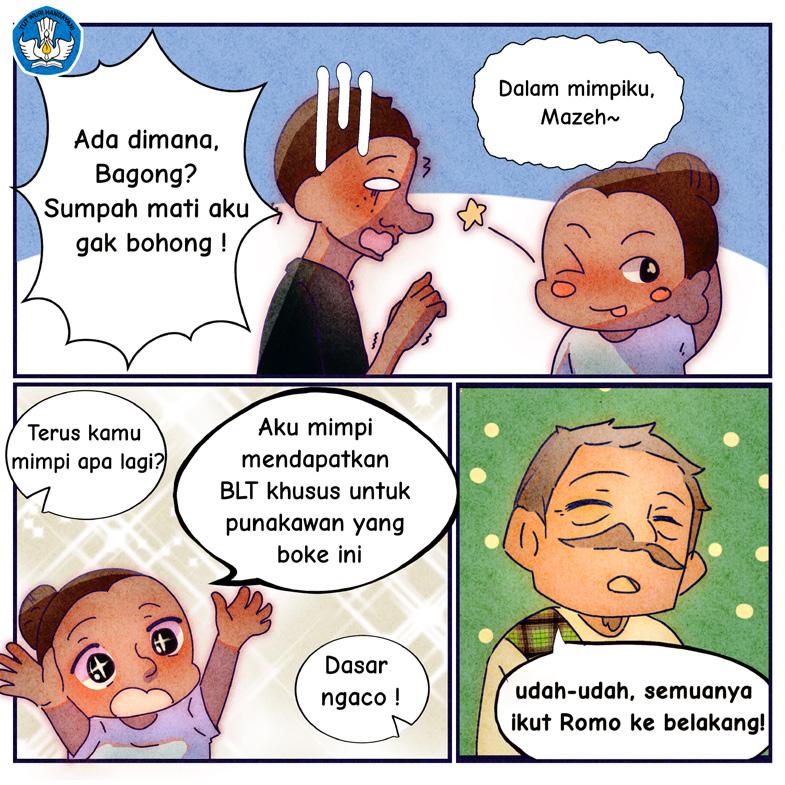








Planting Spices
Planting Spices



 By Amabel
By Amabel



VOL. 15, 2022 INDONESIANA I 45
I haven‛t had my wedang uwuh this morning
We are running out of spices, mo That‛s not true, There are still I dream of receiving BLT specially for this broke punakawan! What a random dream! Please take a look at this garden Since when we have a complete collection of medicinal plants like this? Heritage? Wow, are going to be rich!
Punakawan
What‛s up, Mo? I haven‛t had my wedang uwuh this morning Come on, wake up!
Well, okay! We are running out of spices, mo That‛s not true, mo. There are still plenty Where are they, Bagong? I swear that I didn‛t lie! It‛s in my dream, Mazeh What else are you dreaming about? I dream of receiving BLT specially for this broke punakawan! What a random dream! Stop it you all, come follow me to the back! Please take a look at this garden Since when we have a complete collection of medicinal plants like this? I never leave the tradition from our ancestor. Heritage? Wow, are going to be rich! Shut up, Bagong! But, it is my mistake not to pass down this tradition to you We can drink herbs every day and have a healthy body Wow, Mo! we will not be afraid of any outbreak Now, Bagong, could you please take the gingers, cloves, lemon grass and other ingredients? Should we collect the wood, nutmeg cinnamon? Romo and mas Gareng, please just wait for us. Wedang made by Petruk simply best! This is what I like from Romo. He always loves local tradition.
By Amabel
Regional Office for Cultural Preservation in Region IV
Regional Office for Cultural Preservation in Region I
Regional Office for Cultural Preservation in Region II
Regional Office for Cultural Preservation in Region III
Regional Office for Cultural Preservation in Region VII
Regional Office for Cultural Preservation in Region V
Regional Office for Cultural Preservation in Region IX
Regional Office for Cultural Preservation in Region VI
Regional Office for Cultural Preservation in Region XII
Regional Office for Cultural Preservation in Region VIII
Regional Office for Cultural Preservation in Region XIII
Regional Office for Cultural Preservation in Region X Regional Office for Cultural Preservation in Region XI
Regional Office for Cultural Preservation in Region XV
Regional Office for Cultural Properties Preservation (BPCB) and Regional Office for Cultural Values Preservation (BPNB) have long been regional technical implementing units of the Directorate General of Culture. However, developments in the field have shown that separating governance of cultural properties and cultural values often impedes cultural advancement efforts. Instead of focusing on a comprehensive cultural ecosystem, this separation creates management barriers that
limit the space for cultural advancement. Therefore, since 1 November 2022, BPCB and BPNB structures have been merged into the Regional Office for Cultural Preservation (BPK) to carry out a specific function respective to the preservation of cultural properties and objects of cultural advancement. With this new structure, we foresee cultural heritage management that can strengthen the cultural ecosystem of each region.
46 I INDONESIANA VOL. 15, 2022 INFOGRAPHIC
Regional Office for Cultural Preservation in Region XIV
Regional Office for Cultural Preservation in Region XVII
Regional Office for Cultural Preservation in Region XXI
Regional Office for Cultural Preservation in Region XXIII
Regional Office for Cultural Preservation in Region XXII
Regional Office for Cultural Preservation in Region XVIII
Regional Office for Cultural Preservation in Region XX
Regional Office for Cultural Preservation in Region XIX
Regional Office for Cultural Preservation in Region XVI
NOMENCLATURE
Regional Office for Cultural Preservation in Region I, Aceh Besar Regency , Aceh Province
Regional Office for Cultural Preservation in Region II, Medan City, North Sumatera Province
Regional Office for Cultural Preservation in Region III, Tanah Datar Regency, West Sumatera Province
Regional Office for Cultural Preservation in Region IV, Tanjung Pinang City, Riau Islands Province
Regional Office for Cultural Preservation in Region V, Jambi City, Jambi Province and Bangka Belitung Province
Regional Office for Cultural Preservation in Region VI, Ogan Ilir Regency, South Sumatera Province
Regional Office for Cultural Preservation in Region VII, Bengkulu City, Bengkulu Province and Lampung Province
Regional Office for Cultural Preservation in Region VIII, Serang City, Banten Province and DKI Jakarta Province
Regional Office for Cultural Preservation in Region IX, Bandung City, West Java Province
Regional Office for Cultural Preservation in Region X, Sleman Regency, D.I. Yogyakarta Province and Central Java Province
Regional Office for Cultural Preservation in Region XI, Mojokerto Regency, East Java Province
Regional Office for Cultural Preservation in Region XII, Pontianak City, West Kalimantan Province
Regional Office for Cultural Preservation in Region XIII, Palangkaraya City, Central Kalimantan Province and South Kalimantan Province
Regional Office for Cultural Preservation in Region XIV, Samarinda City, East Kalimantan Province and North Kalimantan Province
Regional Office for Cultural Preservation in Region XV, Gianyar Regency, Bali Province and West Nusa Tenggara Province
Regional Office for Cultural Preservation in Region XVI, Kupang City, East Nusa Tenggara Province
Regional Office for Cultural Preservation in Region XVII, Manado City, North Sulawesi Province and Gorontalo Province
Regional Office for Cultural Preservation in Region XVIII, Palu City, Central Sulawesi Province and West Sulawesi Province
Regional Office for Cultural Preservation in Region XIX, Makassar City, South Sulawesi Province and Southeast Sulawesi Province
Regional Office for Cultural Preservation in Region XX, Ambon City, Maluku Province
Regional Office for Cultural Preservation in Region XXI, Ternate City, North Maluku Province
Regional Office for Cultural Preservation in Region XXII, Jayapura City, Papua Province
Regional Office for Cultural Preservation in Region XXIII, Manokwari Regency, West Papua Province
VOL. 15, 2022 INDONESIANA I 47
OF REGIONAL OFFICES FOR CULTURAL PRESERVATION
Ulap Doyo Weaving The Wisdom of Dayak Benuaq Tribe

TRADITIONAL
WEAVEN
48 I INDONESIANA VOL. 15, 2022
The island of Kalimantan has a rich cultural heritage in the form of unique and distinctive types of traditional textiles. One of the traditional textiles is the ulap doyo weaving. This woven fabric has become the identity of the Dayak Benuaq tribe who inhabit parts of East Kalimantan. The raw materials, manufacturing processes, and distinctive motifs of this weaving are considered significant cultural heritage of the Dayak Benuaq community.

Ulap doyo is indigenous product of West Kutai and Kutai Kartanegara areas in East Kalimantan Province. Why is it authentic
in only these two areas? It is believed that the Benuaq Dayak tribe migrated to South Kalimantan and brought the doyo plant, but the plant could not grow well in this area. The Dayak Benuaq people eventually returned and planted doyo only in their area of origin, cultivating it as raw material to make cloth. It is for this reason that doyo is considered as a regiocentric plant of the East Kalimantan region.
Doyo plant (Curliglia latifolia) and other plants used for natural dyes are now difficult to find due to land clearing for plantations and mining in West Kutai
since the 1990s. Forest areas are getting farther away from human settlements. Doyo was used to grow wild in the fields and became more scarce because the farmers turned to working in mining and oil palm plantations.
Doyo woven textile is known due to its good and natural quality. Ulap doyo means doyo leaf. The doyo leaves have strong and firm fibers that could be braided into threads and then woven into cloth by the Dayak Benuaq tribe. The motifs in doyo weaving are mostly inspired by the flora and fauna of Kalimantan. Another uniqueness of doyo
VOL. 15, 2022 INDONESIANA I 49
A Dayak Benuaq’s longhouse
weaving is that it is eco-friendly without the use of chemicals. The production process uses traditional gedogan (back strap loom) weaving methods. The coloring is using natural dyes derived from spices and plants found around the area such as yellow turmeric, pandan green, ketapang leaves, as well as various forest fruits which are very useful in the doyo production process.
The process of making doyo weaving begins with collecting about 60-100 doyo leaves from the forest. The doyo leaves
are then soaked in the river to remove the leaf flesh. After that, the doyo leaf is slashed with a bamboo knife following the direction of leaf fiber. The weaving process starts with spinning (moyong) doyo fiber by splitting the doyo fibers into 2-3 mm and then twisting them into yarn. These fibers are braided and woven into coarse threads. The doyo leaf threads are then colored using natural dyes from plants. Basically, the original color of doyo fiber for woven materials is white or cream. In order for the colors of the
doyo woven cloth to vary so as to create beautiful motifs, various types of dyes are used.

The colors and natural dye materials commonly used in doyo weaving as mentioned in the book Doyo Weaving for the East Kalimantan Region by U Achmad, M Thafer, and C.J Taihuttu (1994) are mostly black, red, green, yellow and chocolate.


1) Black color is obtained from the smoke produced by burning resin mixed with concentrated liquid. Black dye can also be extracted from kebuau tree leaves. The kebuau leaf fiber is boiled together with doyo leaf fiber until the fibers turn black.
2) The red dye for doyo weaving is made from natural stone, glinggam fruit seeds, and uar tree bark. The natural stone or lado obtained from the Lawa Bentian Besar River in the Tanjung Isuy area is only a tool to give the weaving a red color. The natural stone is rubbed on a white plate with a little mixture of water, then dabbed on the woven thread. Then, the seeds of ripe glinggam fruit (Annatto bixa orellana) which have been mixed with water are squeezed in a bowl until thick red liquid is produced. The red liquid is smeared or dabbed on the woven threads of the uar tree bark. The tree bark is peeled and cut into pieces, then pounded until the juice comes out, and then soaked overnight until the water turns dark red. The doyo leaf fibers are then soaked in the mixture for several hours until the fibers turn red.
3) The green color can be obtained from the putri malu leaves (Aminosa pudica). The leaves are smashed with a stone and boiled until they turn thick green, and then smeared on the woven thread.
50 I INDONESIANA VOL. 15, 2022
Ulap Doyo weaving loom
Photo-documentation on display in the longhouse
4) The yellow color is obtained from turmeric (Curcuma longa). The rhizomes are grated and mixed with a little water and then squeezed until thick yellow liquid is produced and then rubbed on the woven thread.
5) The chocolate color is obtained from the uwar roots and oter wood by taking the sap and then smearing it on the woven thread.
The next process is to connect the yarn fibers one by one until they reach 100200 meters in length. The yarns are then rolled up (muntal lawai), arranged and compressed until they become neat using a tool called ngorak uta. Next, the yarns are tied and folded in half to become a piece of cloth. These clothes are then given the base color and motifs according to the wishes of the craftsmen before being dried under the sun to dry. In the final step, the edges of the fabric are cut and sewn to form sheets of doyo cloth which are ready to be processed into various garments.
The technique of doyo weaving has been passed down from generation to generation through a unique process. Dayak Benuaq women usually begin to master the weaving process from their teens by simply observing the work of their mother and elderly women, then practicing it. Due to this unique transfer of skills, it is almost certainly difficult to find people outside the Dayak Benuaq who master the doyo weaving technique.
Ulap Doyo Weaving Motifs

In general, the motifs on the sacred doyo cloth are inspired by the flora and fauna from the banks of the Mahakam River or the theme of the war between humans and dragons. The motifs on the cloth also become the identity of the wearer. The waniq ngelukng motif, for example, is used by ordinary people, while the jaunt nguku motif is used by nobles or kings. This difference in social strata indicates the existence of a caste system that prevails in society, such as that found in Hindus.

The way to wear this typical East Kalimantan cloth was quite diverse in the past. Doyo ulap weaving can be used by both men and women in traditional ceremonies, dances, and in the daily life of the Benuaq Dayak tribe. Doyo ulap weaving, which has historical, artistic and local cultural values, is one of 33 traditional textiles designated as National Intangible Cultural Heritage by the Ministry of Education and Culture.
Today we could find doyo weaving not only in the form of cloth or clothing, but also in the form of bags, handicrafts, and hats. This development is in line with the increasing demand for doyo weaving, especially from foreign tourists visiting the ulap doyo production centers in Kutai Kartanegara and West Kutai.
(Edy Gunawan, Regional Office for Cultural Properties Preservation in East Kalimantan Province)
VOL. 15, 2022 INDONESIANA I 51
The ornamentation of Ulap Doyo traditional fabrics
Photo courtesy of Edy Gunawan
Sandeq Boat Knowledge Transmission and Character Education

TRADITIONAL KNOWLEDGE
52 I INDONESIANA VOL. 15, 2022
“When we begged our school principal for permission as he seemed hesitant to give his permission to us simply because my friend and I were both females. He said why not give the male students a chance. Fortunately, we gave our arguments and showed permission letters from our parents, so regardless of whether he wanted it, he gave his permission,” said Humauerah Nur Izzatinnisa after she sailed with the legendary sailboat from West Sulawesi called sandeq. Humauerah and 20 high-school students representing Majene Regency, West Sulawesi, took part in the Student on Sandeq, a sailing practice organized by the Ministry of Education, Culture, Research, and Technology in collaboration with the Tourism Office of Majene Regency and the 2022 Sandeq Festival committee on 1 September 2022.
The West Sulawesi provincial government entrusted her with coordinating the sandeq sailing event from West Sulawesi to Kalimantan under the theme of the 2022 Sandeq Festival. Taking part in the event were seven classic sandeq, the original models of the sandeq which used daily to catch fish. Unlike the sandeq for competitions that non-competitors cannot ride, the classic sandeq is smoother and safer. Thus, students can ride it to feel the sensation of sailing.
The classic sandeq race or regatta is not a speed race but a battle for the most precise making of a classic sandeq (traditional fishing vessel) a la sailors of the past. He who can show that his sailboat is the closest resemblance to the classic sandeq is the winner. Fishermen try to make sandeq as similar as possible to the traditional Sandeq. For example, sandeq uses organic rope, clay or terracotta cooking and eating utensils, and the conch shell horn. A regatta shows the “land-dweller,” the original form of the sandeq boat.
Almost all the sandeq made in recent years are the sandeq for a regatta. The shape bears similarities to the classic sandeq, but the size and the function differ. If the classic sandeq only uses 5060 meters of sail raw material, the raw material for the sandeq race can reach up to 130 meters.
No Ordinary Sailboat

Sandeq is not an ordinary boat. The boatbuilder made the sandeq hull and tip of the stern and bow in such a way, so it can plow through the water. Boom or baratang, mounted across the top of the boat hull, is holding the floats. At the end of the baratang, there is a tadiq, an inverted L-shaped lamtoro log. The boatbuilder tied the upper end of the tadiq to the outrigger and connected the lower end of it to the outrigger float called palatto or katir, made of petung bamboo.
The sandeq’s triangular sail is in the bow, about a quarter of the boat’s total length. The mast of the sail is called pallajarang. The bottom of the mast is a piece of bamboo that extends towards the stern, called a peloang or a sail boom. Seafarers attached the vertical sections to the masts and the horizontal ones to the sail boom. When the sails are idle, the cloth is “stacked up” in the sail boom to avoid the line from coming loose. To extend the sail, seafarers pull the stays through a pulley at the top of the mast. So, the sail that is on the sail boom will expand.
Sandeq is not just a sailboat. There is a legacy of knowledge and character behind the sandeq sail. The song lyric, “My ancestors were seafarers, they sailed the vast oceans, challenged the waves fearlessly, surfed the storm familiarly…” should not lull us. The song composed by Bu Sud is a way the older generations try to rekindle younger generations with the love of the sea.
Countries such as the United States, France, and Japan have long been training their young people to sail. They systematically taught three key things from a young age: safety, fun, and learning. The most important aspect is that young sailors learn to treasure the oceans and treat the sea with respect and appreciation. When children and young people set sail, sandeq challenged them with possibilities covering boat driving, navigating, understanding the marine environment, and mitigating disasters.
VOL. 15, 2022 INDONESIANA I 53
Sandeq for the country
Foto : Muhammad Ridwan Alimuddin
How about in Indonesia? When you type the keyword “sailing training for young people” into an internet search engine, what comes up is a formal sailing academy. There are no community-run sailing schools. The seafarer/fishers community inherits sailing knowledge naturally. When a father invites his son to go with him to the sea, the child will see and learn what his father is doing. There have been no systematic efforts to teach sailing skills to children and youth who do not live by the maritime tradition.


Inheriting knowledge and love for sailing boats to the community only occurs during the sandeq regatta. However, the tourism aspect of the event is more dominant. We can say that education efforts are still minimal if you don’t want to say there aren’t any. So, this is the time for sandeq to contribute to education, to pass on maritime knowledge to the younger generation. That is the aim of the Student on Sandeq.
“The lesson learned is that no one can work independently and is not dependent on other human beings. Because each individual has duty and responsibility, and together we bring new stories and experiences to life,” wrote Muhammad Faisal, a participant of Student on Sandeq.
The Pinnacle of Mandar Culture

Sandeq is the pinnacle of the maritime culture of the Mandar people. To see sandeq “as a whole” requires multiple perspectives. Indeed, People believe sandeq is the fastest sailing outrigger sailboat in Austronesia, from Madagascar to Easter Island, Taiwan to New Zealand. Like a woman, Sandeq is not only beautiful in shape, but her beauty also radiates from within. Sandeq’s beauty and majesty take thorough observation to reveal as it has some hidden secrets.
 (Clockwise) Sandeq goes to State Palace; Children performing Pattuqduq Tommuane dance; Opening ceremony of Sandeq competition
(Clockwise) Sandeq goes to State Palace; Children performing Pattuqduq Tommuane dance; Opening ceremony of Sandeq competition
54 I INDONESIANA VOL. 15, 2022
Photo courtesy of Muhammad Ridwan Alimuddin
Photo courtesy of Jeffry
Photo courtesy of Jeffry
Sandeq’s journey began long before we started cutting down some trees in the forest, as the buyer and the lumberjack opened a shabby sheet of a mystical formula called “kutika” to find the most auspicious date. Everything has a story, such as when the shipwrights dredged the wood and brought the boat to the battilang or when they performed rituals of boat-making and the boat’s maiden voyage. That’s just the beginning. How about when the boat owner (punggawa) ties the lower thwart bound to a center rudder (kottaq sanggilang) by ropes? Also, how about when the boatmen pull the halyard, the boat owner is pulling the sheet of a sail or baya-baya (daman rope), the wind is coming from the right side when there is no current, the wind is so strong, the waves are not friendly, and the sandeq is back on the beach? That’s only part of it. What are the fishers’ reasons for keeping sandeq white and clean? What is the story behind the philosophy of Lopi sandeq na malolo (the beautiful sandeq boat)?
We could say that the original sandeq is rare to find. Sandeq for fishing is hard to
find. The existing sandeq are just left weather-beaten or sold by their owners for materials for other uses, such as house walls or even firewood. Therefore, we should not leave the sandeq behind in their final days. Sandeq is to be made and sailed, even if not to catch fish anymore.

Today sandeq has become “pop culture” for the people of West Sulawesi, just like K-Pop for South Korea and Hollywood for the United States. Sandeq no longer sails the sea. Sandeq appears in various logos of government agencies and local institutions. Sandeq often sailed youth expedition adventures and became a media name. The media often interviewed sandeq shipbuilders. Sandeq is part of the collection of museums in Australia. Sandeq sailed to France, made into a song, sailed on the state palace ground, and its philosophy became words of encouragement.
“We have to be like sandeq, small but fast,” said Acting Governor of West Sulawesi, Akmal Malik, who started the Sandeq Festival with over four billion rupiah budget not coming from the state or regional budgets. “We have to make sandeq a tool of diplomacy. There is almost nothing that stands out in West Sulawesi for our social capital other than the sandeq boat,” he uttered that phrase when the sandeq sailboat arrived in Manggar, Balikpapan. He also sailed the sea on a classic sandeq.
The sandeq boat is the pinnacle of the outrigger boat evolution in Austronesia. In many parts of the world, outrigger canoes have become extinct or are very near that, but the sandeq is still in use today. In the past, seafarers were the ones sailing the sandeq. We hope that someday young ‘land-dwellers’ will travel across the sea on a sandeq. They will find a suitable sandeq style for themselves, the sandeq that can teach them maritime characters.
 (Muhammad Ridwan Alimuddin/Sandeq Researcher)
(Muhammad Ridwan Alimuddin/Sandeq Researcher)
VOL. 15, 2022 INDONESIANA I 55
Sinar Banggae sandeq
Photo courtesy of Jeffry
NYOBENG
The Thank Offering of Dayak Bidayuh
Nyobeng is a traditional ceremony to express gratitude for God’s protection, honor the struggle of the ancestors, and strengthen unity among the Dayak ethnic group from the Bidayuh tribe so that there is peace and no misunderstanding. The nyobeng ceremonial ritual still survives in the Dayak Bidayuh’s Sebujit community in the Indonesia-Malaysia border region of Siding District, Bengkayang Regency, West Kalimantan. In the regional language of the Dayak Bidayuh Sebujit, nyobeng signifies gawia nibakng or playing a sibakng, a percussion instrument, a long drum hung inside and outside the traditional baluk house.


RITES
56 I INDONESIANA VOL. 15, 2022
The culmination of nyobeng, which is very sacred, is cleaning the human skull from pengayauan (the ritualistic headhunting by killing enemies for trophy heads) of the ancestors of the Dayak Bidayuh tribe. Headhunting has become obsolete. Today, the Dayak Bidayuhs only carried out nyobeng as a symbol of reconciliation between parties who have or are currently in a dispute.
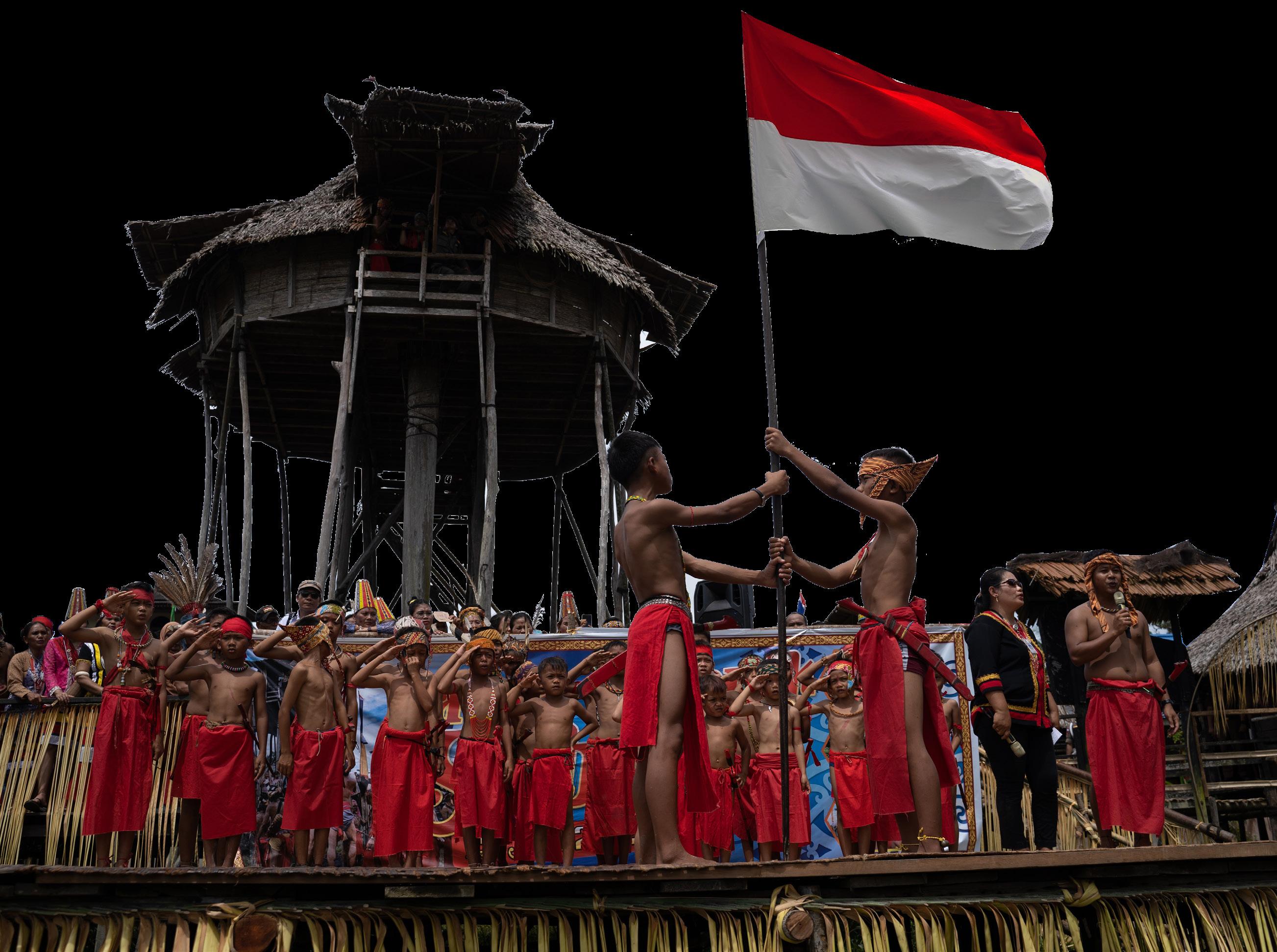
A long time ago, the Dayak Bidayuh tribe who lived in Sebujit hamlet, Lhi Buie Village, Siding District, Bengkayang Regency, West Kalimantan, often fought for the boundaries of their territory and brought home the enemy’s head as a trophy. They kept enemy heads in a baluk house or a traditional house
among the Dayak subtribe. Because of this, the image of the Dayaks is that of headhunters. Why did they head hunt? The Dayak Bidayuhs believed that the human head houses supernatural powers. For the Dayaks, the dried human skull is the most powerful magic in the world and an antidote strong enough to save the whole village from a plague, produce rain, increase crop yields, and drive out evil spirits.
In 1894, the tumbang anoy agreement was born, which was agreed upon by all Dayak tribes in mainland Kalimantan (Indonesia, Malaysia, Brunei Darussalam). It contains a consensus to stop hakayau or headhunting, hapunuh or killing each other, and hatetek or cutting
a ritual. Every year in June, the nyobeng or gawia nibakng ritual becomes a ceremony of peace, gathering with relatives, and paying homage to ancestors. They ask for divine permission, the blessing for the earth’s produce, and divine grace.
The Dayak Bidayuhs perform the nyobeng ceremony to honor the spirits of the ancestors who they believe are still guarding them. They collected enemy skulls from ngayau in the traditional house in the center of the village and bathed and cleaned them every year. Although they were once enemies, they are respected. They passed down that form of respect for generations. The annual nyobeng ceremony symbolizes peace, including for the allied Dayak
Paduapm, invoking the spirits of ancestors in Nyobeng rituals to ask the spirits permission to do the ceremony.
VOL. 15, 2022 INDONESIANA I 57
Love of Indonesia
Implementation of the Ceremony
The nyobeng tradition has become the identity of the Dayak Bidayuh tribe, a tourist attraction, and the most significant annual traditional ceremony for the Dayak community. Because of this, they plan and implement rituals orderly. They need to prepare severale requirements before the rite. Pak Amin, the traditional elder of the Dayak Bidayuh tribe, jointly with the people, prepares various items for the ritual, such as offerings, including betel leaves, areca leaves, slaked lime, tobacco, and gambier leaves. The local people also weave coconut leaves to hang in front of their houses, slaughter a pig, and use its blood to smear each skull.

The traditional elders prepare various offerings dripped with blood from a chicken’s wings.
Before sunrise of the following day, the nyobeng ceremony begins with a ritual of summoning ancestral spirits at the baluk
house, a 15-meter-tall pyramid-shaped traditional house. Pak Amin led the rite. The action of calling for and asking for the permission of the ancestral spirits is via chanting and the beating of the sibakang or drum and other traditional musical instruments. The aim is to encourage men to be brave in facing the enemy. In today’s context, the enemy can be very diverse and personal.
After they open the baluk house, the traditional mantras and music performed inside the house must continue playing without stopping. The music played is also a sign of friendship. The neatly arranged offerings hint that the nyobeng ritual is about to begin. But before that, the traditional elders and the community gathered in the courtyard of the baluk house. Then they performed a bamboo cutting ritual for sangiang or a place for offerings. The traditional elders and the knights continue the rite with namwey or welcoming guests by slowly descending
from the baluk house and walking towards the village boundary.
At this stage, they greet the guests who are members of the group as if they had just returned from headhunting. They organize the reception wearing a full traditional attire of sumpit, mandau or Dayak saber, and muskets. They sounded the muskets when they entered the village boundary. The customary elders and knights also let out warrior’s cry while brandishing their weapons. Shouting warriors’ cries and loud banging are the requirements for summoning the spirits of the ancestors and asking for permission to carry out nyobeng
Before guests are permitted to enter the village, one woman throws a chicken egg at a guest. The egg doesn’t crack means that the guests are insincere or still in doubt. Conversely, the egg breaks upon contact with the guests means that they come sincerely without hesitation. They
58 I INDONESIANA VOL. 15, 2022
Setting up ceremony venue (above) Baluq house warming ritual; (below) Guest welcoming ceremony
then served guests food and soft drinks. They also receive yellow rice to be thrown downwards for spirits and white rice to be thrown upwards for Tipa Iyakng (God). The traditional leader read a prayer, and they escorted guests to the baluk house.
The ritual of cutting off a dog’s head is one of the rituals that attracts attention. The dog’s head is an offering for the ancestors and a repellent for evil. After, the traditional elders, the community, and the guests dance together.
One ritual for entertainment in nyobeng is panjat aur or climbing a tree upside down. The elders cast a spell, ascend the bamboo poles, and sprinkle water onto the participants with amhuang leaves. All participants dance around a bamboo pole. This tradition is said to be carried out by warriors to show their strength.

For the Dayak Bidayuh tribe, nyobeng is a celebration, worship, and an expression of joy. People from various tribes gather to perform dances during festivals, for harvest thanksgiving, or for wedding ceremonies. Performances at weddings are popular as they attract many relatives to attend. Nyobeng is undoubtedly a significant part of the Dayak culture that brings people together. The nyobeng dance has developed into a unique art form that appeals to traditional and nontraditional audiences. Malaysians always participate in every nyobeng. It is not solely because they are part of the Dayak Bidayuh family but also because Hli Buei (Sebujit) village is on the IndonesiaMalaysia border.
The Dayak Bidayuh live in a tradition of kinship and also believe in the supernatural powers of the primitive people around them. They are part of

nature, so they often make sacrifices or offerings in respect for nature. Through rituals, they ask for the blessings of birth, death, and salvation. The Dayak Bidayuh has a way of paying homage to ancestors and honoring deaths based on mythology. In this context, mythology makes people realize that there are magical powers in this world, and mythology helps humans to appreciate this ability to influence and control the forces of nature and tribes.
Nyobeng was a celebration of victory over enemies and is now an expression of gratitude for one year’s harvest and praying for them to live in peace.
(Darus Hadi, Directorate of Belief in One God & Indigenous Peoples, Directorate General of Culture, the Ministry of Education, Culture, Research and Technology (MoECRT))
Directorate of Belief in the God Almighty and Customary Law Communities
VOL. 15, 2022 INDONESIANA I 59
Photo courtesy of (Darus Hadi, Directorate of Belief in the God Almighty and Customary Law Communities, Directorate General of Culture, the Ministry of Education, Culture, Research and Technology (MoECRT))
Revitalizing the North Maluku Local Language Ngom Ua Nage Ana Adi

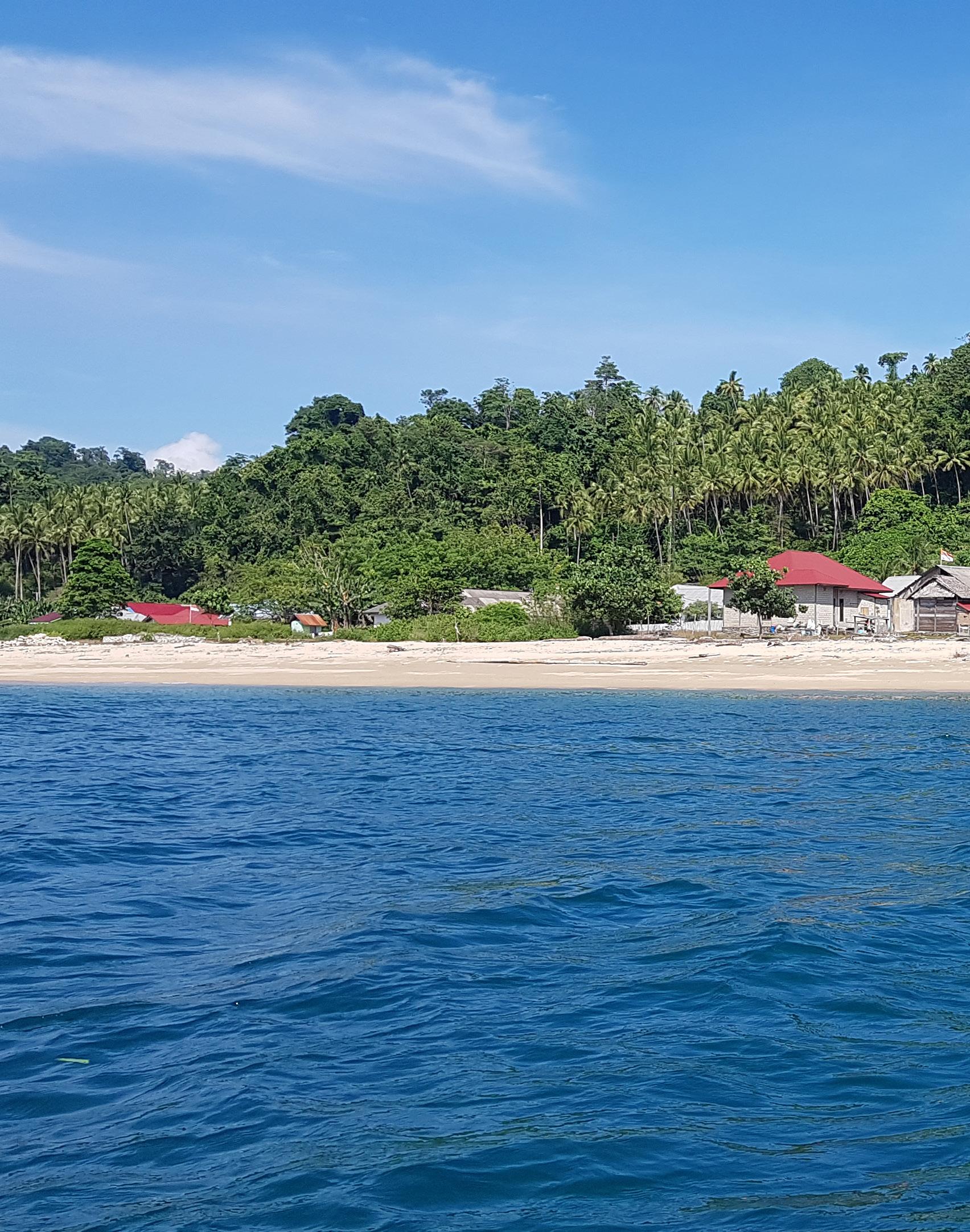
Speakers of regional languages have declined in recent years because of several factors, among which native speakers are reluctant to use their local languages in everyday life. The native speakers are hesitant to speak their local language because of a mindset that using the local language at home daily is ignorance. Mastery of local languages makes children or students “lazy” to use Indonesian as the state language. Of course, this way of thinking is wrong and contrary to efforts to preserve regional languages.
Prioritizing the state language becomes an absolute thing. However, prioritizing the state language must provide space to preserve regional languages as part of the nation’s cultural wealth, then mastering foreign languages to support the nation’s global competitiveness. It is
Development, Ministry of Education, Culture, Research, and Technology to prevent the loss of regional languages through a revitalization of regional/ local languages. There are endangered regional languages, one of which is in North Maluku Province. So, the Minister
LANGUAGES
60 I INDONESIANA VOL. 15, 2022
revitalization policies need to be a big concern for local governments. This program is the first step in efforts to increase local language speakers.
Article 42, paragraph (1) of Law Number 24 of 2009 is on the National Flag, Language, Emblem, and Anthem. It specifies that “Local governments shall develop, foster, and protect regional languages and literature so that they continue to be in their position and function in social life according to
their time and so they continue to be part of Indonesia’s cultural wealth.” Therefore, the role of local government in safeguarding regional languages is mandatory.


BPPB has carried out regional language mapping (data of 2019). The data shows 19 regional
languages spread across nine districts/ cities in North Maluku. The nineteen local languages are Bacan, Bajo, Buli, Galela, Gane, Gorap, Ibu, Kadai, Inner/ Eastern Makean, Outer/Western Makean, Malay, Modole, Patani, Sahu, Sawai, Sula, Taliabu, Ternate, and Tobelo. The data differs from Article 1 paragraph (8) of North Maluku Provincial Regulation Number 9 of 2009 concerning the Maintenance of Regional Language and Literature, which states that 31 regional languages grow and develop in North
VOL. 15, 2022 INDONESIANA I 61
A village on the coast of Mangoli Island, Sula Islands Regency
Maluku. Looking at the number of regional languages in the two regulations, we can see that there has been a decline in 12 regional languages in ten years. Preventing regional languages from extinction through revitalizing regional languages is a necessity.
Article 23, paragraph (1) of Presidential Regulation Number 63 of 2019 concerning the Use of Indonesian states, “we shall use Indonesian as the language of instruction in national education.” Paragraph (2) sets forth, “Indonesian as the language of instruction in national education as referred to in paragraph (1) shall be used at all levels of education.”
Further in paragraph (3), “Apart from Indonesian as referred to in paragraph (1), regional languages can be used as the language of instruction in elementary schools, madrasah ibtidaiyah (Islamic elementary schools), or other equivalent forms in the first and second year to support learning”. Therefore, the use of regional languages should increase the competence of students in the regions, not the other way around, as an obstacle, so that the existence of regional languages survives and the number of speakers increases.
Revitalization of the Four Languages
The relevant government will revitalize four regional languages in North Maluku in 2022, namely the Ternate language in Ternate City, the Sula language in the Sula Islands Regency, the Tobelo language in North Halmahera Regency, and the East Makean language in South Halmahera Regency. Revitalisasi Bahasa DaerahRBD (Regional language revitalization) activities organized by the Regional Office for Language in North Maluku Province include master teacher training which continues monitoring until after the

62 I INDONESIANA VOL. 15, 2022
A local fisherman on the waters of the Sula Islands
post-training and implementation of the ‘Festival Tunas Bahasa Ibu-FTBI’ (Mother Language Festival for Young Learners) at the district/city and provincial levels. Previously, stakeholders met to equalize perceptions.
Training of Trainers or Master Teachers’ Training carried out in each district/city is the target of RBD. The training aims to train local language teachers/instructors to teach the local language to other teachers, students, or fellow students. Meanwhile, the monitoring post-master teachers’ training aims to monitor the impact of regional language teaching. The master teachers have applied their language-teaching knowledge in schools and communities. The results are, on average, schools and the public
have carried out post-training teaching imitations and prepared students for the Mother Language Festival for Young Learners.
Two local governments of North Halmahera Regency and Sula Islands Regency will implement Regency/city-level FTBI in North Maluku Province in 2022. South Halmahera Regency and Ternate City can join the provincial-level FTBI based on monitoring data by the North Maluku Province Language Office and recommendations from related agencies. They hold the FTBI as an appreciation for teaching regional languages in competitions. There are six categories at the provincial level of FTBI. The competition categories are storytelling, poetry reading, and traditional songs for elementary school students; speech
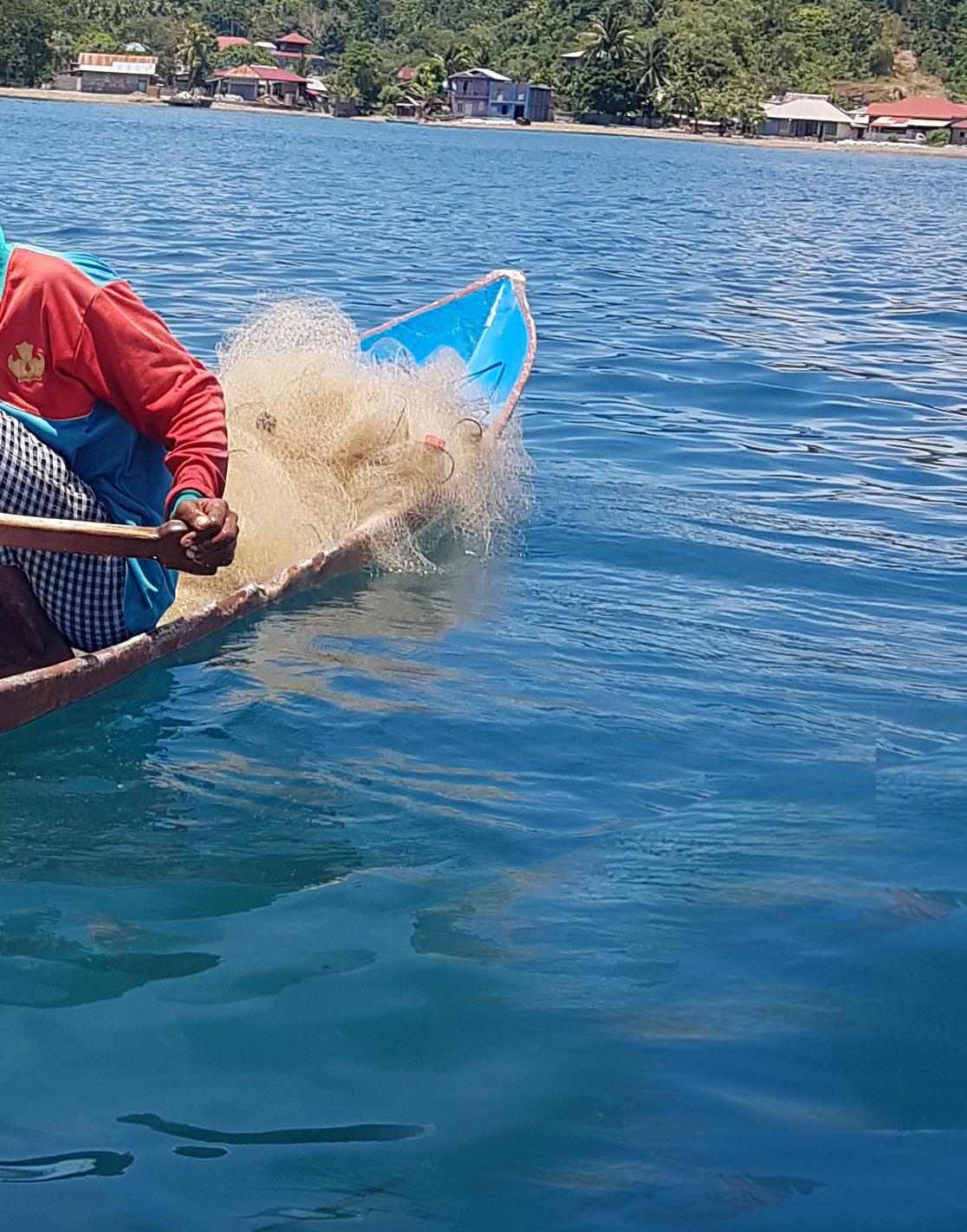
contests, short story writing, and solo or stand-up comedy contests for junior high school students.
The government expects regional language revitalization can increase regional language speakers among the younger generation to preserve regional languages for daily use. The urgency of revitalizing regional languages is in line with the statement that one extinct language equals one extinct civilization, and building a civilization takes thousands of years. Ngom ua nage ana adi, if not us, who else? Come on, save and preserve the local language!
(Nurul Istiqmallah, S.H., M.H, Regional Office for Language in North Maluku Province, MoECRT).
VOL. 15, 2022 INDONESIANA I 63
Photo courtesy of Nurul Istiqamallah
Updates from the
Coal Mining Heritage

he Ombilin Coal Mining Heritage of Sawahlunto (OCMHS) is a technological ensemble clustered into integrated heritage areas with outstanding universal value and is currently listed as a UNESCO World Heritage site. It is an integrated colliery and transportation network for transporting coal from the mining site, passing through the railroad tracks along Lake Singkarak, then arriving at the final destination, namely the final coal storage area located on Sumatra’s west coast before being transshipped to Europe. Competition among colonial countries to control strategic energy resources
also encouraged the Netherlands East Indies Government to search for energy resources in their colonies. The discovery of a large number of coal deposits in the Ombilin Basin, Sawahlunto, West Sumatra, drew the interest of the Dutch Government to invest in coal mining operations in the area due to its enormous potential and value. The opening of the first OCMHS coal mine sites in Sawahlunto began in 1891. The construction of the coal mining infrastructure and integrated transportation network to the final coal storage area was built in stages until the early 1900s, following the development needs at that time.
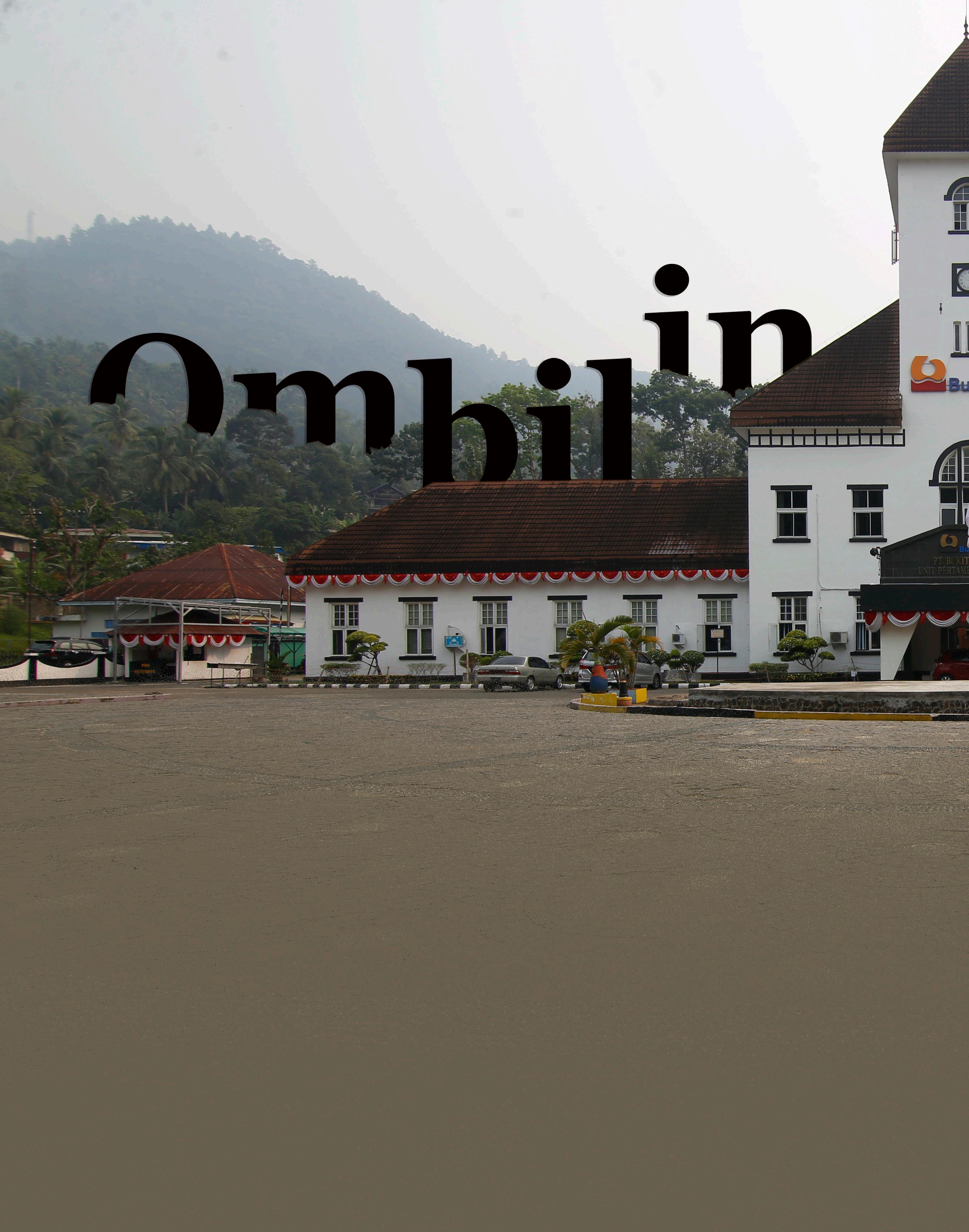
WORLD HERITAGE
64 I INDONESIANA VOL. 15, 2022
Since its first discovery and operation, the ownership and management of the Ombilin coal mine have changed several times. Nevertheless, the exploitation and management of the Ombilin coal mine continued until the 1980s, when it was declared that the exploitation of the Ombilin coal mine was no longer efficient and mining exploitation activities were completely stopped in 2002. Nearly 40% of the population of Sawahlunto, the majority of whom are mine workers, started to leave the city leaving the city to slowly become a ghost town.
In 2001, the then Mayor of Sawahlunto, Amran Noor, established the vision
of the city of Sawahlunto which set “Sawahlunto as a Cultural Tourism Mining Town in 2020”, as the first step to develop and revive the city. On the one hand, the city development plan to revive the city helped build the optimism of the people of Sawahlunto City. But on the other hand, there were concerns from conservationists whether the development would destroy the mining heritage value of the city, as development is often closely linked with destruction of heritage.
Therefore, nominating the OCMHS to become a UNESCO World Heritage site
was considered as an important step to support city preservation, which eventually could also support the revival of the city and bring prosperity to the local community through site visits.
Attributes of the Property to be Preserved
The Ombilin Coal Mining Heritage of Sawahlunto comprises of 12 cultural heritage component parts located in 7 cities and regencies in West Sumatra Province – namely Padang Municipality, Padang Pariaman Regency, Padang Panjang Municipality, Tanah Datar Regency, Solok Municipality, Solok Regency and Sawahlunto Municipality –

Mak Itam steam locomotive VOL. 15, 2022 INDONESIANA I 65
The grandeur of Bukit Asam Company Office’s colonial architecture
with a total area of 268.18 hectares within a buffer zone of 7,356.96 hectares.
Area A: Sawahlunto Mining Site and Company Town, comprise of:
- Component A1. Soengai Doerian Mining Site (which includes 5 attributes: Doerian Mining Pit Compound, Pandjang Mining Pit Compound, Soengai Doerian Mining Pit Compound, Loento Mining Pit Compound, Mining Tunnel).

- Component A2. Mining School (which includes 1 attribute: Mining School)
- Component A3. Coal Processing Plant Compound (which includes 1 attribute: Coal Processing Plant Compound).
- Component A4. Ombilin Railway Transportation (which includes 4 attributes: Sawahlunto Train Station, Kubang Sirakuak Power Plant, Kalam Railway Tunnel, Muara Kalaban Train Station).
- Component A5. Company Town (which includes 5 attributes: Mining
Administrative Compound, Labour Quarters Compound, Health Facilities, Market, Supporting Facilities).
- Component A6. Salak Power Plant and Rantih Water Pumping Station (which include 2 attributes: Salak Power Plant and Rantih Water Pumping Station).
Area B: Railway Facilities and Engineering Structures, comprise of:
- Component B1. Railway System (which includes 1 attribute: Railway System).
- Component B2. Batu Tabal Train Station (which includes 1 attribute: Batu Tabal Train Station).
- Component B3. Padang Pandjang Train Station (which includes 1 attribute: Padang Pandjang Train Station).
- Component B4. Tinggi Bridge (which includes 1 attribute: Tinggi Bridge).
- Component B5. Kayu Tanam Train Station (which includes 1 attribute: Kayu Tanam Train Station).
Area C: Coal Storage Facilities at Emmahaven Port (now Teluk Bayur Port), comprises of:
- Component C1. Silo Gunung Coal Storage (which includes 1 attribute: Silo Gunung Coal Storage).
Preservation Efforts
Nominating the OCMHS to become a UNESCO World Heritage was part of the efforts to continue to develop the region, empower the local community, whilst also promoting the preservation effort. In other words, the preservation and promotion of cultural mining heritage resources combined with community development and empowerment would lead to the sustainable development of the site. This is also in line with the Indonesian government’s cultural diplomacy agenda in increasing the quality of cultural heritage conservation and improving the quality of life and welfare.
66 I INDONESIANA VOL. 15, 2022
Utilizing the ex-mining air vent of the Soegar mining site to become a tourist attraction
However, the preservation efforts are not without challenges. There are a number of conservation issues within the OCMHS area, such as the potential damage to the area’s landscape due to illegal mining, the deterioration and lack of maintenance of buildings or infrastructures that are part of the attributes of OCMHS, and development plans within the area. These conservation issues are to be resolved through collaborative measures among related management parties.

For example, to address the issue of illegal mining in former mining areas in Sawahlunto Municipality, PT Bukit Asam, Tbk (Bukit Asam Company), as the owner of the area and concession, has proposed an extension of the concession for its coal mining control area. This was intended to protect the area from illegal miners, as well as to protect against the possibility of new mining permits being granted by the relevant ministries to the current illegal miners.
In addition, the mining permit extension of PT Bukit Asam Tbk also allows deep mining practice tests by a mining school built within the area. Thus, the current mining practice in the area is being conducted on a very small scale for educational purposes only. On the issue regarding deterioration and lack of maintenance of buildings
or infrastructures that are part of the attributes of OCMHS, the national government (through the Technical Implementation Unit) in collaboration with the local governments, had been registering buildings that are attributes of OCMHS on the List of
UNESCO World Heritage List in 2019, the level of tourist visits to the OCMHS area had increased. However, this did not last long due to the Covid-19 pandemic that hit the world. The regional quarantine period in 2020-2021 to reduce the number of people exposed to the Covid-19 virus had been used by OCMHS site managers to carry out routine maintenance and monitor the condition of their assets in Sawahlunto Municipality and along the Sawahlunto-Teluk Bayur railway.
In addition, there are also a number of recommendations suggested by the UNESCO World Heritage Committee for the conservation of the site. The Indonesian government has been working to fulfill its obligation following the recommendations in ensuring the site will continue to sustain its outstanding universal value. This is also part of Indonesia’s efforts to safeguard its cultural heritage for the future.
Cultural Heritage Objects, both at the local level and at the national level. Meanwhile, at the community level, the government has been educating the community and disseminating information on the “Dos and Don’ts” of cultural heritage object preservation, especially on objects with world heritage status.
Regarding development plans within the area, the government has initiated the implementation of the Heritage Impact Assessment (HIA) on several attributes. After the OCMHS was inscribed on the
(Prita Wikantyasning, Senior Cultural Administrator, Directorate of Cultural Development and Utilization, Directorate General of Culture,
VOL. 15, 2022 INDONESIANA I 67
MoECRT)
VOL. 15, 2022 INDONESIANA I 67
Photo courtesy of Alfian Siagian
Rumah Tuo Kampai Nan Panjang

Past Lessons for the Future
The sustainable architecture movement is a current topic of discussion, as identified from housing design trends that carry the concept of an open floor plan without partitions and large open spaces. This movement arose out of the need to address the growth of the built environment, which was unaccompanied by wise planning, so it became one contributor to global climate change. Planning is getting away from local climate adjustments, relying on technology as climate engineering, which causes wasted energy and increases carbon emissions.

VERNACULAR ARCHITECTURE
68 I INDONESIANA VOL. 15, 2022
Union Internationale des Architectes (UIA), a non-profit association of architects representing more than one million architects in 124 countries, states that many buildings and construction industries impact climate change from the conversion of green open space into a built-up area, the development process, to the utilization of the building. So, do we realize that Indonesian vernacular buildings have used the concept of sustainable architecture for a long time?
Sustainable architecture is environmentally sound architecture with the principle of creating a built environment that is in harmony with its surrounding environment. Indonesia’s rich vernacular architecture can be a source of inspiration and teaching for ecological value application in developing the built environment. Local communities develop their vernacular constructions through a trial-and-error process. Everyday experience is a reference for every planning decision.

We can achieve the sustainable architecture principle through a passive design method, namely designing buildings according to local natural conditions, such as in building vernacular buildings. This method emphasizes the quality of space: thermal comfort, light, natural ventilation, and the health of building users. Passive design buildings will use the land wisely by integrating landscape into the design, per Building Base Coefficient.
Traditional House of Minangkabau
Developed in the 1700s, rumah tuo kampai nan panjang, or a traditional Minangkabau house, is an example of sustainable architecture. It is the oldest traditional house in Nagari Balimbing, Batusangkar of West Sumatra, founded by Dt. Penghulu Basa from the Kampai clan. They registered this house as a cultural property protected by the State. The philosophy of “alam takambang jadi guru” (nature unfurled becomes a teacher) is a pearl of local wisdom that guides the construction of “Rumah Gadang” (the big house). Na-
ture is a source of traditional knowledge, so the house blends perfectly into the landscape with a charming design that blends right in with its hilly backdrop.

Not only is it responsive to the climate, but rumah tuo also adapts to the needs of its owners without losing its beauty. A Rumah Gadang not only functions as a place to live but also as a place to teach children, nieces, and nephews, as well as to accommodate the clan activities of deliberation, batagak pengulu, and other customary activities. The proverb ”Tampek maniru manuladan, paaja baso jo basi, sarato budi jo malu, kok tumbuah dilantai tampek duduak, banamo data lantai papan, licin balantai kulik, kato munfakat nan tujuan, elok diambiak jo mufakat, buruak dibuang jo rundiangan“ becomes the foundation.
The layout of the main room of Rumah Gadang is designed without partition (an open floor plan) to accommodate many people. At the back are rooms for girls, following the matrilineal kinship system

VOL. 15, 2022 INDONESIANA I 69
Rumah Kampai Nan Panjang (Kampai longhouse)
adopted by the Minang clan. Boys sleep in the main room, but once they reach puberty, they sleep in the surau (small mosque). The layout of rumah tuo divides the house into two: the front is the main room with no partitions to accommodate activities for families, clans and traditions, the living room, and the kitchen. The back is biliak (bedroom).

Rumah tuo kampai nan panjang applies a passive design that responds to the surrounding environment. We can see it from the selection of forms in all or parts of the building. The climate in Batusangkar is very humid with heavy rainfall, cold at night until morning, and hot during the day. A steep roof design overcomes high rainfall intensity, so rainwater quickly falls and dries up. The said affects the durability of the roofing material, bearing

in mind that the original roofing material is palm fiber, which is prone to damage. To deal with the temperature, houses like this have many wide openings and use wood and bamboo materials which are warm when the weather is cold and cool when the weather is hot. The high roof plays a crucial function in controlling room temperature. This house maximizes using natural resources as energy sources, especially for lighting and ventilation.
Although made of wood and bamboo, rumah tuo kampai nan panjang still survives today, dating back over 300 years. No wonder the wood selected for the main structure and architectural elements is quality wood by following local wisdom regarding wood selection, logging, and preservation so that the wood can last for hundreds of years. The construction
of rumah tuo leaves no waste because it uses natural materials.

Another important thing is that of the total land area of 1600 m2, only 147 m2 land is for the built area, about 10% of the land area, while 90% is for green open space. We can say that the carbon emissions produced in the rumah tuo environment are insignificant; space comfort exists when there is a balance between carbon emission and absorption from the atmosphere in carbon sinks. Trees, plants, and soil are the most effective natural carbon sinks, available in large quantities and readily available.
Based on data from the Ministry of Energy and Mineral Resources, alluvium deposits (silt, sand, and gravel, including swamp deposits) majorly composed the
70 I INDONESIANA VOL. 15, 2022
soils in Batusangkar. The andesite of Mount Merapi, which is of the Quaternary Period, experienced rapid weathering associated with the Semangko active fault zone, so Batusangkar is an earthquake-prone area. Aware that the region is prone to an earthquake, this rumah tuo uses traditional techniques that can reduce damage to buildings during an earthquake. We can see this technology from the selected materials for architectural elements, such as wood, bamboo for walls and floors, and palm fiber for roofs, which are flexible and lightweight but remain sturdy for structural components.
The main frame of the rumah tuo is made of straight wood without joints and must meet predetermined requirements. They designed structural elements to be flexible to absorb earthquakes by using
non-rigid joints connecting each main frame. The connection between the frame uses a system of hooks, ties, and wooden pegs, which are still flexible in receiving shocks. According to research, bamboo can respond to forces generated by earthquakes better than concrete and steel.

The Minangkabau people seek the location to build a Rumah Gadang by following an adage from their customary tradition:


Nan lereng ditanam tabu, nan tunggang ditanam buluah, nan gurun buek ka parak, Nan bancah jadikan sawah, nan munggu ka pandam pakuburuan, nan gauang ka tabek ikan, nan lambah kubangan kabau, nan padek ka parumahan. The adage conveys a message to use nature accordingly; they believe in land doesn’t need a lot of intervention to change. In choosing the
location for the house, for example, it must be on level and strong soils so that the ground is more stable for the building stone footings (sandi). Remember the adage, sandi aman tiang selamat (strong footings, safer houses)
Rumah tuo, the old vernacular houses, have been proven to last for hundreds of years. We can use them as a reference for sustainable architecture principles from Indonesia. We can adopt the philosophy used to build the house to today’s modern buildings, not in terms of mass and shape, but the way rumah tuo responds to the natural environment and the user community.
(Rohilfa Riza, S. Ars, Directorate of Cultural Development and Utilization, Directorate General of Culture, MoECRT)
VOL. 15, 2022 INDONESIANA I 71
Photo courtesy of Rohilfa Riza
Miss Tjitjih
th
The Sundanese theater group Miss Tjitjih will celebrate its 95th anniversary in 2023. The establishment of this Sundanese theater (toneel) group was initiated by the meeting between the Sumedang Sundanese theater diva, Miss Tjitjih, and Sayyed Aboebakar Bafaqih, the owner of a traveling theater (komedie stamboel). The meeting took place in Sumedang when the traveling theater group toured cities in West Java.
According to Dadang Badoet, actor and director from Miss Tjitjih Theatre Group, in 1926 Aboebakar Bafaqih presented his traveling theater in different locations in West Java. At one point, this Malay-speaking theater group performed in the city of Sumedang where Bafaqih met and was smitten by the multi-talented and beautiful Nyi
Tjitjih, who played and sang with her local theater troupe in Sumedang.
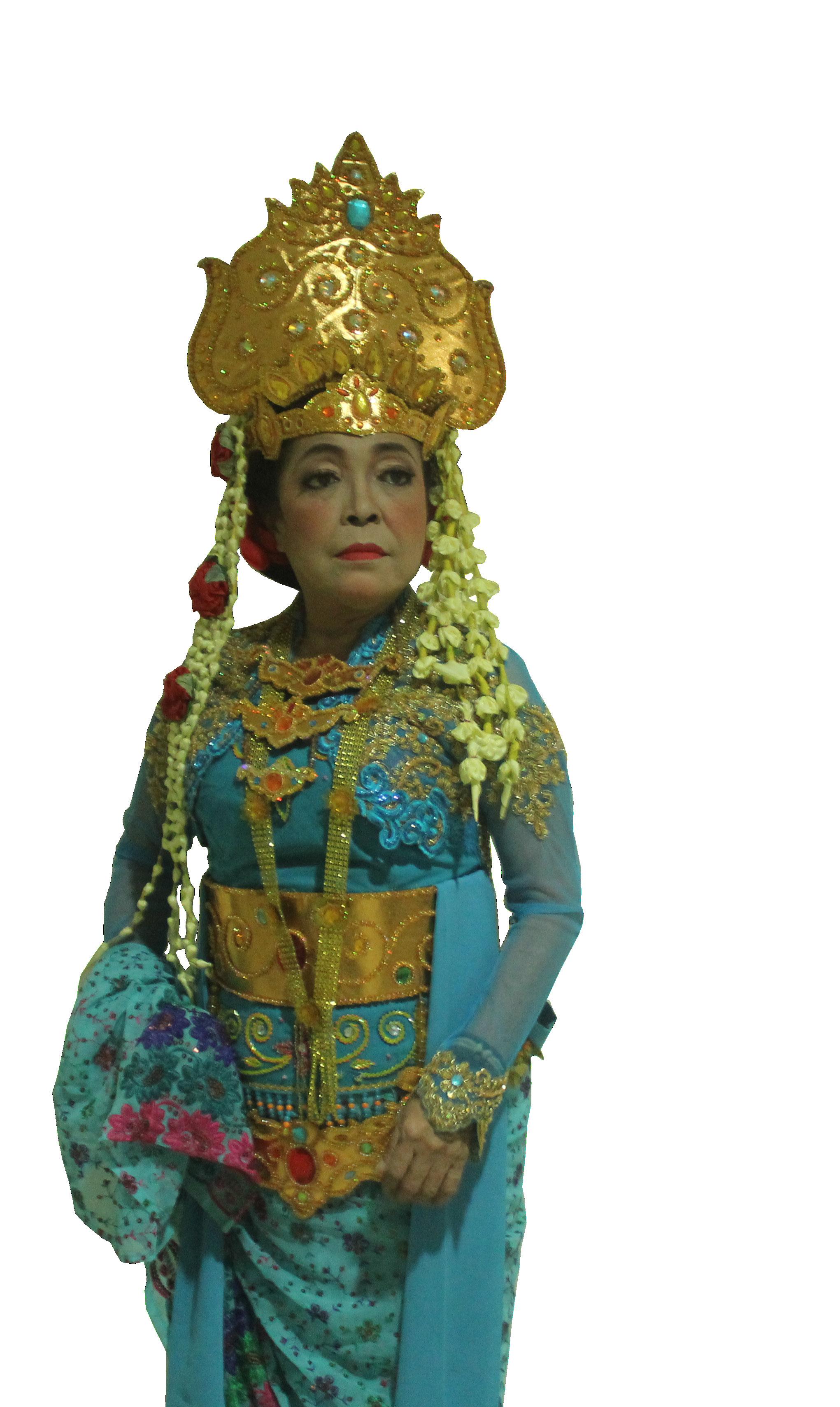
Syarifah Rohmah or Bu Omah, Miss Tjitjih’s current director, said that at that time, Bafaqih was fascinated by Nyi Tjitjih’s talent, who at the age of 18 was very good at acting, singing and dancing. Indeed, in 1926, Nyi Tjitjih was frequently invited to perform her artistic abilities in front of the Sumedang regent and his esteemed guests.
After the meeting, Bafaqih invited Nyi Tjitjih to come to Batavia and join the Opera Valencia – a traveling theater group he had just established. The invitation was welcomed by Nyi Tjitjih, and from then on Nyi Tjitjih became part of the Opera Valencia. Bu Omah further explained how Nyi Tjitjih, who was born in Sumedang in 1908, was able to make
PERFORMING ART
Approaching the 95 Anniversary of Sundanese Theatr e 72 I INDONESIANA VOL. 15, 2022
the Opera Valencia become popular. Her performance and intelligence were greatly appreciated by the pribumi (native Indonesians) in Batavia, even though Nyi Tjitjih only spoke Sundanese, her mother tongue.
Miss Tjitjih Theatre Group
The story of Miss Tjitjih Theatre Group is closely linked to the Bimanyurupa Bangsawan traveling theater group led by Abubakar Bafaqih who came to Sumedang in 1926. Dadang Badoet, a young director from Miss Tjitjih Theatre Group, reflects that Nyi Tjitjih at first was just an innocent girl from Sumedang. She was beautiful, creative and full of discipline. Throughout her journey, Nyi Tjitjih grew as the prima donna of
the Opera Valencia under the direction of Bafaqih who was very skilled in developing storytelling, compositions, and theatrical techniques following his experience with the Bimanyurupa Bangsawan. In a short time, the group became one of the most popular groups and was frequently asked to perform in many different places, from one stage to another. As a tribute to Nyi Tjitjih performance, the name Opera Valencia was changed to Miss Tjitjih Toneel Gezelschap in 1928 and the play was no longer performed in Malay but in Sundanese.
Bu Omah told us that in 1928 the Miss Tjitjih theater group initially occupied an empty lot next to the REK Cinema in the
Kramat Munde Senen area in Central Jakarta. Since its establishment, Miss Tjitjih has become an important part of the life of the people of Jakarta at the time. This theater group has become increasingly famous and Miss Tjitjih has enriched the cultural life of Jakarta. In 1931, the theater group was invited to perform at the Bogor Palace. The invitation indicated how this theater group was appreciated by the Dutch Colonial government at that time.
According to Dadang, as told for generations in the Miss Tjitjih group, Miss Tjitjih was a very productive group and had delivered several performances not only in Jakarta but also in West Java and Central Java. Repertoires such as Gelung

VOL. 15, 2022 INDONESIANA I 73
Syarifah Rohmah (Bu Omah) after performing “Mencari Kembang Wijaya Kusuma” (Finding Wijaya Kusuma Flower) at the Large Theater of TIM
Miss Tjitjih’s extended family accommodation at Cempaka Putih, Jakarta
Ciyoda (Ciyoda Bun), Gelung Cianjur (Cianjur Bun), Gejed Milo, Karnadi Bandar Bangkong (Karnadi the Merchant Frog), Eulis Acih, Gagak Solo, Srigawa, Bentang Jaarbeurs (Jaarbeurs Stars), Kalepatan Putra Dosana Ibu Rama (Children’s mistakes are parents’ sins), and Mugiri were the signature performances which the group performed live on stage for the audience. Most of these plays are indeed derived from the Sundanese stories.
“Any place could be used as a stage,” said Dadang. Miss Tjitjih performed at cinemas, squares, markets, or even at empty fields. The people at that time took
turns to invite Miss Tjitjih to perform and therefore the group had to move around. Dadang said that all theater props and stage equipment had been compactly arranged so they could be easily transported from venue to venue.
Miss Tjitjih and Theatrical Adaptation
What was unique about Miss Tjitjih is that this theater group had always been delivering their performance in Sundanese, mainly due to Nyi Tjitjih herself could not speak Malay — the language used in the culture of the Stamboel theater groups at that time.
Miss Tjitjih theater group has been loyal to Tatar Sundanese tradition. This Sundanese tradition was also what differentiated this group from other theater groups that existed in the early 20th century, such as Miss Riboet, Miss Dja, and Dardanella.
Nonetheless, Miss Tjitjih did not stop at this point. Miss Tjitjih also tried to look at other traditions, namely European traditions. Dadang Badoet, who graduated from ISBI Bandung (Indonesian Arts Institute and Culture in Bandung), explained that Miss Tjitjih had also performed the Sundanese version

74 I INDONESIANA VOL. 15, 2022
Miss Tjitjih’s collaborative performance with a traditional theater group playing “Mencari Kembang Wijaya Kusuma”.
of the Hamlet manuscript, which was translated by Balai Pustaka. Dadang Badoet added that this was a sort of “adaptation” of an internationally wellknown play by a local theater group.
In January 2019, the Miss Tjitjih theater group performed a Sundanese adaptation of Hamlet at the University of Indonesia’s Makara Art Center. For Miss Tjitjih, this performance was part of a ‘local’ theater group’s effort to reach to contemporary audiences while keeping its Sundanese identity by consistently performing in Sundanese during a ‘new’ era when Sundanese play has been losing its audience in competition with other contemporary spectacles.


Miss Tjitjih plays an important role in the preservation and development of local arts and culture, especially Sundanese culture of West Java. Even though Nyi Tjitjih could not enjoy the fame of her theater group, she was considered as a Sundanese icon thanks to her loyalty in her work. Nyi Tjitjih died on 27 August 1939 after performing on stage as Sulastri in the story of Gagak Solo.
To appreciate Nyi Tjitjih’s loyalty in her work, on the initiative of the Provincial Government of DKI Jakarta and the West Java Development Foundation, in 1987 the Miss Tjitjih Theatre Building was built on Jalan Kabel Pendek in Cempaka Putih, Central Jakarta. Even though her prestige has faded, Miss Tjitjih continues to survive.
VOL. 15, 2022 INDONESIANA I 75
(Alfian Siagian, Indonesiana)
(above) Mrs. Imas (wearing hijab/director of Miss Tjitjih), Mrs. Omah (Chairman of Miss Tjitjih), and several supporting actors of Finding Wijaya Kusuma Flower ; (below) Miss Tjitjih’s performers/actors are ready to perform
Photo courtesy of Alfian Siagian
A Sweet Taste of Kipo, a Bite of Memories
Kaypoh (Chinese Hokkien dialect: really curious) about kipo? Come to Kotagede Yogyakarta Market, the center of kipo. The government designated the traditional simple light snacks as an intangible cultural heritage (WBTb, or Warisan Budaya Takbenda) of Indonesia on 15 August 2019. Kipo, a local snack commonly known as jajan pasar or market snacks, is said to only exist in Kotagede, and only a handful of people know how to make it. Hmmm…, is it true?


TRADITIONAL CUISINE
76 I INDONESIANA VOL. 15, 2022
At first, we didn’t believe we could only find a kipo seller in Kotagede. It is different now since you can buy pisang ijo (lit. green banana), a banana-based dessert from Makassar, in Jakarta. You’ll be able to shop for different snacks from various regions at the central souvenir shop. So, before heading to Kotagede Market, we stopped by Pathuk Market to look for kipo. None of the hawkers (street vendors) were selling them. However, we are not sure whether other markets sell kipo.

We bought the
last ten packs of kipo at a traditional food stall at Kotagede Market. One pack contains five kipo the size of one knuckle of the thumb. Because of the small size of the kipo, one is not enough; five might or might not be enough. There must be a reason kipo is made small, maybe to make it easy to eat in small bite-sized snacks. One kipo is enough if you only want to taste it. The size makes kipo unique and distinctive, which is why people will remember it.
The combination of the sweetness of palm sugar, the savory of grated coconut, and the fluffiness of glutinous rice flour are just so delicious. Many traditional snacks, for
example, mendut cakes, ku cakes, poci cakes, and dadar gulung (lit. rolled pancake), use enten-enten or coconut fiber fillings, a mixture of grated coconut and brown sugar. However, other ingredients make the taste of each snack different, hence the different names. Methods of cooking and packaging also make each confectionary unique.
In the past, confectionery or snack dish was simple and adjusted to the needs.
The name kipo is said to be short for iki opo? (what is this?), a short interrogative sentence that children usually ask when they see a nameless snack. People make kipo traditional wet cake by grilling.
The main ingredients are glutinous rice flour, grated coconut, and brown sugar. The other ingredients include suji leaves for coloring,
Iki opo? (What is this?)
Photo courtesy of Zul Lubis
The market that sells kipo
VOL. 15, 2022 INDONESIANA I 77
Photo courtesy of Pasang Budy
tapioca flour for the coconut shell dough mixture, and betel lime for the skin dough mixture.
The manufacturing process is simple. Kipo makers make kipo skin of glutinous rice flour mixed with suji leaves and betel lime liquid extracts. The filling is entenenten or coconut, a mixture of grated young coconut, brown sugar, and tapioca flour, thoroughly mixed until smooth and not sticky. We grilled kipo after we put the enten-enten filling into the glutinous skin dough and shaped it into small pieces the size of a thumb. Kipo grilling traditionally uses a clay grill covered with
banana leaves smeared with cooking oil. We must turn kipo over several times until cooked.


Flipping kipo by hand is painstaking work, which often makes people impatient. One kilogram of glutinous rice flour can produce 80 servings or portions, with one serving containing 5-6 kipo wrapped in banana leaves. It takes one hour to make 25 servings. We can produce dozens of servings in one hour if only the grill is large.
people might have thought about that, but the result will be different, and kipo traditional snack has always been made traditionally.


Mataram Noble Confectionery
Kipo is said to have been one of several types of confectionery for the nobles of the Mataram Palace, but it waned with the fall of the Mataram Kingdom and became a treat for the masses. In the 80s, kipo almost disappeared from the list of market snacks, especially in Kotagede, because nearly no one was producing it. Only Paijem Djito Soehardjo, a woman

78 I INDONESIANA VOL. 15, 2022
Photo courtesy of Zul Lubis
com/premium-photo/kipo-traditional-food-fromkotagedeyogy a kartaindonesia
Image source: https:// www freepik
from Kotagede, never stops making kipo and participating in exhibitions and competitions to revive kipo’s reputation.
It began in 1986 when Bu Djito took part in a food exhibition made from glutinous rice flour at the Ambarukmo Palace Hotel. The Tourism Office and PHRI held the event, and Bu Djito won fourth place, as quoted from a book titled Kipo Bu Djito: Makanan Khas Kotagede Asli dan Pertama published by the City Library and Archives Office of Yogyakarta (2018). Since then, she has participated in many exhibitions, such as that at Manggala Wana Bakti Jakarta attended by Tien Soeharto, and the Yogyakarta Hadiningrat Palace Exhibition of Yogyakarta’s Traditional Art and Rare Food (1990). Kipo is becoming more and more well-known, not limited to Yogyakarta, let alone Kotagede. Kipo has become a mandatory snack for guests, weddings, and various events.

Mbah Mangun handed over kipo making to her daughter because her eyesight was getting worse. Since then, the family-owned kipo stall on Jalan (street) Mondorakan Kotagede has also been named Kipo Bu Djito, referring to the name of the creator and maker.
When Bu Djito was getting too old, her daughter named Istri Rahayu continued the Kipo Bu Djito business in 1991. The name of Kipo Bu Djito remained because that name has been known and become a trademark. Istri continued her late mother’s efforts to maintain Kipo’s reputation by participating in various competitions and exhibitions. Therefore, it is not surprising that Kipo Bu Djito won second place in the “Wisata Kamus,” or Campus Tourism traditional food competition held by the Yogyakarta Institute of Community Service and Dharma Wanita IKIP Yogyakarta in 1996.

Kipo Bu Djito is undoubtedly the bestselling kipo. When we visited the shop in Kotagede, the kipo sold out. On the table are three large containers filled with hundreds of packages of kipo, all of which are customers’ orders for celebrations.
“If you come earlier, you might still get it,” said Bu Djito’s grandson, whom we met at his shop. What I can do next time is we will come early.
Reading a book that mentions kipo existed in the Mataram era and is now a specialty of Kotagede, makes Peter Munz’s words in Historical Narrative (1997) about people’s needs for the past true. The reason people are curious about things from the past and other people’s experiences is that their values become a basis for strengthening their identity. That’s how–I think–kipo survives. People are happy to taste it because it brings back memories.

Appetizing green Ingredients of Kipo Sold together with other traditional market snacks VOL. 15, 2022 INDONESIANA I 79
Photo courtesy of Pasang Budy
The Veins of Civilization River Batanghari
The Batanghari River has been an important part in the history of civilization of the archipelago, especially on the island of Sumatra. Archaeological and historical remains indicate the economic and political relations between the classic kingdoms along the Batanghari River with India and China. The Batanghari River is the longest river in Sumatra and therefore the veins of civilization in Sumatra.
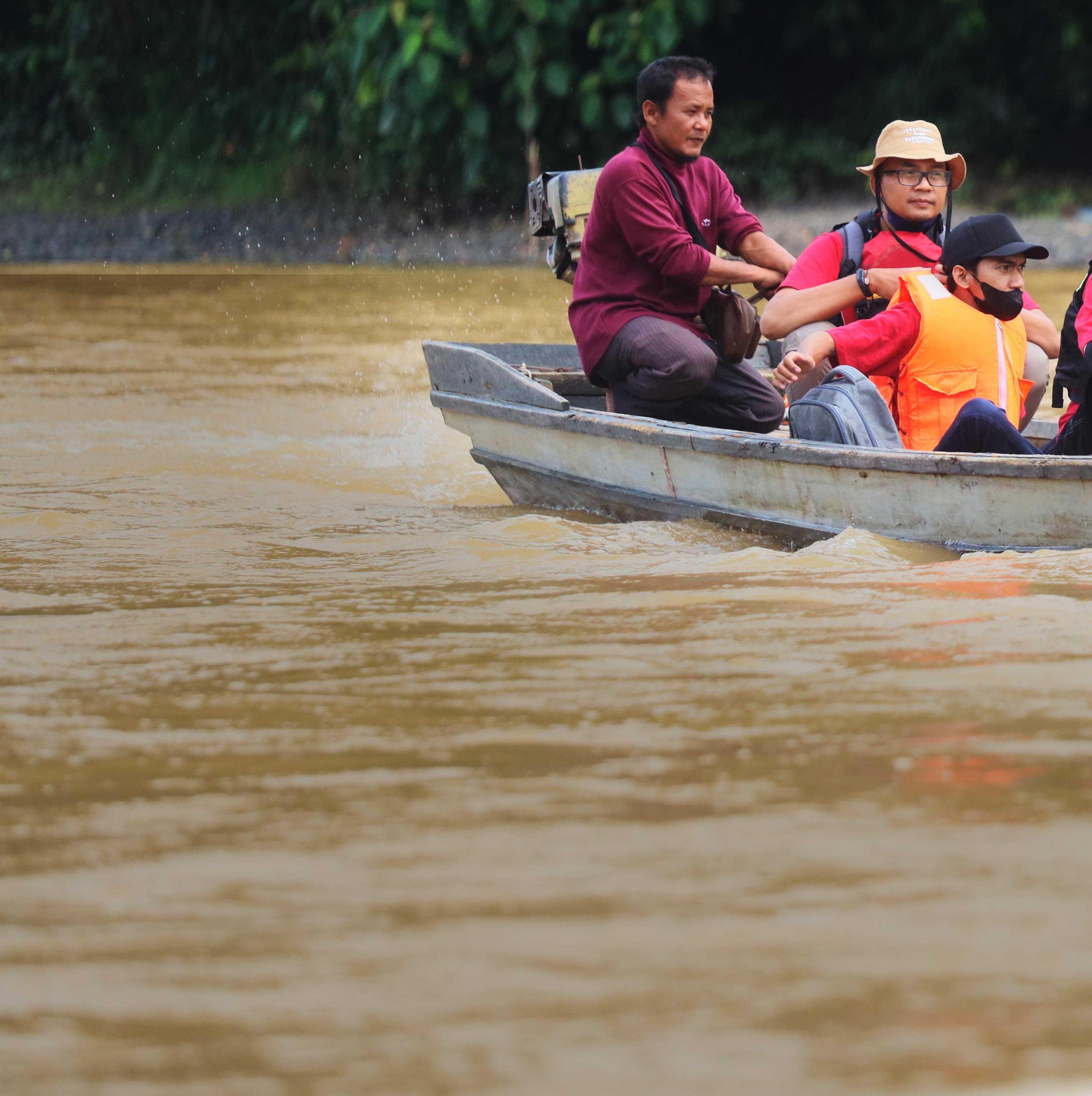
The Muarajambi Temple Compound, located on the banks of the Batanghari River, has been designated as the National Cultural Property Area and became a national priority. Based on the Chinese historic travel record, this compound was once the center
of Buddhist learning in the 5th and 6th centuries and later became part of the Old Malay Kingdom and Srivijaya Kingdom and served as the largest center for Buddhist worship in the archipelago in the 7th and 8th centuries. The Batanghari River bears witness to the splendour of Muarajambi. It is also a crux for trade networks, political relations, and cultural interactions over a span of time during Hindu-Buddhist period when civilization flourished.
Centuries later, a number of young people joined the expedition along the Batanghari River to explore the values of cultural remains of the Batanghari River and learn from it for the present as well as the future.
Expedition
The Batanghari River Expedition was organized from 12 to 22 July 2022. On the morning of 12 July 2022, fifty participants got ready near the Dareh River, Dharmasraya, West Sumatra, before they embarked for the Batanghari River Expedition to explore the rich culture around the Batanghari River. They are researchers, students, and cultural enthusiasts from many parts of Indonesia who are pursuing various disciplines, including history, anthropology, archaeology, environmental engineering, tourism, and sociology. Dharmasraya Regent, Sutan Riska Tuanku Kerajaan and Director of Cultural Protection, Irini Dewi Wanti delivered remarks at the opening
80 I INDONESIANA VOL. 15, 2022 CULTURAL PROPERTY
ceremony, while Director of Film, Music and Media Ahmad Mahendra sent off the expedition participants.
The participants were divided into 10 groups and travelled from Dharmasraya in West Sumatra Province to Tebo, Batanghari, Muaro Jambi and Tanjung Jabung Timur in Jambi Province while exploring the rich culture of the area.

The journey was not entirely through river transportation. The shallow water levels at several points forced the participants to change modes. We travelled by boat from the Dareh River to the Pulau Sawah Temple, then took a bus to the Padang Roco Temple. At these two temple sites, we understood more
about the importance of community involvement in cultural property preservation efforts.
The third stop was the Siguntur Kingdom. After crossing the river with floats, we were welcomed by toga dance performances, silek pangean, and rendang paku making. Expedition then continued to the Siguntur Old Mosque, the Tomb of the Siguntur Kings, and the Siguntur Palace.
The next day we visited an ODCB (a potential cultural property object), the Teluk Kuali site in Tebo, Jambi. In the 1990s, the Ministry of Education and Culture through its technical unit in Jambi unearthed this object
and collected some preliminary data. However, from the brick structures found at the base of the temple, it is likely that the temple could not be reconstructed following its original shape. We also went to Tebo Old Town Area where we made stops at the old tombs, post office, fortress dormitory, an oil pump, and a colonial heritage hospital, as well as the Tanggo Rajo structure. In the evening the participants were entertained by the klikklang dance, prayer songs, nek pung, lagu panjang, and went to bathe to aek
On the third day we headed to Rambutan Masam Village and were greeted by the Deputy Regent of Batang Hari, H. Bakhtiar. We were welcomed
VOL. 15, 2022 INDONESIANA I 81
Wading through the Batanghari civilization
by kompangan traditional music performance, the betel leaf dance and ngebeng dance. We also had a brief discussion with the guardian of the Johor and Sultan Adijaya Kusumo’s sacred cemeteries. In the evening, we learned a lot about the local tradition in the area such as nengok tuah budak, sarofal anam chanting, mujuk sialang, bakohak, gulai aghis pisang culinary, ayam-ayaman game and elang-elangan game. We also saw an ODCB, the sacred artifact which belongs to the village of Rambutan Masam.
On the fifth day, the expedition went through the river route and became more challenging. The participants looked very excited sailing through the river on two river boats that belong to Polairud (the Air and Water Police Corps) and the BNPB (National Disaster Mitigation Agency). The two boats took us to Muara Tembesi, an area where we could find colonial heritage buildings. It is as if we were transported to the colonial period.
On 16 July 2022, we departed from Ancol, Jambi City, and sailed along the Batanghari River with the Polairud and BNPB ships. The next mission was to explore the cultural remains of Simpang Tua Village, Batang Hari Regency in the form of traditional shipbuilding knowledge – which has been in the heart of this village’s life for centuries. We then headed to the Orang Kayu Hitam Tomb Site in East Tanjung Jabung Regency. This tomb belonged to an important figure in the development of Islamic governance in the 16th century in Jambi known as Orang Kayu Hitam. Although unrelated, there are also remains of Buddhist-style structures around this tomb.
Our journey continued to the East. We arrived in Teluk Majelis, East Tanjung Jabung Regency before dark. Participants were again welcomed by the kompangan traditional musical performance, silat kampilan, and babalas syair. We also learned the history of Teluk Majelis, the Sheikh Arifin’s Manuscripts, and the local language of the Teluk Majelis. Inai dance, a dance that is usually performed at the wedding ceremony of the Malay people, was also performed that night and really captivated
the audience. The next day, we headed to Tanjung Solok, where the Duano tribe – one of the oldest sea tribes in Kuala Jambi, Tanjung Solok – lives. We were welcomed by local residents who enthusiastically explained the traditions of making nets, baskets, sticks, and lime from shells. They also told us about their indigenous language, Sumbun stories, and maritime skills and knowledge that have been passed down from generation to generation in the Duano tribe. We also took part in the safat bath ritual.
On 18 July 2022, we turned west to return to the Muarajambi National Cultural Property Area and visited Gumpung Temple and Kedaton Temple. The entertainment – Jolo Humming, Gambang Dano Lamo Music, Dzikir Berdah, and Tkud – was performed that evening and filled our hearts.

The next agenda was a seminar with the theme “Batanghari: Past, Present, and Future” which gathered stakeholders and the community representatives. Director General of Culture Hilmar Farid and Governor of Jambi Al Haris were present to give remarks. The speakers at this seminar were Junus Satrio A. (Head of the National Cultural Property Expert Team); Bambang Budi Utomo (IAAI); and Lono L. Simatupang (Member of the Indonesian Intangible Cultural Heritage Expert Team). The seminar concluded with the reading of recommendations and closing by the Director of Cultural Human Resources and Cultural Institutions Empowerment, Judi Wahjudin.
Culture and Environmental Issues

The Batanghari River flows through the Muarajambi National Cultural Property Area, connecting West Sumatra – with the headwater in Mount Rasan – and Jambi.

82 I INDONESIANA VOL. 15, 2022
Putri Teluk Kembang dance of Tebo, Jambi
The Batanghari River empties the water in the Berhala Strait, off the East Coast of Sumatra into the South China Sea. Along this river, there were many cultural interactions that can be traced through the heritage that can still be found today. This expedition proved that most of the cultural remains along the Batanghari River are linked with the life of the river community, the maritime community who have been living side by side with cultural diversity.
Traditions such as taking a bath with the aek and saltwater bathing show that the people around the Batanghari River still practice a cultural tradition that is inextricably tied to the river. However, water from the Batanghari River is no

longer being used because it has been contaminated by mercury from gold mining.
Settlements around the Batanghari River were also affected by environmental changes. As a result of the abrasion, the dwellings in the Teluk Majelis are increasingly shifting due to land subsidence. Settlements in the Teluk Majelis are no longer directly facing the river. This is due to massive changes in the forest area accompanied by the effect of boat wakes from large ships to riverbanks.
The surrounding area of Batanghari River is not only used for settlements. The lands are currently also being used for community plantations, oil

palm plantations, fish cultivation, and coal stockpiles. These types of landuse certainly have implications on the environment and society.
Batanghari River expedition is part of the efforts to revive the veins of Sumatran civilization. The results of the expedition are expected to contribute to the formulation of policies aimed at promoting cultural development in the Batanghari River area

 (Annisa Mardiani, Batanghari River Expedition Team Member, Directorate of Cultural Protection, Directorate General of Culture, MoECRT)
(Annisa Mardiani, Batanghari River Expedition Team Member, Directorate of Cultural Protection, Directorate General of Culture, MoECRT)
VOL. 15, 2022 INDONESIANA I 83
VOL. 15, 2022 INDONESIANA I 83
(Clockwise) Examining archaeological remains in Muarajambi; Hearing the stories of the people in Muara Tembesi; Boat building in Simpang Tua Village; Welcoming event by the people of Tanjung Jabung Timur
Photo courtesy of Directorate of Cultural Protection
Cisitu Customary Forest Sustainable Forest, Prosperous Community
“Mun aya, diayakeun, mun eweuh ulah diaya ayakeun…,” is important advice from Abah Yoyo Yohenda, Head of the customary community of Kasepuhan Cisitu to the community and the customary forest technical verification team before verifying subjects and objects of the proposed Cisitu customary forest. Abah Yoyo advised the community to provide truthful information without adding or subtracting information to the Integrated Team for Kasepuhan Cisitu Customary Forest Verification.
The Integrated Team comprises several work units and technical implementing units under the Ministry of Environment and Forestry, Geospatial Information Agency, Directorate of Belief in God Almighty and Customary Law Community, Directorate General of Culture, Ministry of Education, Culture, Research, and Technology, and STKIP Setia Budhi Rangkasbitung. The Integrated Team led by Herry Yogaswara from the National Research and Innovation Agency verified the customary forest proposal from the customary community of Kasepuhan Cisitu regarding customary community subjects and customary forest objects.
The customary forest is one of the social forestry schemes provided by the government through the Ministry of Environment and Forestry. Other schemes include Hutan Desa-HD (Village Forest), Hutan Kemasyarakatan-HKm (Community Forest), Hutan Tanaman Rakyat- HTR (Community Plantation Forest), and forestry partnerships. Customary law communities must manage customary forests. The communities, such as traditional associations, have customary law institutions that still adhere to and collect forest products in the surrounding forest areas recognized under regional regulations.
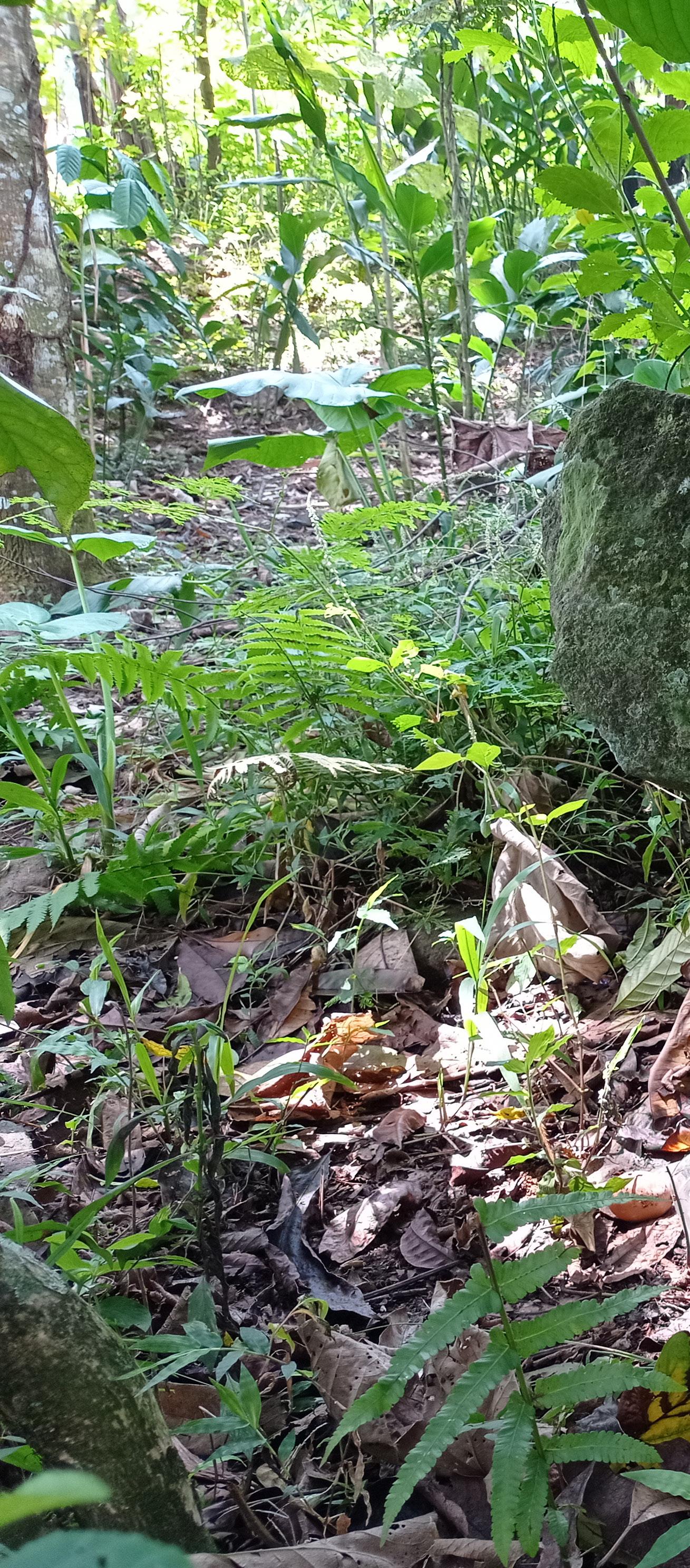
The customary structure of Kesepuhan Cisitu is led by Abah Yoyo Yohenda and assisted by several baris kolot. Baris kolot consist of dukun kolot, bengkong, catur galur, penghulu, paraji, and assistants in other fields. There is tilu sapamilu in the application of customary law, the alignment of three elements of policy enforcement in its implementation, i.e., nagara, syara, and mahaka (state, religion, and custom).
The customary community of Kasepuhan Cisitu has a traditional concept of customary land spatial planning, namely leuweung tutupan (leuweung kolot), leuweung titipan, and leuweung awisan Leuweung tutupan/leuweung kolot is a sacred forest area that the community can never cultivate. Leuweung titipan is entrusted from karuhun. Therefore, to work on it requires instructions from the ancestors. They can use this land for urgent needs under the elders’ (Kasepuhan leaders) permission. Leuweung awisan is a reserve land, an expansion of arable land. The state, through the Mount Halimun Salak National Park, has created zoning for the management of the national park, which includes the core zone, jungle zone, utilization zone, and other zones (traditional, religious, cultural, historical, rehabilitation, and special).
The verification team then looked at the overlap and intersection between the concept of forest use and the zoning concept of the national park. It turned out that there are similarities between the customary community of Kasepuhan and the concept of the national park
84 I INDONESIANA VOL. 15, 2022 CUSTOMARIES
regarding forest functions. Leuwung
tutupan, for example, has the same function as the core zone in the national park zoning, as a conservation area. However, sometimes findings in the field show management differences between the state and the customary community concepts. Say that a supposed production forest (managed by Perhutani) becomes a rice field area that the community has cultivated for a long time. It could be that the rice field is also a cultivated leuweung (forest).
Before proposing a customary forest designation to the government, the community must first obtain its customary law community title. It shall be
designated by the regional regulation if the proposed location is within the state forest area or by the Decision Letter of Regent if the proposed area is outside the state forest area. The designation follows the Regulation of the Minister of Environment and Forestry No. 9 of 2021 concerning Social Forestry). Kasepuhan Cisitu has been recognized as a customary community by the government under the Regional Regulation of Lebak Regency No. 8 of 2015 concerning Recognition, Protection, and Empowerment of the Customary Law Community of
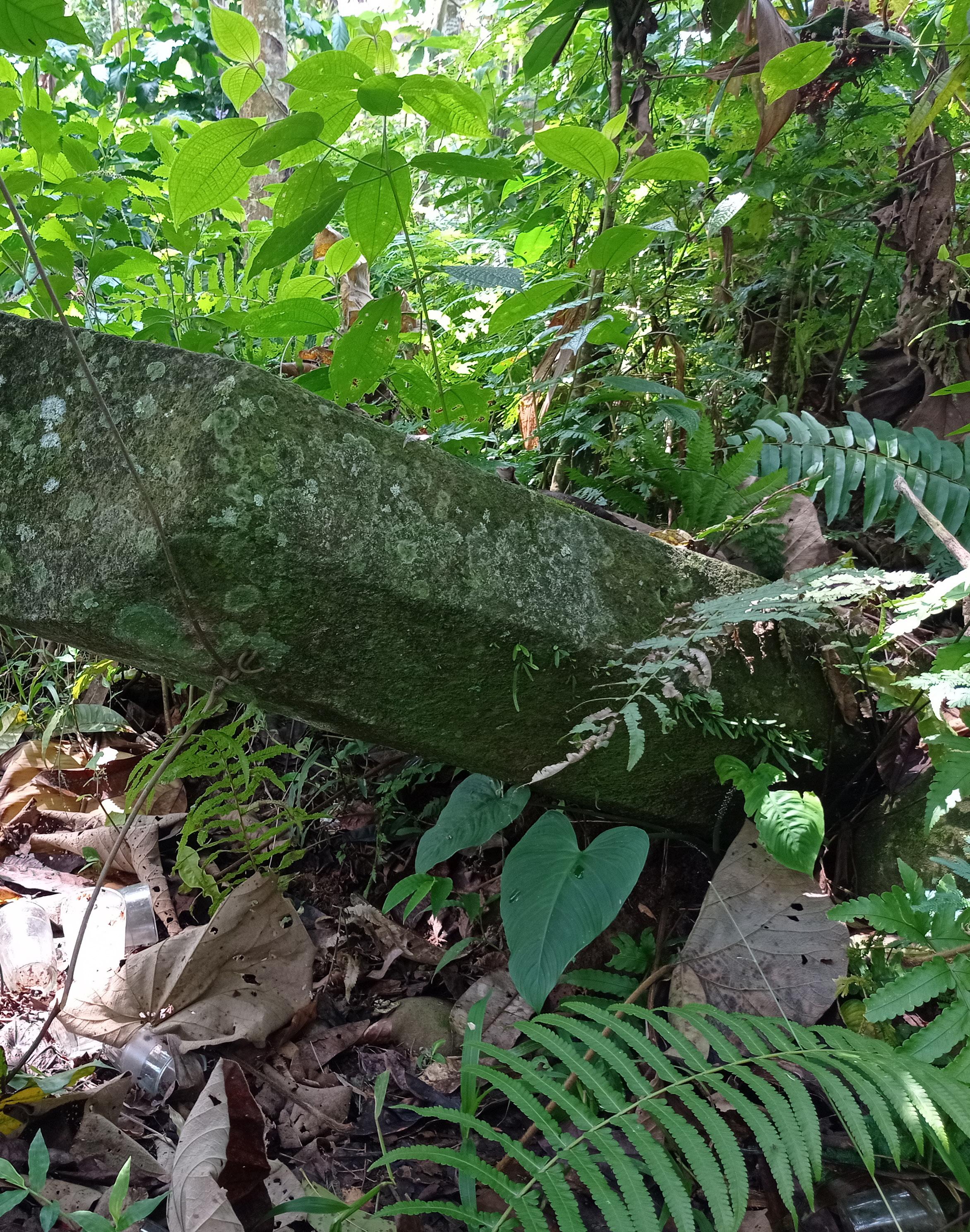 Kasepuhan
Kasepuhan
The process of preparing and verifying the designation of a customary forest, customary land, and the possible customary forest locations must be “clear,” for instance, there has to be an agreement with the customary land or neighboring village government without conflict. These processes also serve as media for conflict resolution related to
of Lebak Regency.
VOL. 15, 2022 INDONESIANA I 85
Pasir Tugu archaeological site in the Customary Territory of Kasepuhan Cisitu
Photo courtesy of TimDu Vertek (Integrated Team Vertek for Technical
Verification) of HA Cisitu (the Kasepuhan Cisitu Customary Forest)
customary land between the internal and external customary communities of Kasepuhan. Furthermore, participatory mapping aims to enable the customary community to recognize objects and potentials in their customary land.
Interaction with the Forest
The forest in the customary community of Kasepuhan Cisitu has many functions. Leuweng tutupan Leuweng Tutupan functions as a conservation area, maintaining ecosystem sustainability and a water catchment area that can protect Kasepuhan village from floods and landslides. We can utilize the potential forest products of the customary forest for economic, social, and cultural needs.
There is rattan in the wilderness for handicraft products or accessories, such as boboko (rice holders), kaneron bags, or armlets.
There is also bamboo for artistic instruments such as angklung buhun which consists of gong-gong, panembal, kingking, inclok, lower, and dog-dog. During a discussion with a buhun angklung player, the player said that playing angklung means conveying a message through the melodies of the angklung buhun. The harmony and melody of the angklung buhun symbolize the harmony in the relationship between the government, traditional actors, and incu putu

Is there traditional medicinal potential?
There certainly is, say, picung root decoction to treat stomach aches. There is also tuak ilat made of weeds, which is processed from weed extracts to drink. This decoction is to treat coughs or to use as an eye drop.
There is much to be done after a customary forest designation, not only concerned with conservation and the interaction between the community that owns and safeguards the customary forest and its customs. The forest is an inseparable part of community cultural interactions because economic and social needs and cultural facilities exist in the wilderness. In terms of culture, the owner
86 I INDONESIANA VOL. 15, 2022
(Clockwise) Customary Law Community of Kasepuhan Cisitu playing Angklung Buhun; Rice cultivation by the customary law community of Kasepuhan Cisitu; Landscape of the Kasepuhan Cisitu territory
community carries the knowledge about traditional food ingredients or traditional/ alternative medicines.
Traditional knowledge regarding food processing, the introduction of plants as herbal remedies, and how to prepare them is only known to the older generation. The process of transmitting knowledge sometimes faces obstacles. Therefore, it is necessary to revitalize the indigenous youths’ spirit to identify the cultural potential of the customary forest.
Revitalization of the Customary Community of Kasepuhan
Follow-up actions after designation are crucial. Incu putu in Kasepuhan must
benefit from the customary forest. Law No. 5 concerning the Advancement of Culture stipulates that we can utilize the objects of advancement of culture to strengthen national identity and economy. However, before that, the younger generation and other incu putu must be willing to explore knowledge regarding objects of advancement of culture in their customary lands along with the potential for their development and utilization. Central and local governments also participated.
The younger generation must first be enthusiastic about exploring traditional knowledge from kolot-kolot (the elders) kasepuhan and then create a place or
space for knowledge transmission. Abah Yoyo Yohenda emphasized that introducing culture to the younger generation must be sustainable so that they can understand their culture, local wisdom, and traditional knowledge shared by the elders. Such endeavors, for instance, participation in cultural practices or rituals carried out by the elders, such as during the preparation or implementation of Seren Taun, a rice
harvest festival held to mark the new agricultural cycle.
Customary forest designation aims to improve the lives of the customary law community of Kasepuhan Cisitu. Utilization of customary forests for economic needs must pay attention to ecological balance, as well as the advancement of culture. In this way, they can realize the ideals of the customary community, as their slogan says: leuweung hejo, masyarakat ngejo (sustainable forest, prosperous community).


VOL. 15, 2022 INDONESIANA I 87
(Wewen Efendi, Junior Cultural Administrator, Directorate of Belief in God Almighty and Customary Law Community)
Photo courtesy of Wewen Efendi (Dit. (Directorate of) KMA (Belief in God Almighty)/member of TimDu Vertek HA Cisitu)
Awaken the Dragon in Glodok Chinatown

HISTORY
88 I INDONESIANA VOL. 15, 2022
The theme “Recover Together, Recover Stronger” of the G20 Summit held in Nusa Dua, Bali on 15-16 November 2022 is likely in line with sustainable development goals, especially the goal to make cities and human settlements inclusive, safe, resilient, and sustainable which will eventually strengthen efforts to protect and conserve cultural and natural heritage (BAPPENAS, 2019). A sustainable city simply means a thriving and changing society. A sustainable city also means an attractive space for people, culture,
commerce, and the economy. This space provides opportunities for interaction, works, and activities, as well as education to develop human potential, as written by Steven Cohen and Guo Dong in The Sustainable City (second edition, 2021). No less important are the challenges in fostering a sustainable community or society.
The Glodok Chinatown area in West Jakarta with its historic traces could be considered as cultural resource of the city, as stated by Ashworth and Tunbridge

in The Tourist-Historic City: Retrospect and Prospect of Managing the Heritage City (2000) that history has become heritage and heritage becomes city resources. The cultural resource management approach can be practically applied to record, evaluate, protect, and present the heritage of the past for the future, as Carman wrote in Archaeological Resource Management: An International Perspective (2015). Heritage is one of the products of cultural heritage-based tourism. The cultural resource of the Glodok Chinatown lies in the collective memory of its citizens through physical evidence of its history.
Urban tourism began in the 80s, especially in Anglo-American countries such as the United States and Canada, which connected tourism activities with recreation outside the city or in the countryside and in direct contact with nature, although in the view of
VOL. 15, 2022 INDONESIANA I 89
Jin De Yuan Chinese Temple is believed to be the oldest pagoda in Jakarta, dating back to the early 18th century.
Photo courtesy of Ary Sulistyo, Indonesia Hidden Heritage Creative Hub
industrialists, cities are seen as places for work, commerce, and government. In the 70s and 80s in the city of Bologna, Italy, local communities promoted initiatives and efforts for modern entrepreneurship, including in the tourism sector, by creating opportunities for synergy between the conservation of historic buildings and environmental improvement, including in regional urban planning regulations. In Indonesia, one of the examples is the city of Bandung, which in the past decades has continued to improve its historic core area such as the Braga area and has become a heritage-based tourism destination. The development of old Batavia (now the Kota Tua Jakarta) in the 1645s was linked to Phoa Bing Am, a Chinese captain (kapitein der Chinezen) who is known for his irrigation work. He built canals in 1648 to transport logs to the shipbuilding area and Sunda Kelapa Harbour. The areas along the canals were developed into settlements dominated by Chinese and European immigrants. The old Batavia was an area that was very popular with Chinese immigrants since the early 17th century. They served as traders and provided services as brokers between
pribumi traders from the hinterland to international markets in Southeast Asia, although the Dutch then tried to limit the number of Chinese populations by making immigration regulations in coastal cities which then lead to numerous uprisings against the Dutch.
After the 1740 uprising, the Chinese descents were reallocated to the Petak Sembilan area within the Kota (ommelanden) area which was called as the Chine Kwartier in the old Batavia map. As many as 5000 of Chinese descent were massacred behind the Batavia City Hall by the orders of Governor General Adrian Valckenier (1695-1751). The situation got worse due to the malaria, cholera and plague outbreaks in the Ciliwung River estuary area. After the VOC was dissolved in 1795, the old city of Batavia was still developing but no longer healthy.
Governor General H.W. Daendels during his leadership in 1808-1811 dismantled part of the city walls and bastions to develop the southern part of the city (weltevreden) which today is called Gambir area (Yulianto Sumalyo in the History of Kota Tua (2007)).
Cultural Resources of the Chinatown
Cultural resources can be seen as historical records of each ethnic group, reflecting the life and livelihood of the Indonesian people in all its aspects, both socio-cultural, economic, and religious. Based on their nature, cultural resources can be divided into two groups, namely the tangible cultural resources and intangible cultural resources which both formed the national cultural wealth and identity. The long record of human history creates cultural heritage along with its associated landscapes and areas to which archaeological resources are attached.
The development of Chinatown area has a long history that goes back to the preindustrial cities during the local kingdoms and empires era (Denys Lombard in Nusa Jawa Silang Budaya Jilid III: Warisan Kerajaan-Kerajaan


90 I INDONESIANA VOL. 15, 2022
The Chinese-style house of the Souw Family, once known as a wealthy family and having served as Luitenant der Chinezen in the 19th century
Photo courtesy of KITLV 41709
Konsentris, 2005) and then the Dutch colonization in the 17th to 20th century. In the 18th century the number of migrants who came to Batavia from mainland China increased. They acculturated and assimilated and established the present Chinatown (Glodok) area. In the Glodok area – for example the Tamansari District of West Jakarta – the historical character of the area has the potential to be developed as a cultural heritage tourism destination, which is generally divided into two, namely centers of sacred activities and centers of profane activities. The center of sacred activity is represented by temples or monasteries and churches. There are quite a number of temples and


monasteries in the Glodok Chinatown area, as well as ash houses for certain clans or families. The large temples or monasteries in the Glodok Chinatown area are the Budhi Dharma Temple/Li Tie Guai Temple, Ariya Marga Temple/Nan Jing Miao Temple, Toa Se Bio Temple, and Djin De Yuan Temple. Whereas for the churches, there are the Indonesian Christian Church (GKI) Commerce and Church of Santa Maria De Fatima. The centers for profane activity – such as markets, roads or alleys, schools and houses in the Glodok Chinatown area – that are being used for economic activity could also be used as cultural and heritage tourism destinations due to their distinctive character of the Kota Tua Jakarta.
Cultural heritage objects could be utilized for the benefit of religion, social, education, science, technology, culture, and tourism. The cultural resources in Glodok Chinatown could be utilized to support the Sustainable Development Goal 11 to make cities and human settlements inclusive, safe, resilient, and sustainable, especially target 11.4 which aims to strengthen efforts to protect and safeguard the world’s cultural and natural heritage. However, utilization should be carried out in a careful manner while minimizing possible damage and taking into account the development of other cultural heritage-based creative economies, such as tour guides, crafts and others (Wiwin D Ramelan in Model Pemanfaatan Kawasan Cagar Budaya Trowulan Berbasis Masyarakat, 2015). In supporting sustainable urban development, tourism in urban areas is part of the production process of a city which is not only used for consumption. If we make the effort to protect and safeguard our city’s cultural heritage, we might awaken the dragon in Glodok, so that it could stand upright again and breathe fire.

VOL. 15, 2022 INDONESIANA I 91 One part of Jin De Yuan Chinese Temple Jin De Yuan Chinese Temple c. 1900
(Ary Sulistyo, Writer and Cultural History Enthusiast)
Photo courtesy of KITLV 25723
SMA 19 public senior high school in West Jakarta, formerly the THHK (Tionghoa Hwee Kuan) nationalist organization headquarters in 1900 before the establishment of Boedi Oetomo
Using
Wayang Beber
to Spread Messages
How are the puppet theaters of wayang purwa, wayang potehi, wayang beber, wayang golek doing? Although various shapes of puppet theaters (wayang) still exist, they are at death’s door. Each and all of them are struggling to survive in the presentday world. The situation is dire. Aside from the law mandates that the state government intervention in this situation
is compulsory, the state government also has a moral obligation to preserve them. Communities or individuals who look after and safeguard these intangible cultural heritages deserve our appreciation.
The heritage of ancestral wisdom compels people to love and protect it for its history, memory, and knowledge.
Let’s meet Indra Suroinggeno (born in 1986), a puppet lover who independently established Museum Wayang Beber Sekartadji (Beber Sekartadji Puppet Museum) in Kanutan, Sumbermulyo, Bambanglipuro, Bantul, the Special Region of Yogyakarta. He loves wayang beber from the upstream by planting glugu trees (Broussonetia paapyrifera foliage) which produce dluwang paper, to the downstream by spreading the knowledge of wayang beber to school students.
Indra built a wayang beber museum at his residence, which he later expanded by buying his relative’s house next door. It’s not easy to set up a museum. We have to consider financial reasons and regulations. Indra was once rejected by the regional government when he registered his museum because the museum did not meet the requirements, such as an air conditioner to maintain room temperature to preserve collections. Indra patiently

MUSEUM
92 I INDONESIANA VOL. 15, 2022
Welcome to Wayang Beber Sekartaji Museum
Photo courtesy of Yudhi Wisnu
went through the process. His museum is now one of the trusted “field work” destinations of art vocational schools. If interested in visiting the Beber Sekartaji Wayang Museum, Indonesiana readers can easily browse the internet for its address.

“Planting a glugu tree is easy because the roots are shoots, so if you plant one thousand, they will grow. What is difficult is the patience to process the tree bark into dluwang paper. Dluwang paper replaced palm leaves when the era of palm leaves ended before the cloth replaced the paper to this day. But the dluwang paper is still used, too,” said Indra when we met him at his beautiful museum in July 2022.

Indra spent a week making one sheet of paper. He took the tree bark (sliced, gouged, released) from the trunk and then hammered it more than a thousand times until thinning. After that, he fermented the bark three times and ground it with a stone or shell to make it extra fine. How much it costs? It costs Rp75 per square centimeter.
Indra, whose real name is Trias Indra Setiawan, took a long and winding road to get to the point of devoting himself to the preservation of wayang beber. After graduating from STM Pembangunan, where he studied Informatics in 2006, he traveled to various countries, working in restaurants and cruise ships. He met many people who admired Indonesian
culture and were willing to save money to go to Indonesia. It encouraged Indra to return home and study culture. At that time, he thought, if foreigners admire Indonesian culture so much, why should I live abroad?
Indra returned to Indonesia in 2013 and became a tour guide at Sono Budoyo Yogyakarta. His heart grew fond of Indonesian traditions, especially wayang. In 2015, he received a scholarship from Sri Sultan HB X to study at Akademi Komunitas Negeri Seni Budaya Yogyakarta (the Yogyakarta Arts and Culture State Community Academy) for a year. “While in Sono Budoyo, I founded the Bhuana Alit Cultural Arts Studio and became an apprentice of Pak Sagiyo

VOL. 15, 2022 INDONESIANA I 93
(Clockwise) Puppet making materials; Trian Indra Setiawan, wayang beber aficionado; Images to display
Photo courtesy of Yudhi Wisnu
VOL. 15, 2022 INDONESIANA I 93
Photo courtesy of Zul Lubis
Photo courtesy of Yudhi Wisnu
Kasongan. Pak Sagiyo said our emotions must blend with the puppets we are making. For example, when making Semar, our emotions alter to Semar and become wise. It’s not easy,” said Indra.
The Story of Wayang Beber
We estimate that wayang beber, which used silawan or lontar leaves as a “canvas” for drawing, has existed since the 9th century and developed in 1145 in the Jenggala Kingdom era of Prabu Suryawisesa ruling. Over time, lontar was replaced with dluwang paper and later replaced with cloth, which was more flexible to roll and spread. The name wayang beber comes from telling and playing the cloth-based (or paper-based) scroll wayang story by opening the scroll little by little, slowly, following the order of the wayang story’s episodes.
In the early days of its existence, wayang beber took stories from the reliefs in the temples and then used them to spread religion. According to Bagyo
Wayang Beber Wonosari (2005), only two versions of wayang beber known to the public today. Both versions are legacies of the Mataram Kingdom: wayang beber Pacitan and wayang beber Wonosari, which narrate the Joko Kembang Kuning and the Remeng Magun Jaya stories, respectively.

The collection of the Wayang Beber Sekartaji Museum is adequate, although not complete. This museum stores collections of wayang beber and provides knowledge and training for wayang lovers, especially school and university students. This initiative should be appreciated.
One collection that caught our attention was the lontar-leaf wayang beber of Sutasoma, which year of manufacture is unknown. It is the second oldest lontarleaf wayang beber (the oldest wayang beber manuscript is said to have been painted on a stone, while the third oldest was written on dluwang paper). This
cangka ottara. Another collection is the Wayang Beber Kamasan Ramayana, with images of people, not puppets. Wayang Kamasan is wayang beber which is not performed anymore.
Indra received gifts or donations of wayang beber Sabdo Praloyo Genggong, which tells the story of Arjuna, and wayang beber Romo Mangun Joyo and Joko Kembang Kuning, which are Pacitan beber puppets. Indra received gifts or donations for some collections and purchased some from collectors.
We slowly walked through Indra’s extraordinary collection. We stopped at the beautiful Ireng Putih Nusantara wayang beber. “Wayang is light; it is our shadow as humans. I am sure that wayang will not perish because we are part of wayang. Our community or group created, approved, and adopted pakem (consensus standard), so we cannot impose our pakem on others,” said Indra.
 Photo courtesy of Zul Lubis
Photo courtesy of Zul Lubis
Wayang Beber Pancasila

In 2017, Indra developed wayang beber Pancasila, which presents scenes depicting the implementation of the values in the five precepts of Pancasila in everyday life. He sees that wayang beber can be a medium to invite the younger generation to understand the noble values of Pancasila, as well as to preserve wayang. Kill two birds with one stone. “In cool language, this is a mission to strengthen the noble values contained in wayang beber through character education for the community,” said Indra.

Indra, a painter and a puppeteer, inscribes the story on a piece of cloth measuring 450 cm X 100 cm and divides it into five episodes, where each episode depicts the precepts in Pancasila. The first episode is “Gusti tan Kena Kinira, tan Kena Kinaya Apa,” which means that God exists, but God is inconceivable. This episode tells about how to love God vertically and horizontally according to the first principle of Pancasila. Visually, there is a scene of a king teaching his son
to pray and to be tolerant of followers of other religions. Other visuals are temple buildings, temple stupas, people, and animals.
The second episode is titled “Ratu Adil,” which tells about the practice of the principles of justice in everyday life according to the second principle of Just and Civilized Humanity. The visuals are the figure of a queen, a shady tree, a kala ornament, an ornament of two small children with wings, several men and women, a congklak, three giants, and rocks.
The third Pejagong, entitled “Gending Syailendra,” tells about the importance of building a sense of unity and oneness within the framework of diversity in Bhinneka Tunggal Ika. You can see a group of people playing the gamelan together and harmoniously and the figures of Sabdo Palon and Naya Genggong dancing.
The scene in the fourth episode entitled “Rembug Manunggal Rasa” depicts the
fourth precept of Pancasila as a group of residents gathering in the courtyard of a temple to have a deliberation. There are three ornaments, the sun-shaped, the stupa, and the statue.
The fifth episode, entitled “Guyub Samudra,” depicts the fifth precept of Pancasila. The story is the continuation of the fourth episode. Depiction of the culture of gotong royong is sailing in the middle of the ocean, so it visualizes a boat, a captain, several young men rowing, and sea waves. There are also elephant ornaments, two ancestral figures, a group of women, and a kala ornament.
Although kept in a museum along with other collections, Wayang Beber Pancasila often “comes out of the cage” to perform. Wayang beber is able to survive. It feels good when other inspirational stories emerge using wayang beber as media. Do we still have to have them as wayang? Well, it requires another long discussion.
INDONESIANA I 95
(Susi Ivvaty, Indonesiana)
(left to right) A display of one of the collections; One corner of the Wayang Beber Museum; Infographic of the History of the Development of Wayang Beber
Photo courtesy of Zul Lubis
Photo courtesy of Yudhi Wisnu
Melati Suryodarmo: From Indonesia to the World
The “Indonesia Bertutur’’ or Indonesia Tells Stories that took place at the Borobudur Temple compounds attracted public attention across generations from Baby Boomers to Gen Z. Melati Suryodarmo is one of the brains behind the event. In the world of performing arts, who doesn’t know Melati? She has been a performing artist since childhood. She inherited this talent from her mother, a dancer, and her father, Suprapto Suryodarmo, the founder of the Padepokan Lemah Putih Village cultural park in Plesungan Village, Gondangrejo, Karanganyar, Central Java. Her father is also known as the initiator of Joget Amerta or the Amerta Dance Moves. Therefore, talking with Melati is like opening another space for understanding the meaning of art and working for art.
Ms. Melati, can you tell us about your art background and what you are busy with these days?
I was born in the city of Solo on July 12, 1969. Right now, I am preparing three new performance pieces. I am presenting the first piece at the Kochi Muziris Biennale in December in Kochi, Kerala, India. The other two are performance lectures, a presentation of ideas combined with performative acts to review my old works whose methods of creation were poetic acts. I will present both in Singapore in January 2023.
Besides that, I also teach at the Nanyang Academy of Fine Arts Singapore.
Can you tell us about your role in the Indonesia Bertutur?
The Director of Film, Music, and Media (PMM) and the Director General of Culture assigned me as the Artistic Director of the 2022 Indonesia Bertutur. I designed the overall context and themes according to the Director General of Culture and the Directorate of PMM missions. The goal is to revive awareness of cultural heritage and connect it to our lives today in the digital age. But,

96 I INDONESIANA VOL. 15, 2022 PERSONAGE
96 I INDONESIANA VOL. 15, 2022



VOL. 15, 2022 INDONESIANA I 97 VOL. 15, 2022 INDONESIANA I 97
Self-portrait
Photo courtesy of Melati Suryodarmo
Melati performs a ritual at the InTur event; Melati conducts a briefing at the InTur event.
Photo courtesy of MoECRT
Photo courtesy of MoECRT
of course, I was not alone since the beginning of the process. Indonesia Bertutur is a long process that involves many actors in management, venues, and close cooperation with the PMM team.
What is the rationale behind the theme of Indonesia Bertutur?
The theme of Indonesia Bertutur is “Learn from the Past, Grow for the Future.” This theme stems from the spirit to explore Indonesian history and past knowledge and to develop this knowledge into knowledge that inspires, strengthens, and improves life today through culture and technology.
Is it challenging working with many artists who have different ideas and characters?

Oh, certainly! I am an artist who is still actively working and carrying out other activities outside of work. At Intur, I have to provide artistic direction, curate programs, and select artists involved in a big event like this. It is, of course, very challenging because here I am not as an artist who is presenting her art but as a designer of artistic thoughts and choices of the whole event. The main challenge is not to take sides based on personal subjectivity in terms of aesthetic tastes and types of art.
How has your artistic journey been so far? Are there any unforgettable experiences? Tell us about the twists and turns.
Because an art performer is an artist and not an “actor,” the principle is to work from scratch, and the work determines whether or not you are an artist. Art observers determine whether the artist’s work has benefits beyond just aesthetic or nominal values. Likewise, I started from the bottom, from zero. Many artistic productions and performing arts rely on capital first, then work later; I am the opposite as I work first, then think about money later.
98 I INDONESIANA VOL. 15, 2022
Is “performance art” a “passion” since childhood, or is there someone who inspires you?
I grew up in a family of dance and music artists in Solo. My father is an artist, dance, and ritual arts teacher, and my mother used to be a great Javanese dancer. I saw performance
art for the first time in 1989 when I was in Bandung watching a recording of Joseph Beuys’ film “I Like America and America Likes Me” (1974). When I was invited by Marintan Sirait, my best friend in Bandung, to join Perengkel Jahe, an action art exploration group, I started studying some alternative, unconventional forms. Dance that is not an ordinary dance, music but not a song, a theater without acting, etcetera. For me, performance art is my passion. When I studied in Germany, I studied practice and theory and the history of aesthetics related to this practice.
From your point of view, how is the world of performing arts in Indonesia right now? Is it ideal?
It depends on the perspective from which we observe it. The world of performing arts is of many kinds and has different domains. Some come from traditional arts in areas that still live close to their distinctive locales. Their production methods and the direction of their artistic work also vary. The industrial management system manages many performing arts engaged in the entertainment sector. Ideally, we return to the essence of art, the value behind it all: does it inspire fans to understand
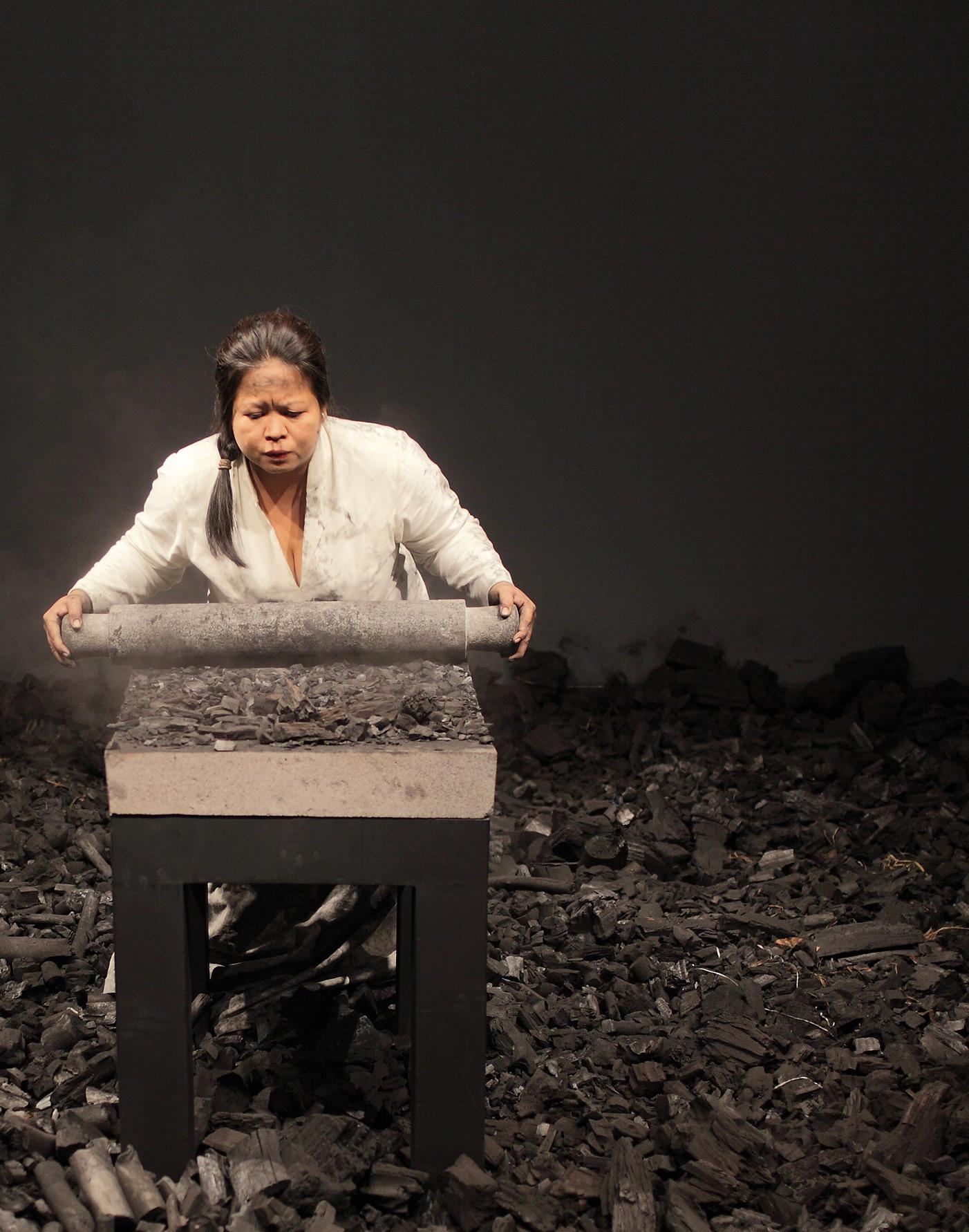
VOL. 15, 2022 INDONESIANA I 99
Melati performing I’m A Ghost in My Own House
Photo courtesy of Melati Suryodarmo
this life and its many layers of meaning? Art appreciation should continue to grow and be strengthened in various regions of Indonesia and not only centralized in the capital.
Can Indonesian performing arts compete with neighboring countries?

If you look at the source of inspiration, I don’t think Indonesia will ever lose in the international arena. The way I see it, the main thing is how works of art can touch human understanding through the discussion of feelings and logic, which are naturally universal. It means that if the theme of work affects emotions and the global community’s perception of the idea, I think it will undoubtedly penetrate regional and international boundaries. It may seem that we cannot separate art from the language of taste and knowledge of humanity. If we look at works of art created hundreds of years ago, they can still affect today’s modern
society, partly because the meaning of these works still touches on the theme of human life in today’s world.
What potential should or can still be explored further regarding Indonesian culture? Is there a need for interdisciplinary collaboration in art?
Taking into account the wealth of potential sources of creative thought and inspiration in our homeland, it seems that culture will never die. Culture is always closely related to how our society grows with it. Collaboration that transfers the vehicle is interesting, too, especially when using artistic creativity to translate knowledge. Artistic creativity is innovative, inspires many people to gain spiritual experience of art, and broadens people’s knowledge, reflecting on the ritual forms of our tradition, which are full of symbols and thoughts and are very concerned about the relationship between humans, nature, and God.
Nowadays, what do we have to do to produce ideal artists?
Artists must be aware of which path they take. They must also understand production systems and networks and become their PR and self-manage. Artists must understand what their agency is through art. They need to be aware of time and energy. I think there will be tests on independent character, work sustainability, and the desire to continue to explore or experiment. Professionalism is not easy to develop; it takes a gradual learning process. In artistic work, artists must be fully responsible for their work, both from the perspective and creative points of view. Therefore, we cannot produce artists because they must, for themselves alone, decide whether they want to be good artists or not.
(Prima Ardiani, Senior Cultural Administrator, Directorate of Cultural Development and Utilization, MoECRT).
--------
100 I INDONESIANA VOL. 15, 2022
Melati Suryodarmo
Place and date of birth: Solo, July 12, 1969
Education : 1988-1993: Padjadjaran University, Bandung, International Relations Study Program.
1994-2001: Performing arts and sculpture, The Hochschule fuer Bildende Kuenste, Braunschweig, Germany.
2001-2002: Postgraduate Program in Performance Art, The Hochschule fuer Bildende Kuenste, Braunschweig, Germany.
The two women, who mentored and influenced Melati’s studies and works of art, are Prof. Anzu Furukawa from Japan and Prof. Marina Abramovic from Serbia. In 1996, Melati danced “Kasyhya-kashya Muttiku” with Yuko Negoro from Japan. Since then, she has participated in various performing arts activities in European countries. In 1999 Melati performed for Cardiff Art in Time in Wales, England, and “Performance Festival Odense” in Odense, Denmark. In 20002001 Melati performed at the “Anableps” exhibition at the Miscetti Gallery and the “Festa dell’arte” Acquario Di Roma in Rome, Italy. In Cork, Ireland, Melati performed in “Get That Balance” at the National Sculpture Factory of the Opera House.
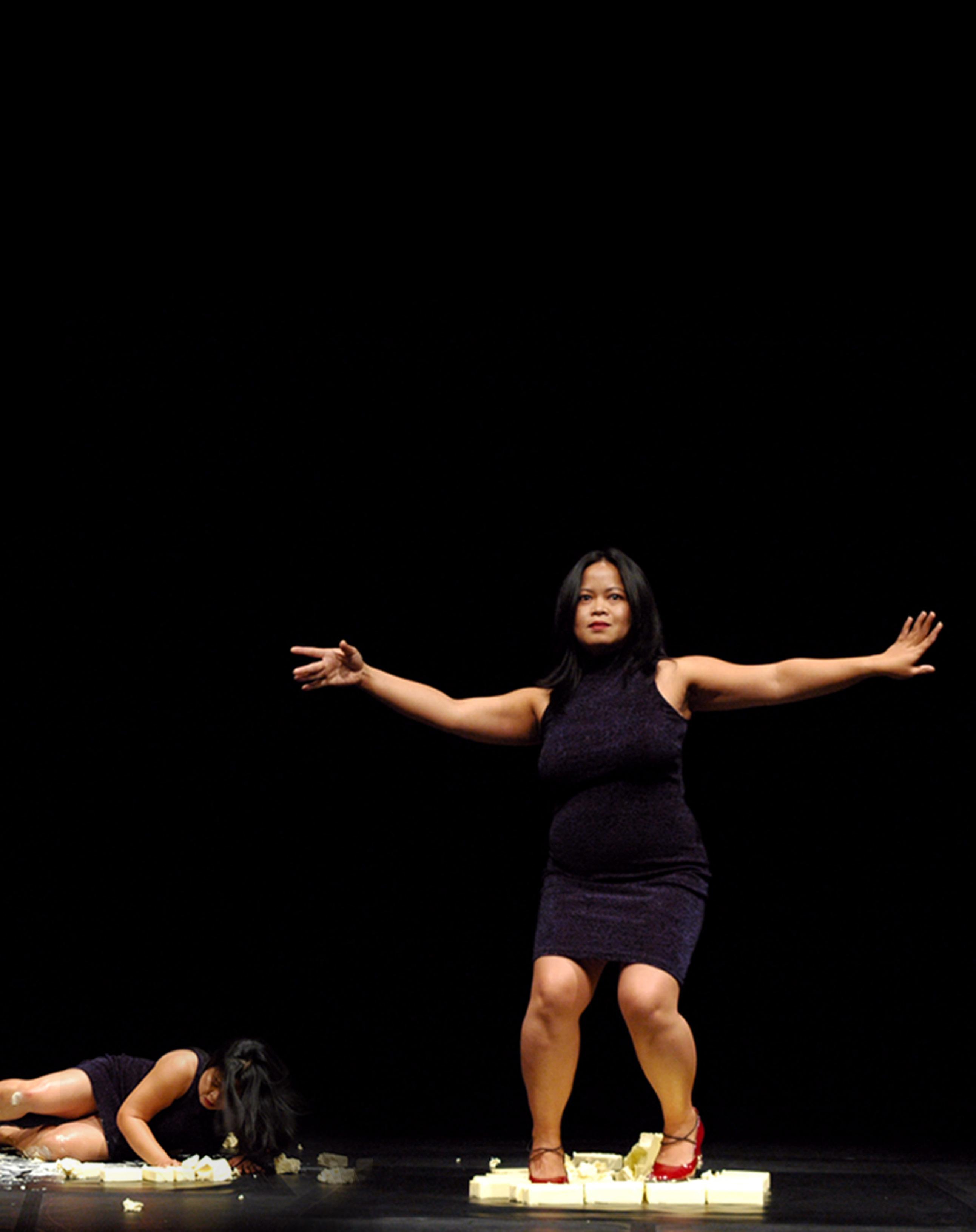
VOL. 15, 2022 INDONESIANA I 101
Exergie - Butter Dance
Photo courtesy of Isabel Matthaeus, Melati Suryodarmo
Village Opening Ritual Celebrating Patriotism, Renewing Ourselves

Banda is an area with a diverse population, spread over eight traditional villages. There are abundant traditions in the Banda area, one of which is the village opening (buka puang) ritual, which is usually held long before the big celebration and preceded by a deliberation of traditional leaders. The purpose of this ritual is to pray so that all future affairs will be smooth and full of divine blessings. During this ritual week, people should keep their minds, hearts and environment clean. The ritual equipment includes coconut leaves, seven-type of flowers, incense, and trinkets offerings. In the evening after isha prayer, the ritual begins.
Traditional leaders prepare betel nut leaf holders or woven offering baskets from coconut leaves, the number of which corresponds to the number of ancestral graves to be visited the next day. The women decorate the offering baskets with garlands of flowers and fill them with lime, betel, areca nut, gambier and tobacco.

The community holds the buka puang ritual – namely opening of the coconut flower, cutting and installing bamboo for the ceremonial archway and gate – two days before the peak of the celebration. The opened puang (coconut flower) is placed in the traditional houses next to heirlooms, cakalele dance attributes, and belang kora-kora attributes. This is in fact the essence of the village opening ritual. After buka puang, the cakalele warrior dance is performed and belang kora-kora regatta is carried out as the peak of the

102 I INDONESIANA VOL. 15, 2022 PORTRAITS GALLERY
Tampa sirih or bowl-like container
divisions of time 102 I INDONESIANA VOL. 15, 2022
A tampa sirih offering containing gambier, areca nut, betel leaf, slaked lime, and tobacco symbolizing the five
celebration to commemorate the spice route, which represents strength and patriotism in fighting the colonial power in the past. On special holidays, the people of Banda Neira welcome the people of Banda Eli who live in the Kei Islands, Southeast Maluku, who migrated four centuries ago. The cakalele dance at the Mini Palace in Banda Neira is usually livelier because the dancers come from various regions in Maluku. The ritual ends by closing the village. After that, cakalele attributes and belang kora-kora attributes are to be put away and stored, while the dance and the regatta may not be performed again until the next village opening ritual.

(Darus Hadi, Directorate of Religious Belief in God Almighty and Customary Law Community, the Ministry of Education, Culture, Research, and Technology).
 Filled and decorated tampa sirih are collected at rumah adat (the village customary house)
Filled and decorated tampa sirih are collected at rumah adat (the village customary house)
VOL. 15, 2022 INDONESIANA I 103
Weaving 11 strands of coconut leaves, symbolizing the five pillars of Islam and the six pillars of faith
Photo courtesy of Directorate of Belief in God Almighty and Customary Law Community
Ancestor veneration

A group of customary elder and youth pilgrims is getting ready for a pilgrimage

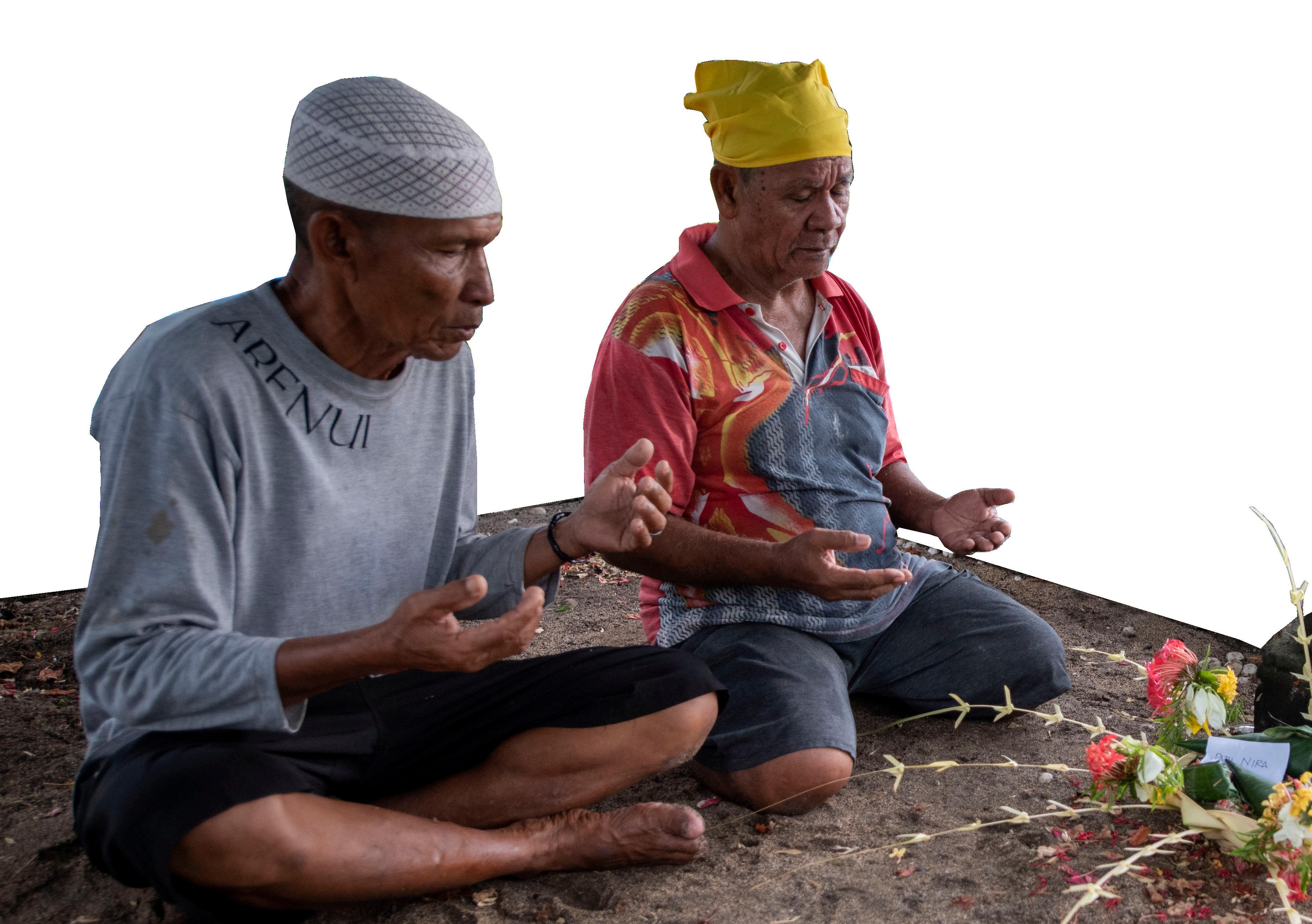
 Mama adat making garlands for tampa sirih decorations
Buka Puang ritual is the culmination of the Buka Kampung ritual
Walking barefoot to a pilgrimage site from the customary house carrying tampa sirih
Mama adat making garlands for tampa sirih decorations
Buka Puang ritual is the culmination of the Buka Kampung ritual
Walking barefoot to a pilgrimage site from the customary house carrying tampa sirih
104 I INDONESIANA VOL. 15, 2022




 Cakalele performance preparation
Cakalele performance preparation
VOL. 15, 2022 INDONESIANA I 105
Cakalele ‘war’ dance
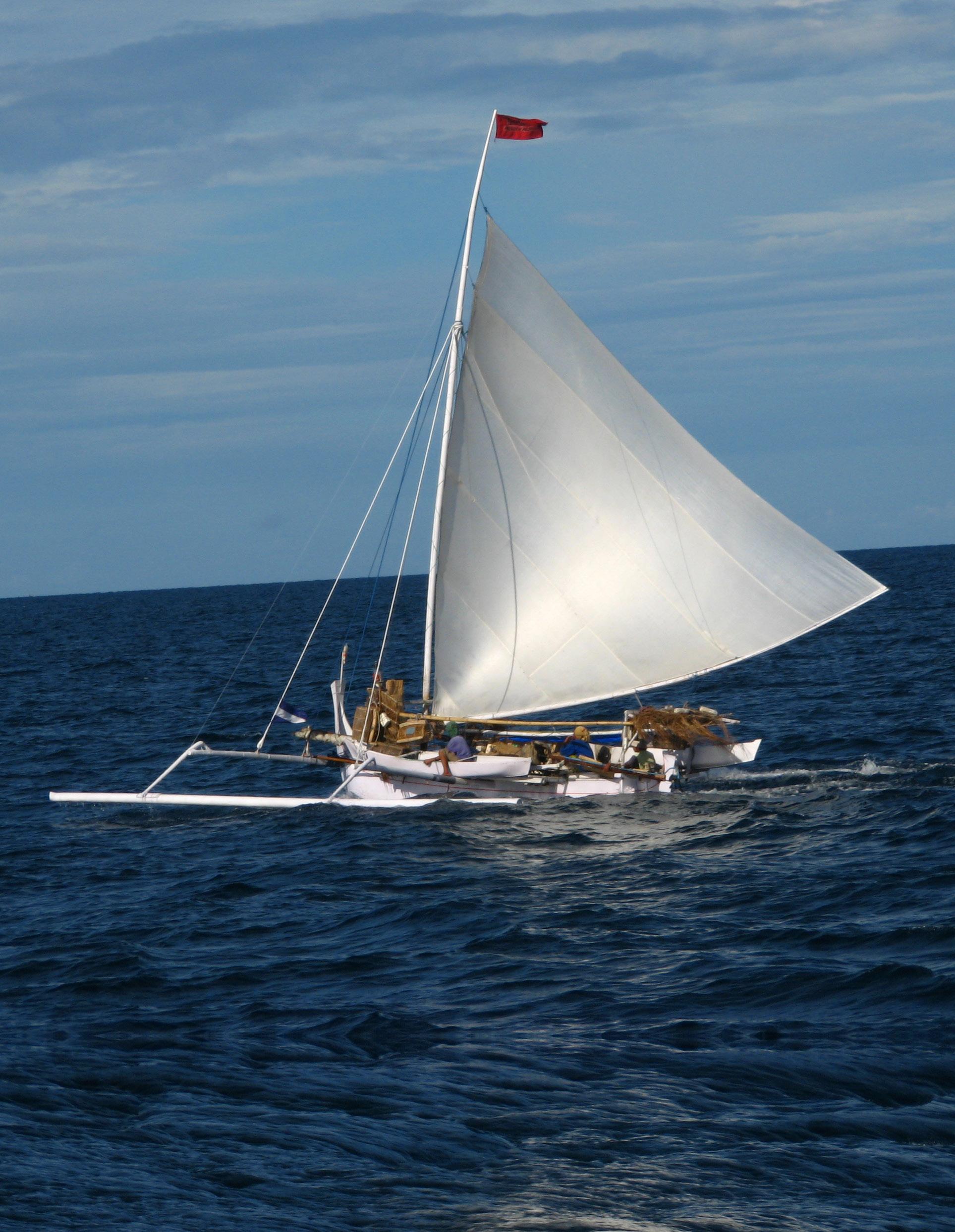
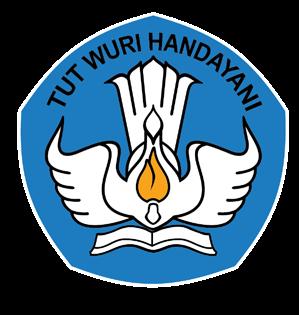
Ministry of Education, Culture, Research, and Technology Republic of Indonesia Directorate General of Culture Directorate of Culture Development and Ultilization Building E. Lt. 9, Jl. Jenderal Sudirman Kav. 4-5 Senayan, Jakarta 10270 (021) 5725534 (021) 5725534 indonesiana.diversity@gmail.com http://kebudayaan.kemdikbud.go.id NOT FOR SALE

 Muhammad Ali bin Achmad (Ali Pon)
courtesy of Zul Lubis Zul Lubis
RESTU GUNAWAN Director of Cultural Development and Utilization Directorate General of Culture
Muhammad Ali bin Achmad (Ali Pon)
courtesy of Zul Lubis Zul Lubis
RESTU GUNAWAN Director of Cultural Development and Utilization Directorate General of Culture






























 (Basuki Teguh Yuwono, Head of Surakarta Keris Museum and Lecturer at ISI Surakarta)
Purify to preserve Some of the museum Kris collections
(Basuki Teguh Yuwono, Head of Surakarta Keris Museum and Lecturer at ISI Surakarta)
Purify to preserve Some of the museum Kris collections
















 (Maya Krishna, Senior Cultural Administrator, Directorate of Cultural Development and Utilization, Ministry of Education, Culture, Research, and Technology)
(Maya Krishna, Senior Cultural Administrator, Directorate of Cultural Development and Utilization, Ministry of Education, Culture, Research, and Technology)






















 Salam Budaya
(Yayuk Sri Budi R, Associate Cultural Administrator, Head of Working Group for Cultural Development, Directorate of Cultural Development and Utilization, MoECRT)
Salam Budaya
(Yayuk Sri Budi R, Associate Cultural Administrator, Head of Working Group for Cultural Development, Directorate of Cultural Development and Utilization, MoECRT)
































 (Clockwise) Sandeq goes to State Palace; Children performing Pattuqduq Tommuane dance; Opening ceremony of Sandeq competition
(Clockwise) Sandeq goes to State Palace; Children performing Pattuqduq Tommuane dance; Opening ceremony of Sandeq competition

 (Muhammad Ridwan Alimuddin/Sandeq Researcher)
(Muhammad Ridwan Alimuddin/Sandeq Researcher)




















































 (Annisa Mardiani, Batanghari River Expedition Team Member, Directorate of Cultural Protection, Directorate General of Culture, MoECRT)
(Annisa Mardiani, Batanghari River Expedition Team Member, Directorate of Cultural Protection, Directorate General of Culture, MoECRT)

 Kasepuhan
Kasepuhan















 Photo courtesy of Zul Lubis
Photo courtesy of Zul Lubis














 Filled and decorated tampa sirih are collected at rumah adat (the village customary house)
Filled and decorated tampa sirih are collected at rumah adat (the village customary house)



 Mama adat making garlands for tampa sirih decorations
Buka Puang ritual is the culmination of the Buka Kampung ritual
Walking barefoot to a pilgrimage site from the customary house carrying tampa sirih
Mama adat making garlands for tampa sirih decorations
Buka Puang ritual is the culmination of the Buka Kampung ritual
Walking barefoot to a pilgrimage site from the customary house carrying tampa sirih




 Cakalele performance preparation
Cakalele performance preparation

